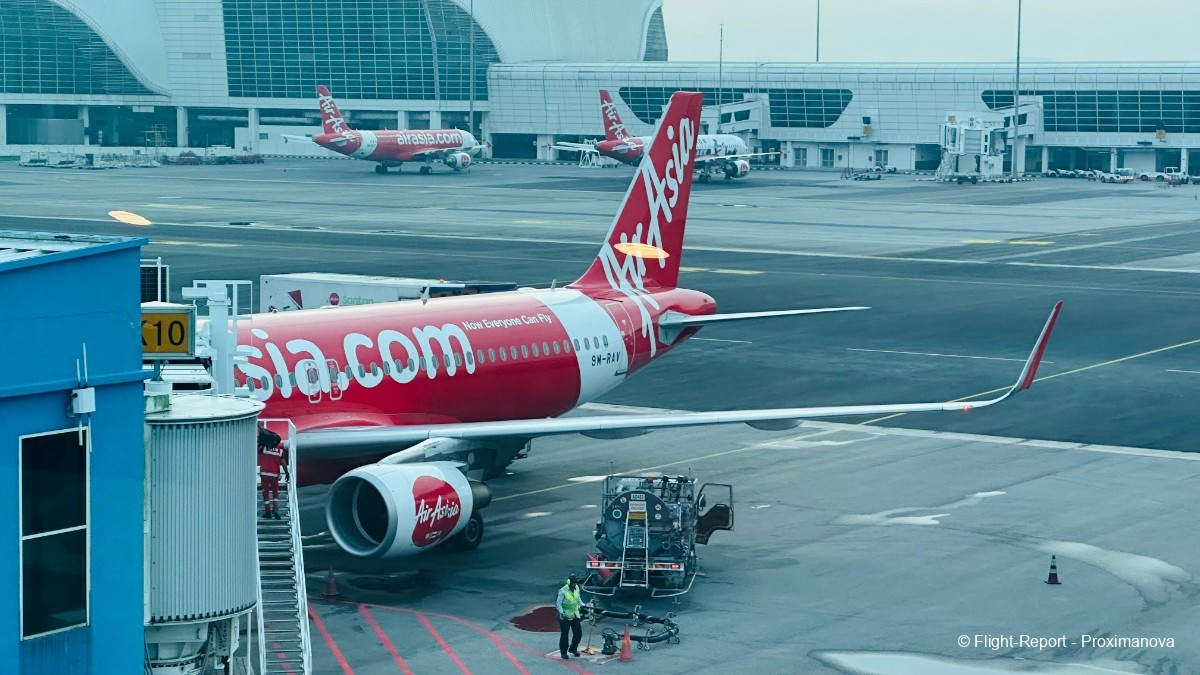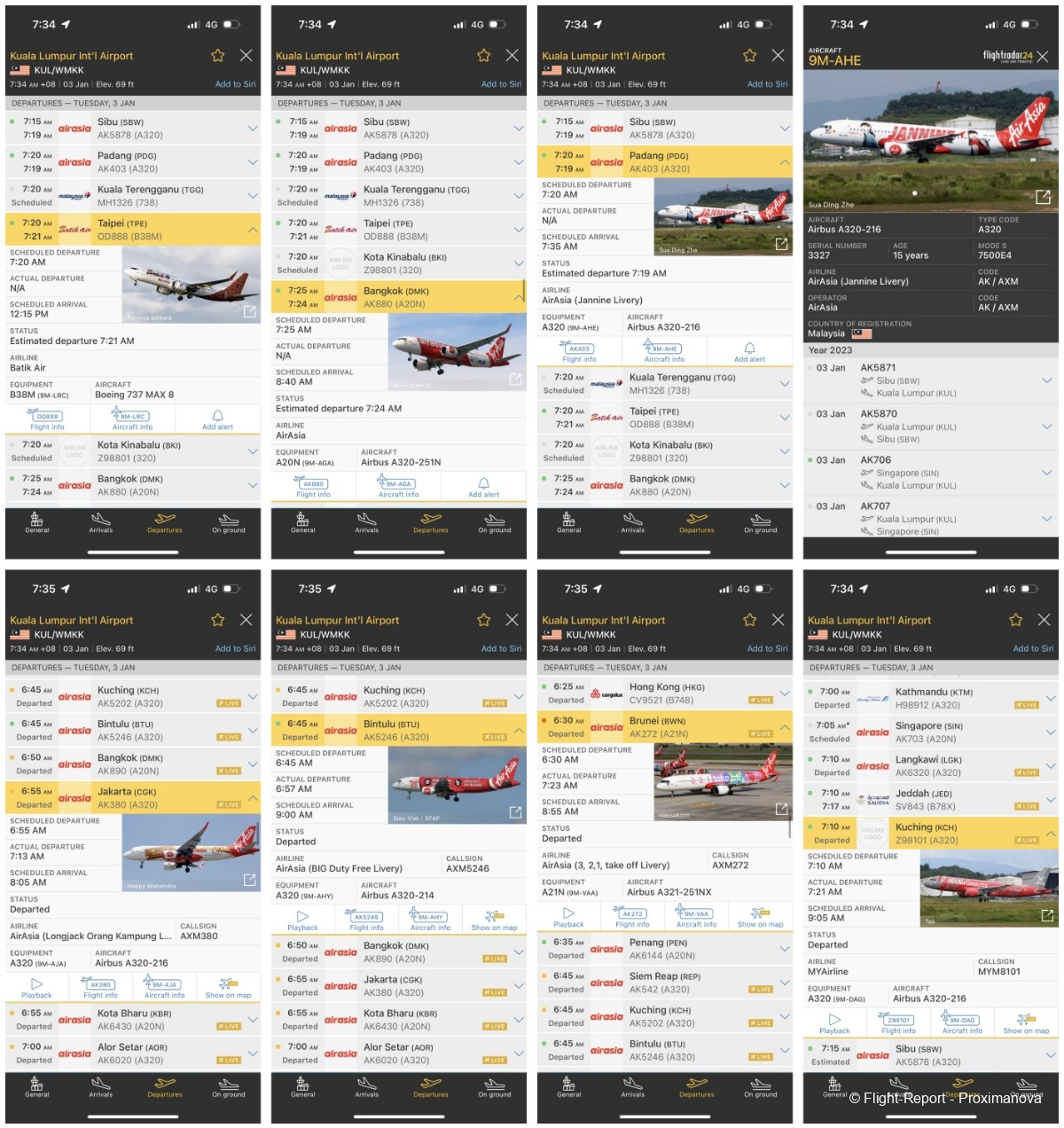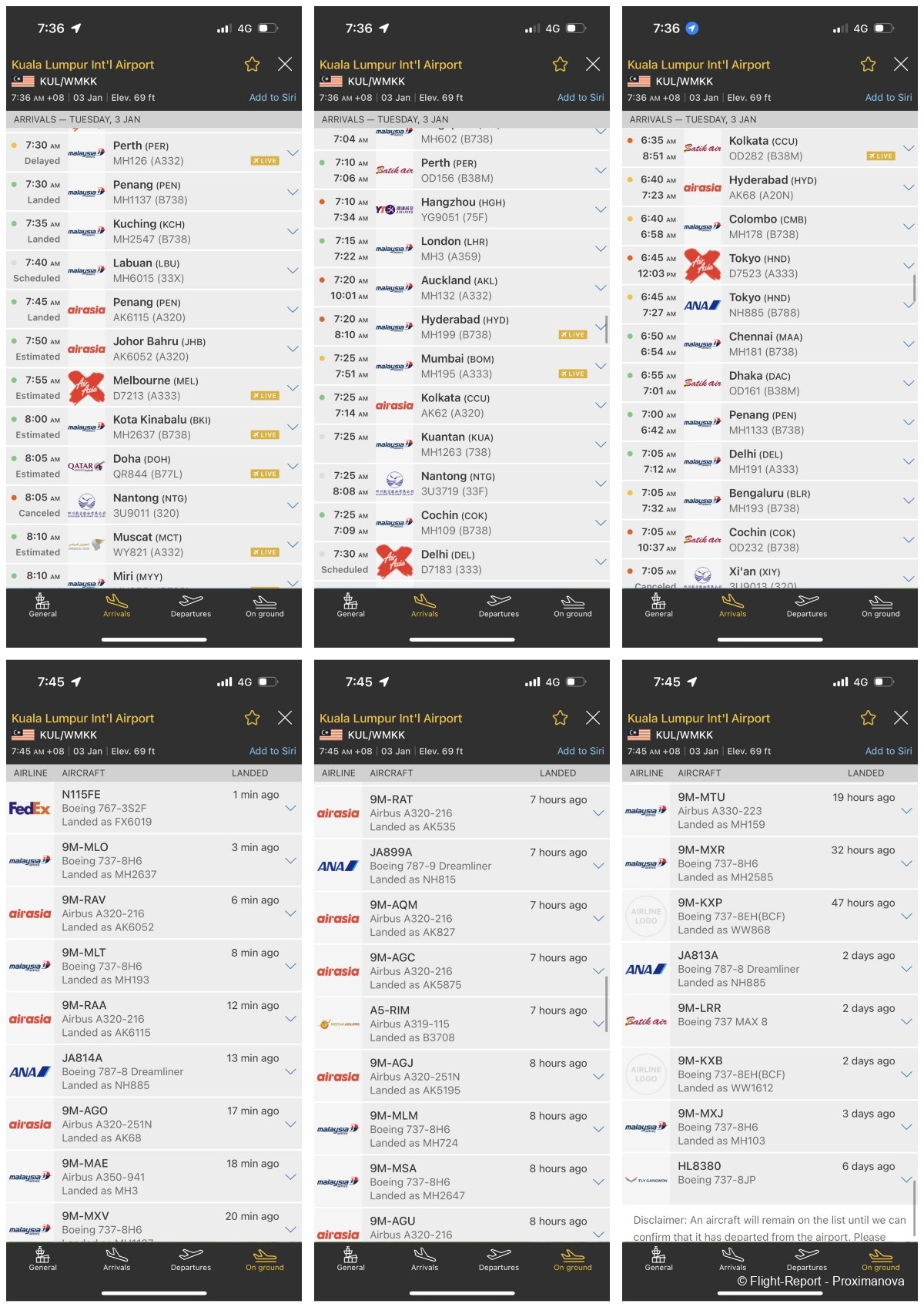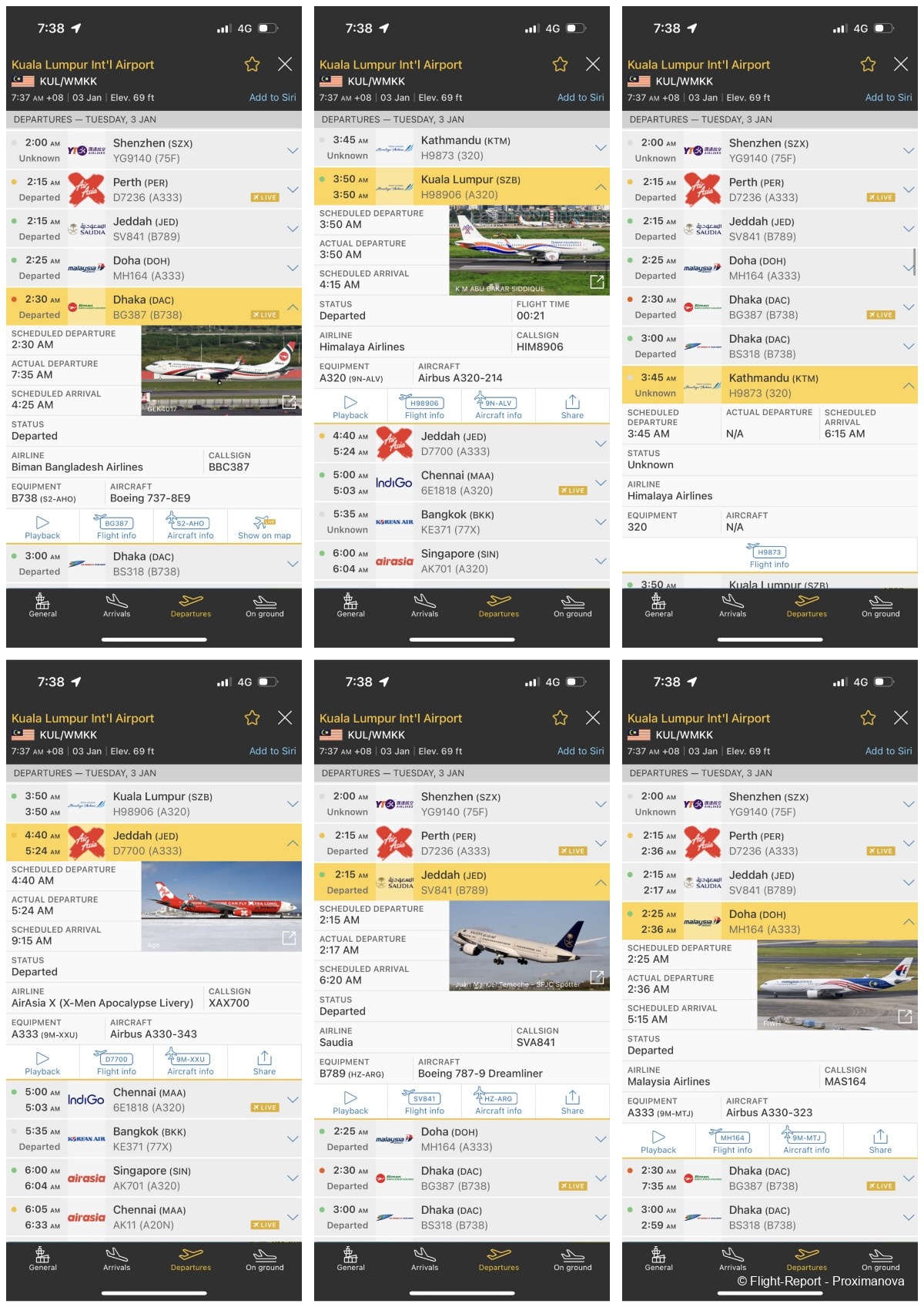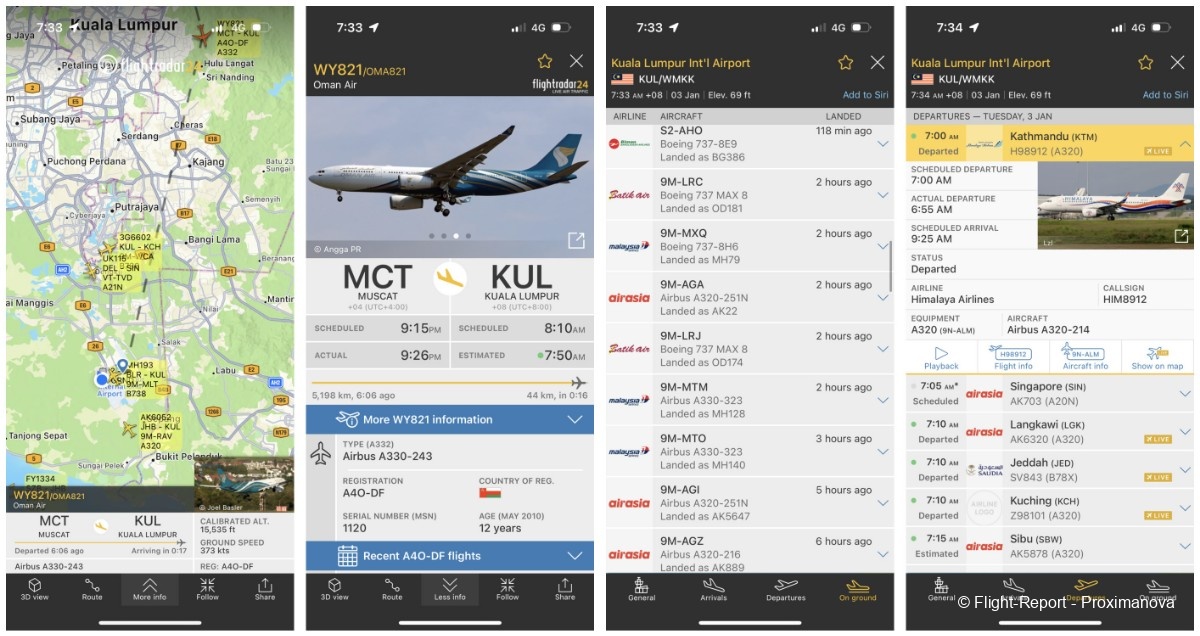Prelude: An extravagant aff’AI’r
I was always going to share my opinions on Air India’s mega-rebrand when the time came, no matter which airline I would be reviewing at the time, so this will be slightly off-topic. Please bear with me. Here goes, briefly.
I would have published this trip report on AirAsia (Malaysia) on the evening of 9 August, with a full day’s worth of writing on my hands, it being Singapore’s National Day. But the excitement over Air India’s much-touted brand and livery refresh was too much, and throughout that day and the next I was on tenterhooks, not being able to get in many words edgeways. It was only late on the evening of the 10th — almost nine years to the day after Vistara made its appearance to the world — that the big questions were finally answered: what will Air India’s new livery and logo look like? and will the Maharaja really go away?! (No, thankfully, but he will play a less prominent role than in AI’s glorious past.) Futurebrand may not have delivered a rebrand as fantastic as Etihad, Qantas or Gulf Air did in the 2010s, but it has gone one-up over its rebrands of Air Malta*, American Airlines and Fiji Airways in 2012–13, which were already extraordinary. Here’s my take, which I have tried to keep somewhat short instead of rambling.
From what I see of the new brand identity, I can only stand and loudly applaud the completely radical revolutionised approach the Tata Group has been taking with regard to both brand and product, with new premium cabins over the next few years, that will go a long way in shoring up our vilified former flag carrier and putting it on par with the very same Singapore Airlines that will be taking a stake in it. The new livery has been trashed by many, and then some — and I must agree that wordmark and logo are far too huge, blocky and Iberia-like (I’d have preferred an Aegean approach instead) — but I do appreciate the Indian cultural references in the new tail design, a most beautiful and distinctive one amidst the plain old blues and reds and oranges today. IndiGo’s colour scheme has not been particularly eye-grabbing to me, and I doubt it will ever change, so it’s just as well that its biggest competitor did — which sets the clock ticking for the end of Vistara, another premium Indian airline brand.
Most splendid of all is the new custom font AI has commissioned, which was announced at the big unveil event as ‘a refreshing change from the Helveticas and Arials out there’. While a bit too stretched — and therefore rather like Vivo’s (the Chinese phonemaker, to be clear) or Peugeot’s custom fonts — it is far above anything else in Indian aviation branding, except perhaps the exotic fonts of the erstwhile Jet Airways (Bodebeck, Foundry Form Sans) and the outgoing Vistara (Scene) which will be remembered long after those airlines have gone. It is also as distinctive as the custom fonts commissioned by LATAM Airlines and Iberia, with all the sharp angles. Still, I wish there weren’t any free fonts used, and the Nunito in the new identity is no less clichéd than the existing Montserrat. (I hate Montserrat as much as I do the ancient 1984-vintage Korean Air livery, one of my least favourites alongside China Eastern and perhaps Swiss — but in 2025 KE will have its own chance to do what AI has done now, and present its own new livery and brand after the Asiana merger!)
Time and again I have written about the Tata Group’s airlines (I5612, UK893, UK106, AI573) during my travels, but never so far have we been able to examine their fate and future in the context of Air India’s new brand. The time has finally come for the new Air India to announce itself, and in November its low-cost subsidiary Air India Express, after merging with AirAsia India, will have its own turn in the sun and reveal its new brand. In December, AI’s first A350 will emerge from the paintshop, being the first plane to feature this ambitious and revolutionary new livery. I can’t wait for that parting present, which will conclude 2023 with the same fervour and excitement as my AirAsia India and Vistara flights rounded off 2022!
*Note: In previous reports I had mistakenly stated that Avianca’s brand overhaul in 2013 was also done by Futurebrand, whereas in fact it was by Lippincott — though Futurebrand did rebrand Avianca way back in 2005. Moreover, Futurebrand’s refresh of Air Malta in 2012 (the same year as Fiji Airways) completely missed my attention. I have corrected the error in my previous mentions of Air India’s rebrand, and replaced Avianca with Air Malta.
Introduction: From far-South to Far-South
Let’s return to where we left off, at the moment when I had landed in Hyderabad — near the centre of India but still very much ‘South’ — to celebrate ’2022 ka The End’, as one might say in Hindi. This is the fifth leg of my ‘Hexagon’ flights across Southern India and Southeast Asia for the Christmas 2022/New Year 2023 break. With all the big boxes ticked — the Singapore A350 Regional, the Thai 787-9 and my first flights on AirAsia India and Vistara (in the former’s case, my only flight) — the time had come for me and the world to put 2022, marked by the Ukraine invasion, to rest. This and the next flight, my first ones of 2023, will be on AirAsia (Malaysia): my first time on them since 2013 — which was my first foreign trip, to Singapore via Kuala Lumpur — and also my first time visiting KLIA2, since my transit in 2013 was via the Low-Cost Carrier Terminal (LCCT) that was rightly demolished the following year.
While many around the world would be partying all they could on the final Saturday evening, I preferred to snuggle into bed in a cheap and slightly in-need-of-repair but otherwise decent little hotel in Secunderabad (north of the Hussain Sagar Lake), watching the ball drop on the Times Square and the fireworks light up the #SydNYE sky over the Opera House. The new year ushered in new postpandemic hope, which sadly did not take much time to be shattered: before long came the Yeti Airlines crash in Nepal in January that killed all 72 on board; the Turkey–Syria earthquake in February that left over 50,000 dead and countless others homeless and broken; and later the rail disaster in Odisha, in eastern India, in June where nearly 300 perished. Then again, which year is free of suffering and sadness?
At least one good thing to have emerged from 2023 is that the COVID-19 pandemic finally seems to be behind us — or, at least, is no longer the global emergency it used to be three or even two years back, like when the Tokyo Olympics were held in 2021. Travellers and airlines have certainly made the most of the removal of almost all travel restrictions that were in place all these years. However, no sooner had 2023 started than the Indian government infuriatingly re-imposed compulsory RT-PCR testing for all arrivals from not only China and Hong Kong but also Singapore, Thailand, South Korea and Japan, for fear of a COVID explosion in China, as the world’s most COVID-stringent country ripped open the Band-Aid and abruptly scrapped all its zero-COVID policies. Mercifully, this ridiculous edict was scrapped a little over a month later, on 13 February, around the same time as Singapore eliminated the need for masks on public transport. Ever since, all my flights have been very much as they were pre-2020, and I trust such has been the case for everyone’s travels all across the globe.
Whatever be the owner — Tata or Capital A — AirAsia doesn’t disappoint
I had always planned for the return from Hyderabad to be on AirAsia (AK) as not only is their baggage allowance quite generous (20 kg for starters, with more purchasable) but their selection of hot meals is truly enviable, and in fact up to two hot meals can be chosen per sector. I made the fullest use of this during the booking process, by pre-ordering the Bukhara Chicken Biryani and AK’s legendary Uncle Chin’s Chicken Rice for the HYD–KUL sector — a flight between two airports located a long way south of the city — and a Chicken & Cheese Sandwich and Thai Basil Chicken with Rice for the short hop to Changi. But what struck me the most once on board the plane was the fact that AK had Wi-Fi, and actually has had it for quite some time! This A320neo, 9M-AGO — one of the first A320neos ever built, dating back to 2015 as an Airbus testbed — had the full-fledged airasia wifi+ available, while some other planes have a more pared-down airasia wifi lite offering with only streaming entertainment but no actual Wi-Fi.
Through the Wi-Fi portal, there were plenty of free entertainment options — though they were rather useless to Indians, being overwhelmingly Malaysia-centric — in addition to paid Wi-Fi plans, meals and shopping items for purchase. Admittedly, though, 10 or 20 MB is rather useless, with the so-called ‘unlimited’ plan being the only worthwhile one, but even that gets throttled after 200 MB to a measly 128 kbps — still, better than nothing! However, my attempts to purchase a plan went in vain, as the system could not accept my debit card — though Malaysian payment methods like BigPay might have worked — making it useless for me. Nevertheless, there was even the ability to track my own flight and see the elapsed duration, almost like a lite version of Flightradar24, which I had never in my wildest dreams imagined would be possible on a low-cost carrier.
For most Indians, for whom IndiGo is usually the only low-cost carrier they fly on with any regularity, the presence of Wi-Fi on an LCC is simply unimaginable. 6E celebrated its 17th birthday on 4 August, but for it to really become an ‘adult’ by the time it turns 18, it must seriously look into possible cost centres like Wi-Fi and basic streaming entertainment, as so many LCCs the world over, including AIX Connect AirAsia India, provide. This is even truer with Air India being its only big competitor, all while Akasa — which also celebrated its birthday recently, turning one on 7 August — grows and SpiceJet (which planned for Wi-Fi but hasn’t followed through) shrinks. The more IndiGo has become a dominator, the less, I feel, its product has innovated — and I also think it has lost much of its sense of humour which it had until the mid-2010s. It’s sad that we have to hope for other airlines in the country to try to add amenities and services when the biggest one won’t.
With its hot meals and Wi-Fi, AirAsia — including its now-unrelated Indian namesake — seems a step closer to Norwegian or, heck, even Spirit with their superior low-cost offerings, making IndiGo look more like a bare-bones Ryanair or (as I flew the other day) Jetstar in comparison. A big bonus for AK, and a huge minus for 6E. I do hope that someone among the current crop of Indian LCCs, be it Akasa Air or the post-merger Air India Express, considers at least adding a free entertainment portal (like the outgoing AirAsia India’s exemplary AirFlix system) if not Wi-Fi. When even the much-maligned Spirit Airlines in the US is able to provide Wi-Fi across much of its fleet, not to mention the better-ranked AirAsia close by, what stops Indian ones from doing so? With the massive top-to-bottom rebrand of Air India on 10 August, at least one of them is thinking in the right direction, all the more so since sibling Vistara is the only Indian airline with Wi-Fi, and this will continue once the merger between the two is complete. There may be a lot of catching up to do, but there definitely is progress in the right direction as far as Air(Asia) India is concerned. If only this could also be said for IndiGo and co.!
Flight routing
- 1
- 2
- 3
- 4
- 5AK68 | Hyderabad to Kuala Lumpur | 3 January 2023 | A320neo | 9M-AGO
- 6
Pre-departure
Back in the middle of November I had chosen my return flights to Singapore, as well as the meals I could have on each sector, as described above.
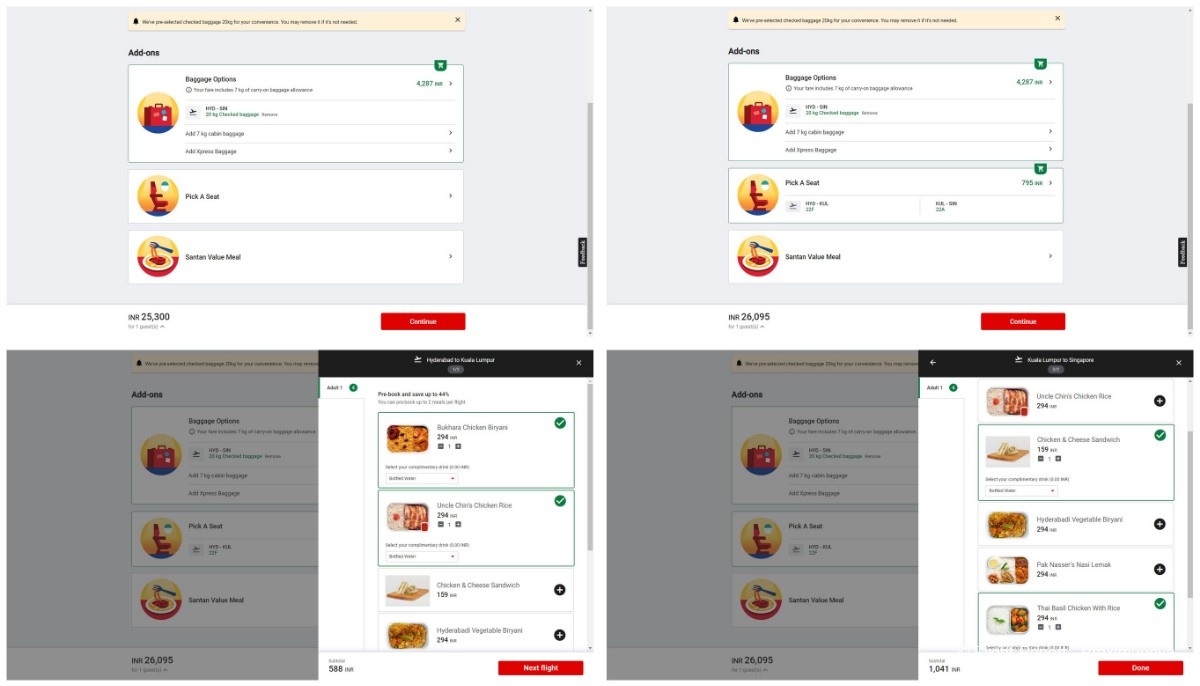
However, before leaving Bengaluru on 30 December, I was concerned that I might make it a bit too late for the first day of work, as the Singapore flight landed at 9:30am. So I tried my luck with trying to change the date to a day earlier, on Sunday night. The only way was the Ava chatbot (short for AirAsia Virtual Allstar) — there being no helpline or other support channel for Indian passengers — but there was no way I could get ‘her’ to process my request. Apparently date-changes could only be done for single sectors, not one-stop routings. Oh, well!
Apparently AirAsia was only too aware of ‘her’ shortcomings — with no way to connect to a human in many cases, as was painfully evident in the initial days of the pandemic with millions of refund requests — to the extent that a month later it ‘fired’ ‘her’ and introduced a new AI-driven solution, Bo, named after Bo Lingam, AirAsia’s Group CEO. For the record, Ava’s equivalent chatbot at AirAsia India is called Tia, and ‘she’ may or may not be carried over to Air India Express after the merger between the two is complete.
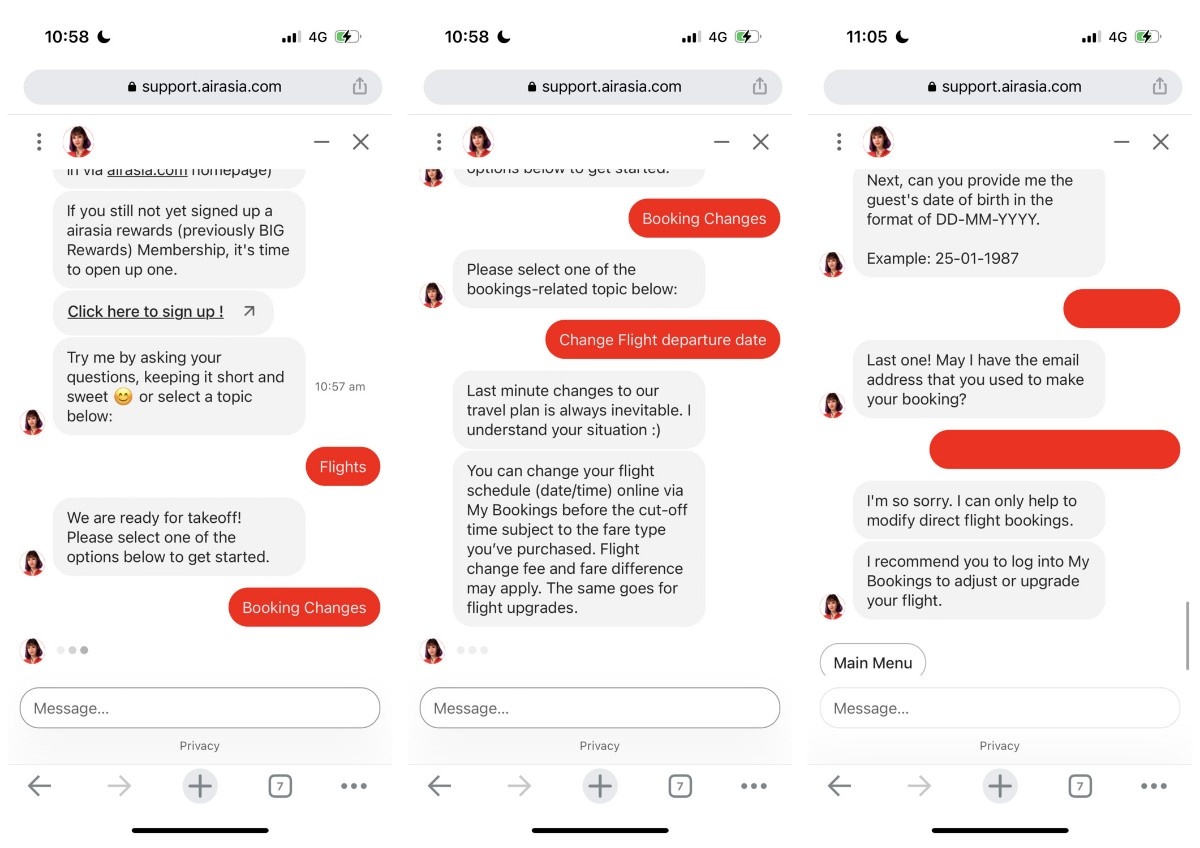
For the record, this was one of the ads I saw at some point, and I can only breathe a sigh of relief that this was a real girl and not the ‘Miss Ava’ virtual influencer on Instagram — which AirAsia had introduced in 2020, with the onset of the pandemic, only to mercifully retire ‘her’ in July 2022. For the life of me I can’t understand such social-media fads, and I am glad I spend most of my time online doing ‘productive’ stuff like writing trip reports like this one, instead of plummeting down the Instagram rabbit hole!

Evening of departure
Monday, 2 January. New Year’s Day was a particularly sedate Sunday, as I had barely stepped out of the hotel in Secunderabad, preferring to roam around the neighbourhood instead of venturing to attractions like the Hussain Sagar Lake or the Falaknuma Palace, having seen them in childhood. I had no wish to repeat the exertion and excitement of the final day of 2022, though I wouldn’t have ended the year any other way. Monday, too, would pass by mostly buying gifts and snacks to take for my office colleagues from sweet-sellers like G. Pulla Reddy, and by half-past six in the evening I would get started for the airport.
(On New Year’s Eve I had gone all the way to Raidurg in the northwestern corner of Hyderabad — home to India’s first IKEA and the country’s self-proclaimed largest mall, Sarath City Capital Mall — and barely managed to return to the hotel in time to wrap up the year’s proceedings. The traffic had made it nearly impossible without half-a-dozen Olas and Ubers cancelling on me, so I had no option but to go to Raidurg metro station (the western terminus, from where a direct airport link is being constructed) and chug on to Paradise station, and only after a few ‘can’t-see-you’ calls by the Ola driver did I make it home. For the record, I consider the three-line Hyderabad metro to be the best-designed in the country in terms of train design and also fonts.)
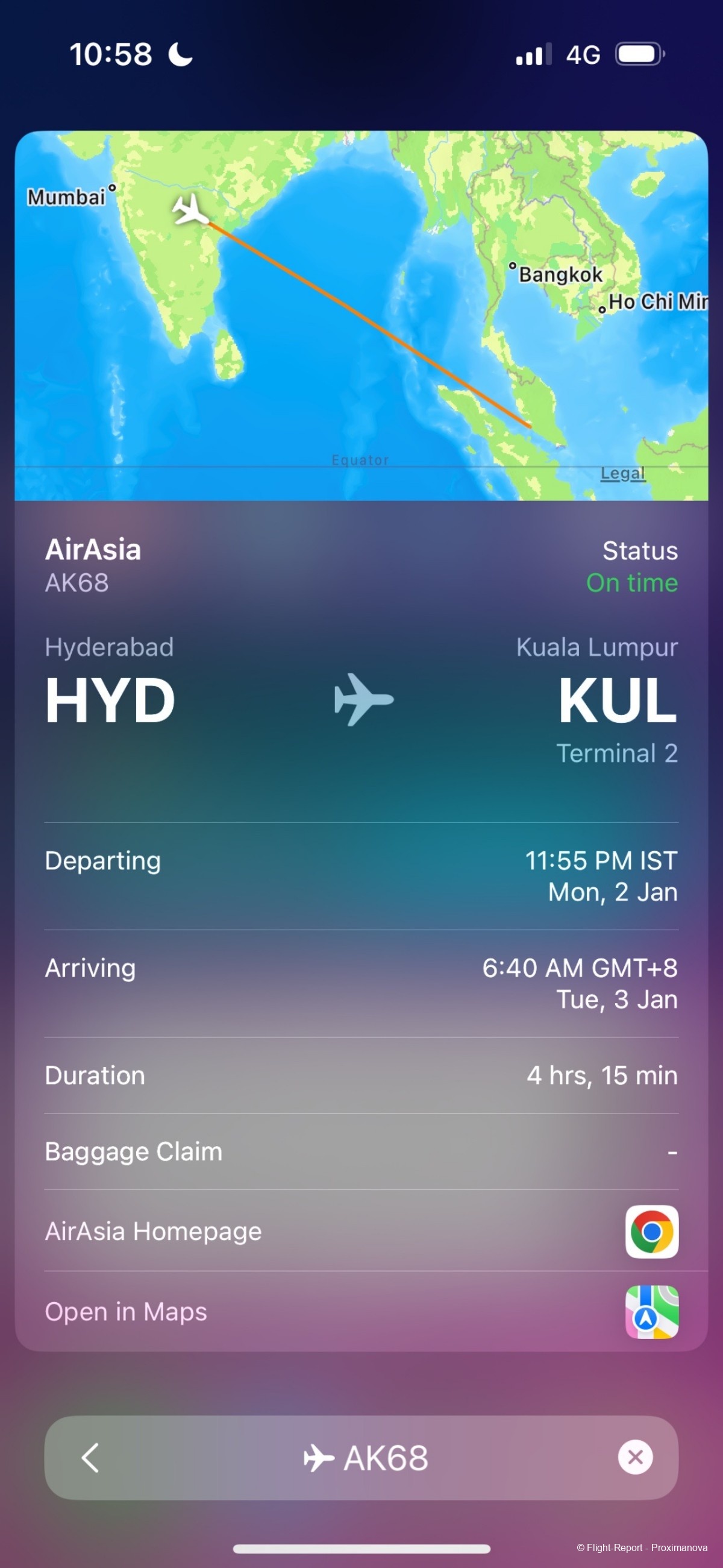
It was well past sundown when, at seven-ish, I had made it out of the hotel with the same driver who had dropped me there three nights ago. The sights, scapes and sounds of the metropolis — a unique cross between North and South India, between Mughal and Telugu culture, which I had barely seen in my life — presented themselves.
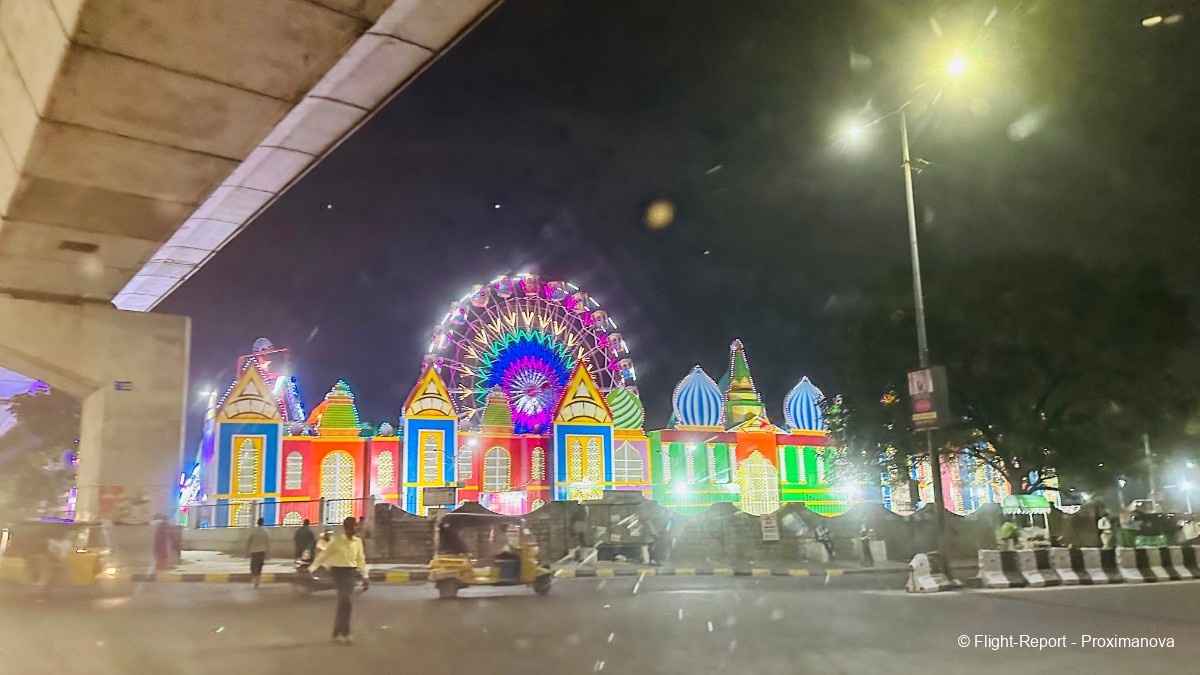
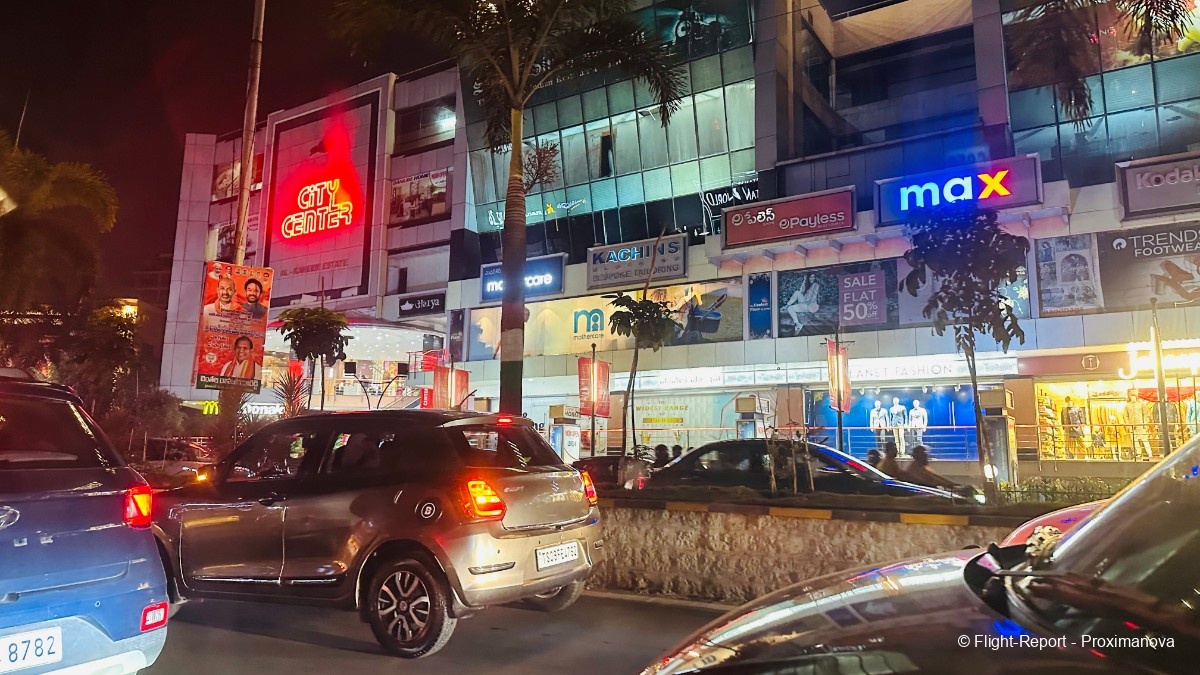
Here a hoarding, there a boutique, and everywhere the honking of bumper-to-bumper traffic.
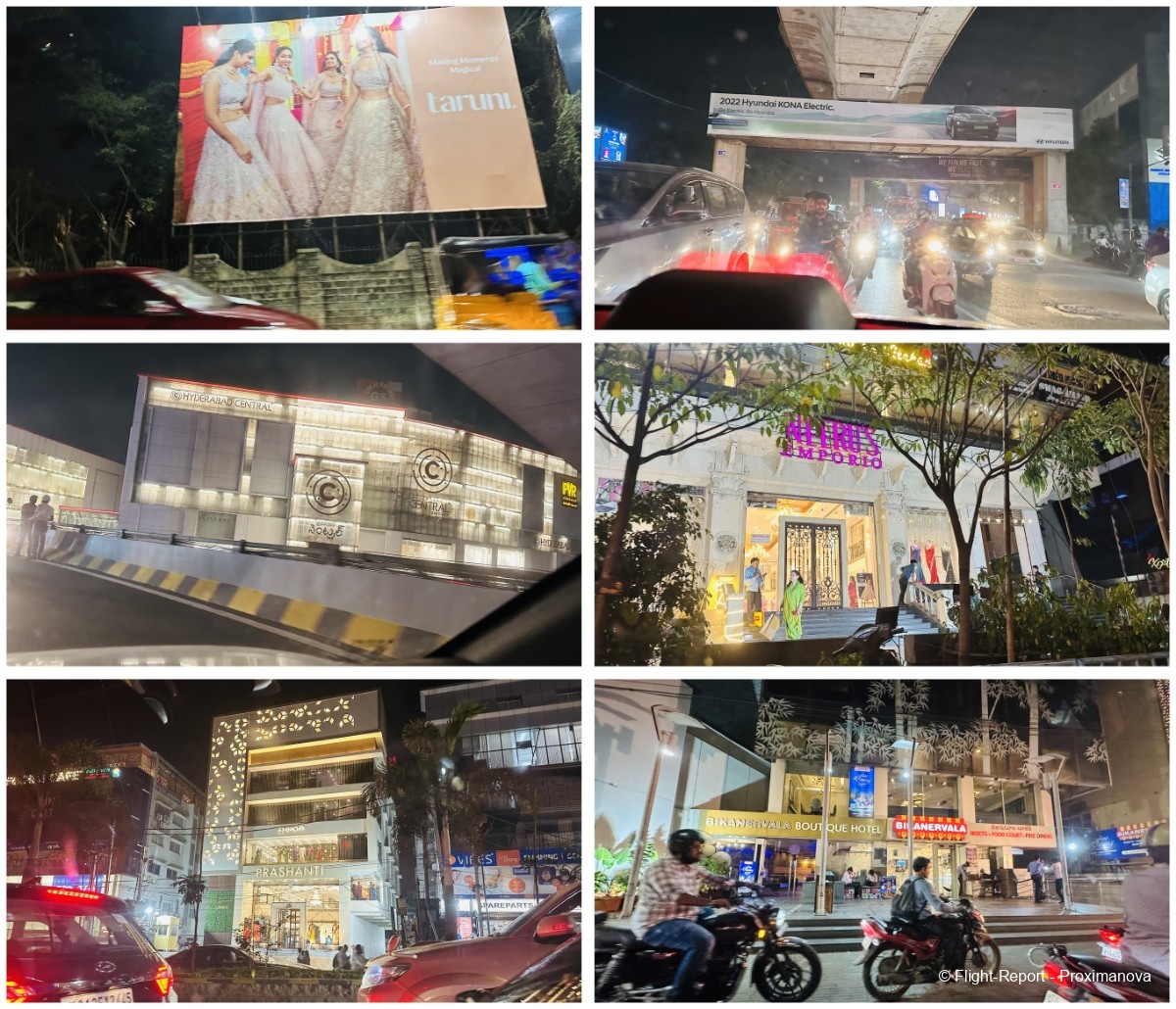
The further down we went — out of the busy shopping streets and into the expressway — the faster the shopping centres and function halls whizzed past us, much like they do in KL, my stopover destination, where the airport is much further south.
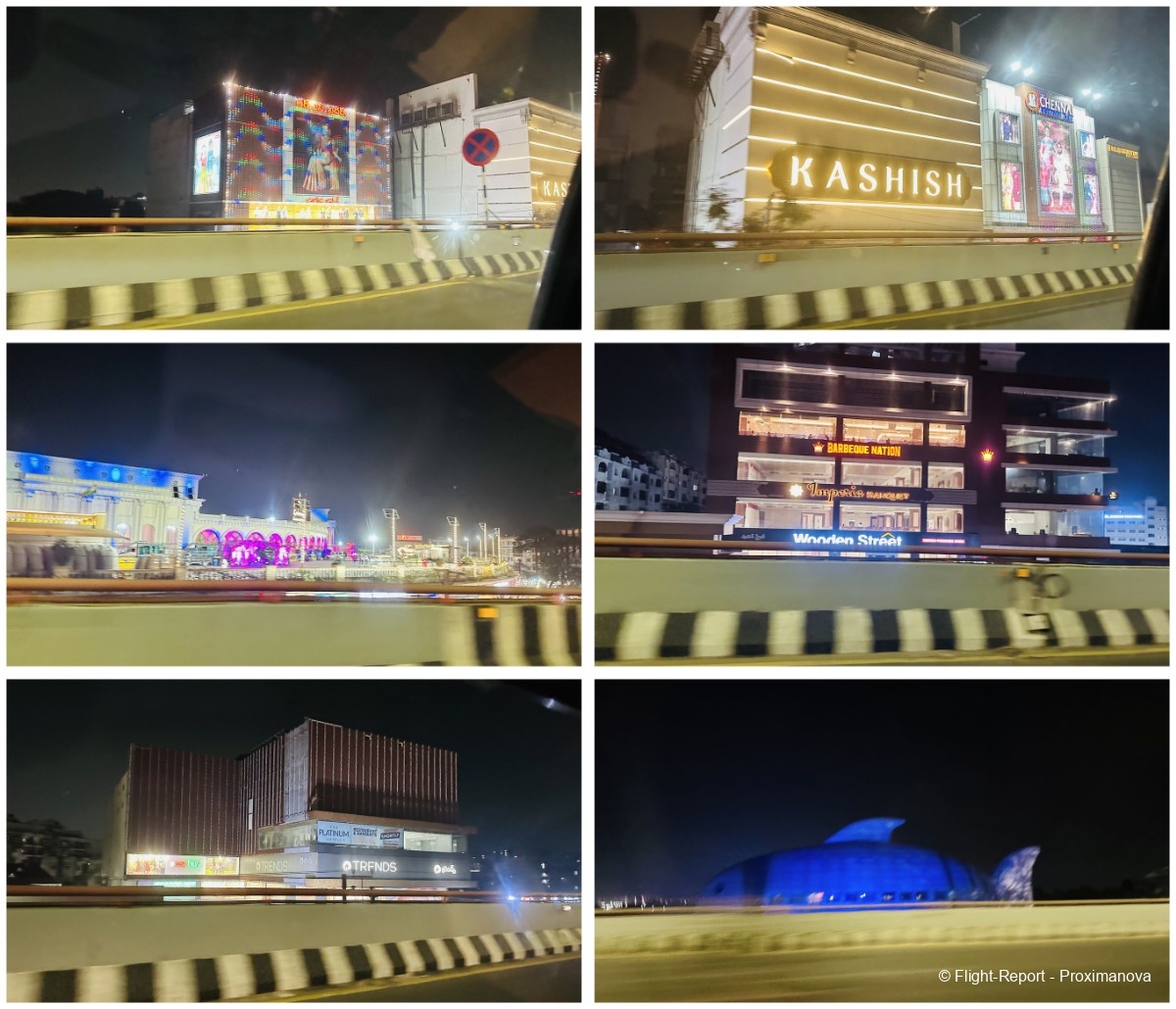
In an hour or so, the left–right arrows of Rajiv Gandhi International Airport’s logo (in the centre in the below picture) heralded my exit from city and country alike. (Delhi’s Indira Gandhi Airport has exactly the same logo, but RGIA has a secondary logo without the full name that reads simply ‘GMR HYD Airport’.)
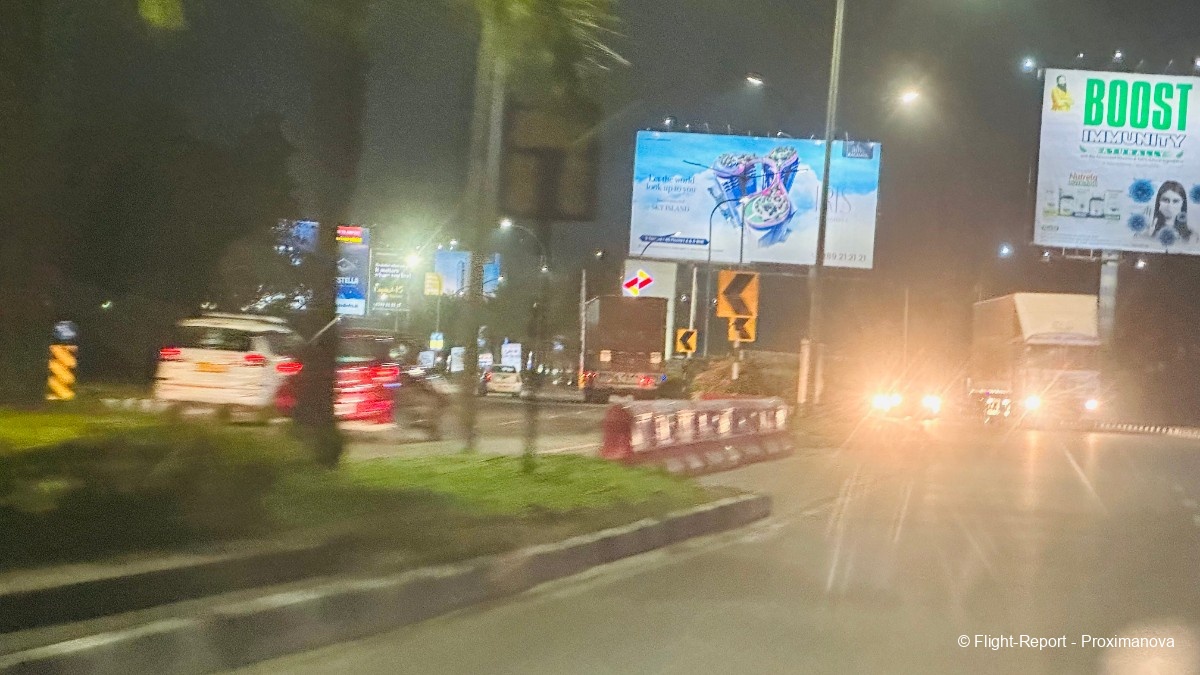
Two big signs for Havells, a big Indian electricals brand, and its consumer-electronics subsidiary Lloyd welcomed me.

Signs and decorations saying ‘Merry Christmas’ and ‘Happy New Year’ lit up the surroundings better than any banner could.
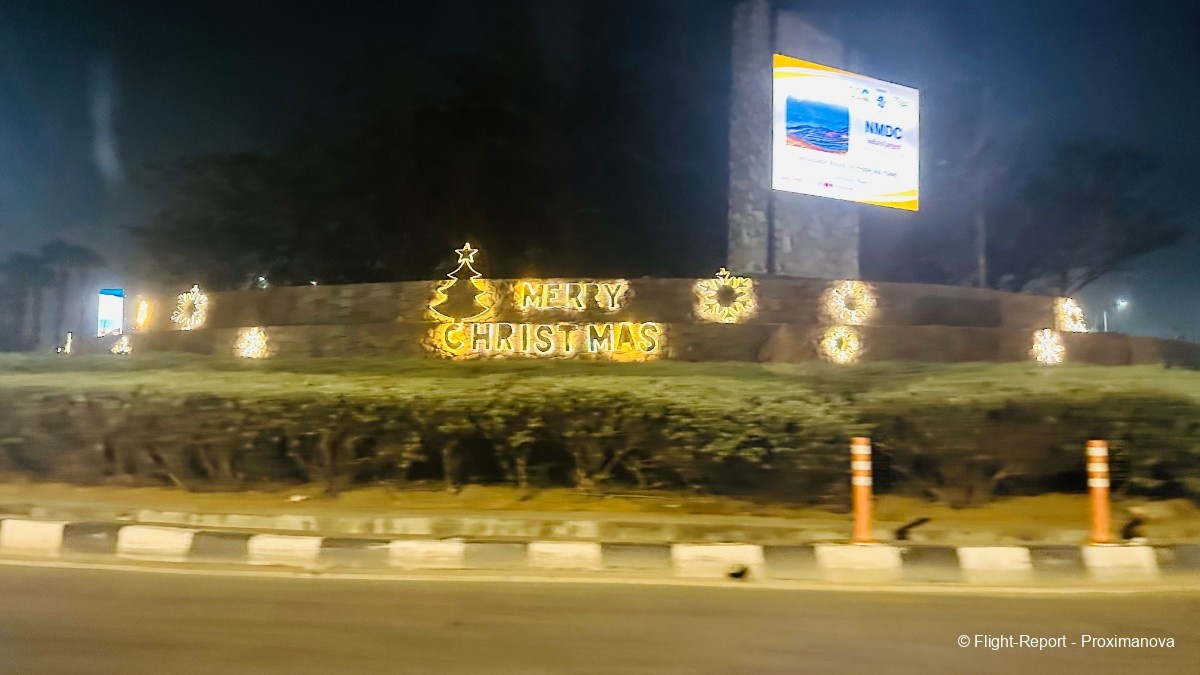
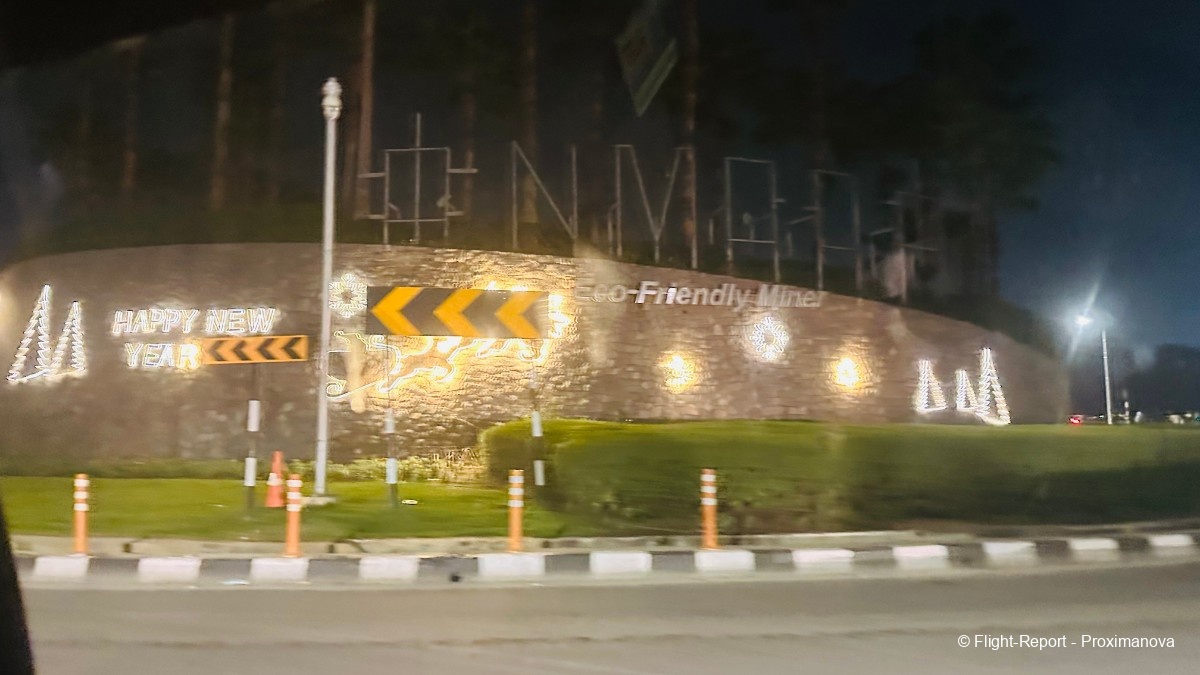
The aircraft for tonight, my first of 2023, had just departed from KUL, and her registration was 9M-AGO. All that’s missing is the letter N in the middle, and then the name turns into a certain tropical fruit, and also the now-defunct low-cost subsidiary of South African Airways (currently the smallest member of the Star Alliance!).
Little did I know then that this was the fourth A320neo ever built, dating back to 2015 — before Lufthansa became its launch customer the next year — as Airbus used her as a testbed (D-AVVB) before AirAsia took delivery in December 2017.
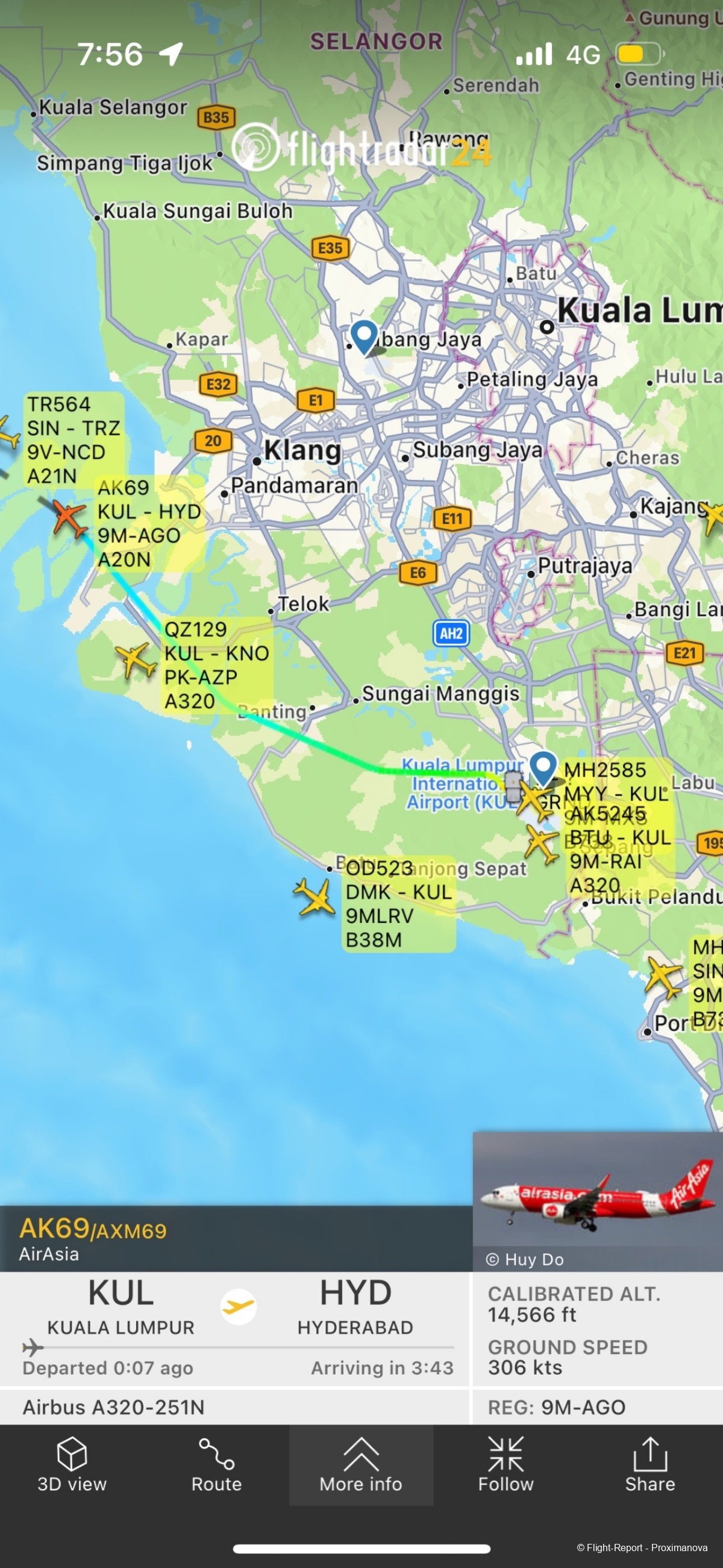
Some OnePlus phone or the other was being launched, an ad for which was placed near the entrance to RGIA.
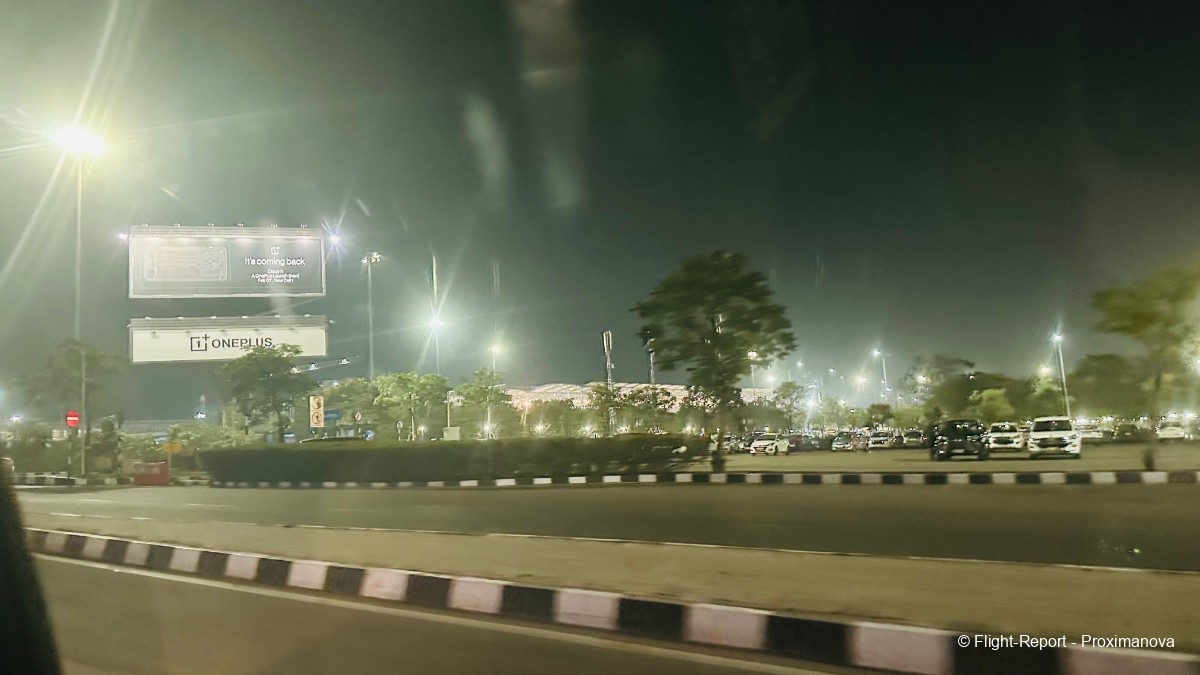
At eight we had reached India’s largest Far-South-of-the-City airport, and so began my journey to the equivalent in Southeast Asia.
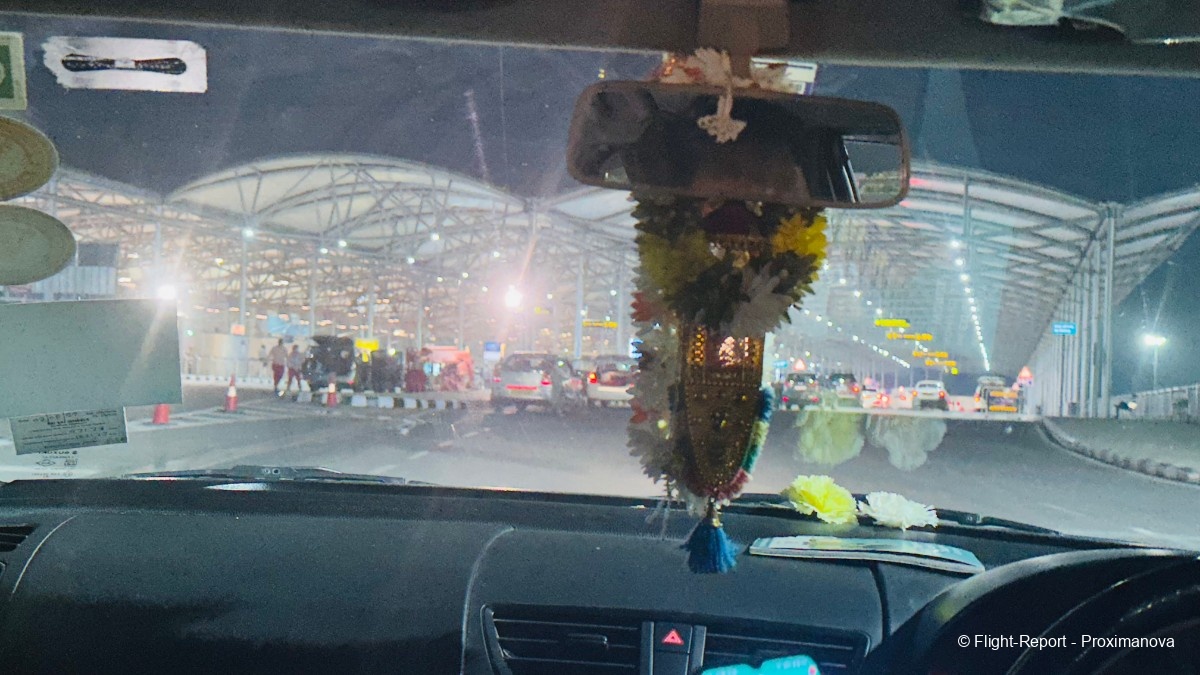
VFRs (visiting friends and relatives) forms a big portion of Indian travel, and it was no different at HYD with people turning up in the hundreds to see off their loved ones.
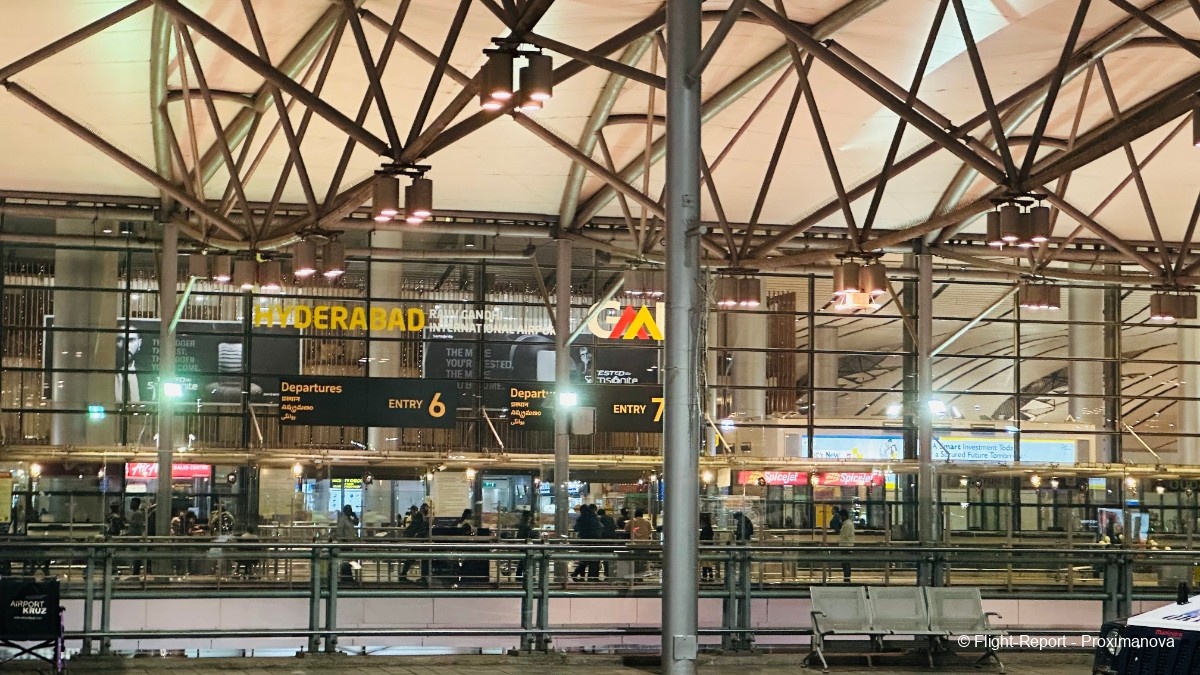
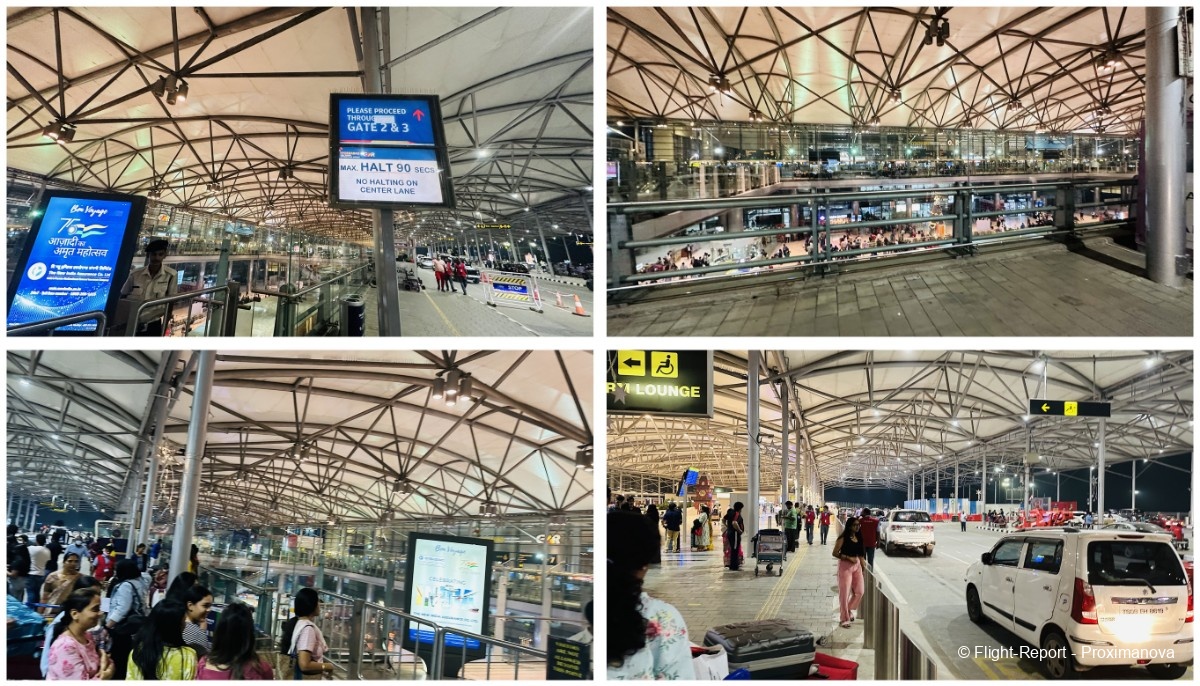
At the security-manned entrance was a cutout of Prime Minister Narendra Modi to promote the G20 summit, which will be hosted in New Delhi in September 2023, after India assumed the G20 presidency in December 2022.
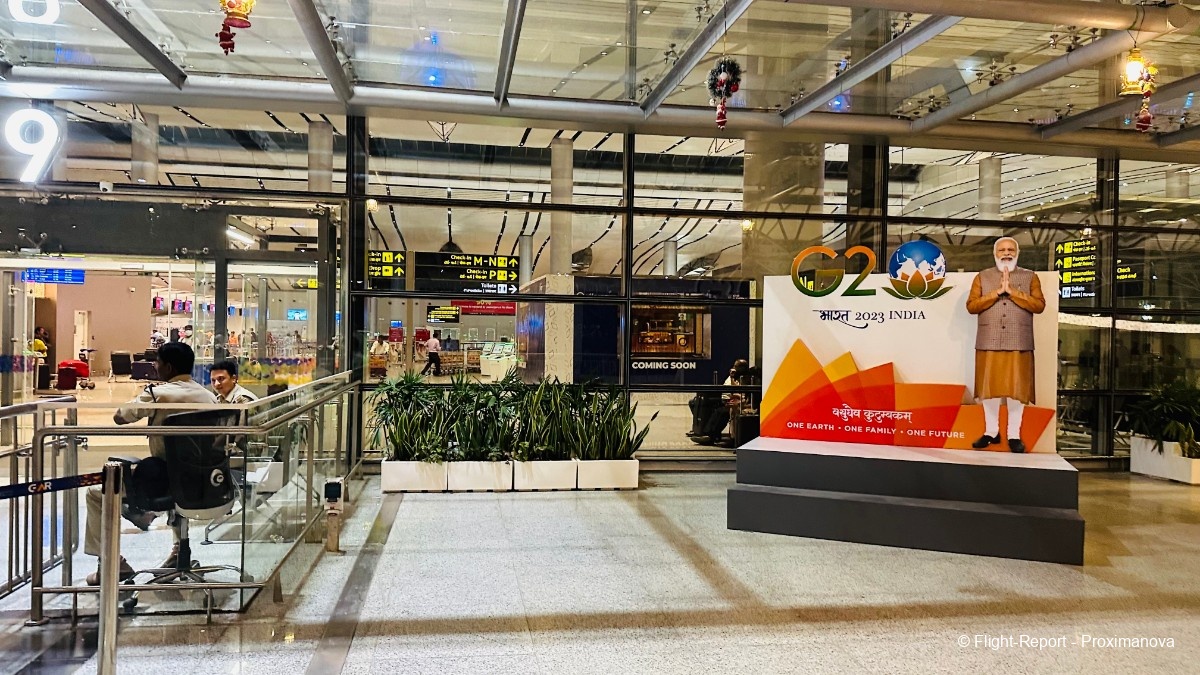
The check-in counters were exactly what you would expect from a glitzy modern airport, and were a treat to behold. I particularly liked the signage font, which was a breath of fresh air and such a welcome relief from the Helveticas and Frutigers so many foreign airports see to prefer — including BLR T2 not far away. For the record, Hyderabad shifted all international flights back to the single terminal on 28 November 2022, resulting in the decommissioning of the interim international departure terminal.
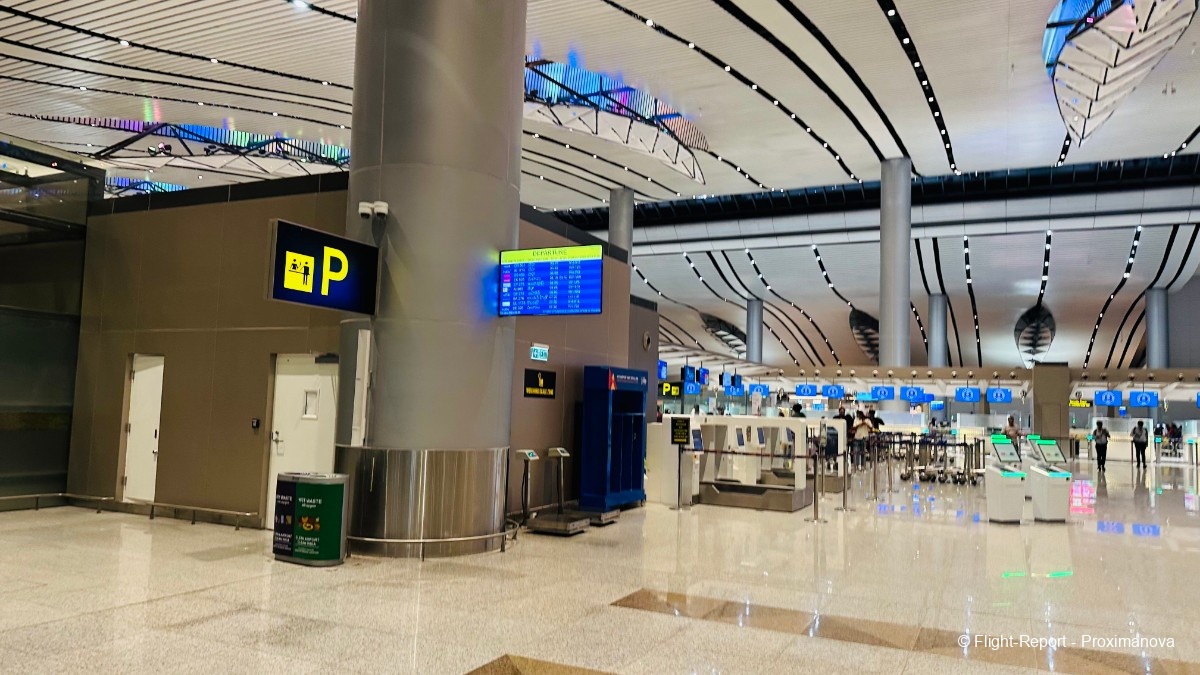
Next to AK68, SQ523 had commenced check-in. Singapore Airlines’ Hyderabad flight is operated by the A350 Regional from Thursday to Sunday and the 737 MAX from Monday (like today) to Wednesday. Kolkata, a major city in the east of the country, got only 737 MAXes until the summer schedule started in March, after which it got a slightly similar schedule as HYD but rather different: 3x A350 from Saturday to Monday and 4x 737 MAX from Tuesday to Friday.
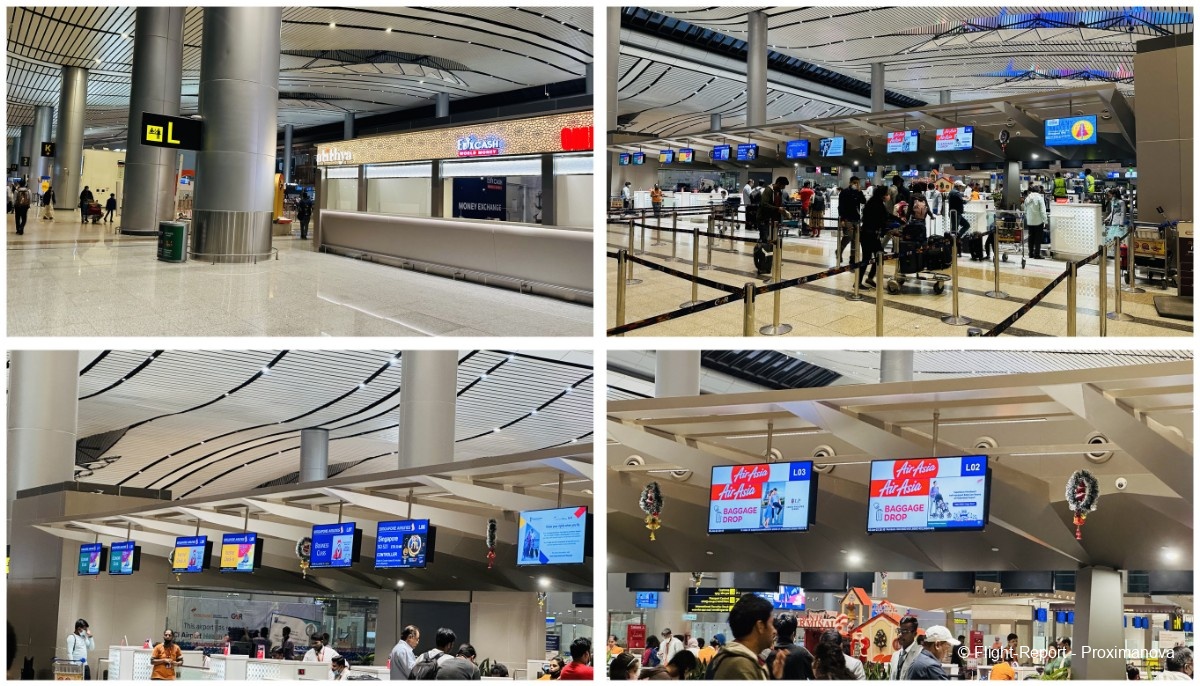
I was issued my boarding passes for both flights, along with my baggge being checked in all the way to Singapore.
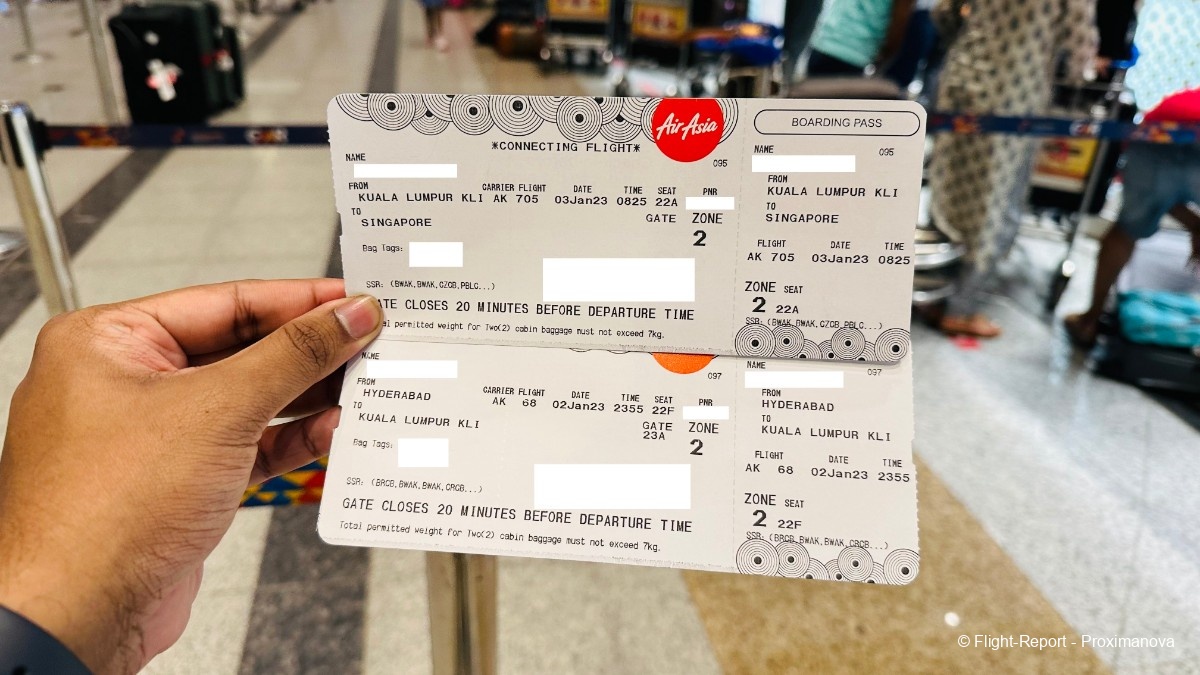
Children stepped into the ‘Santa Terminal’ decoration that was placed after the check-in counters. These girls posed in front of the candy canes and Christmas trees as their mom took their picture in front of Mr Ho-ho-ho himself.

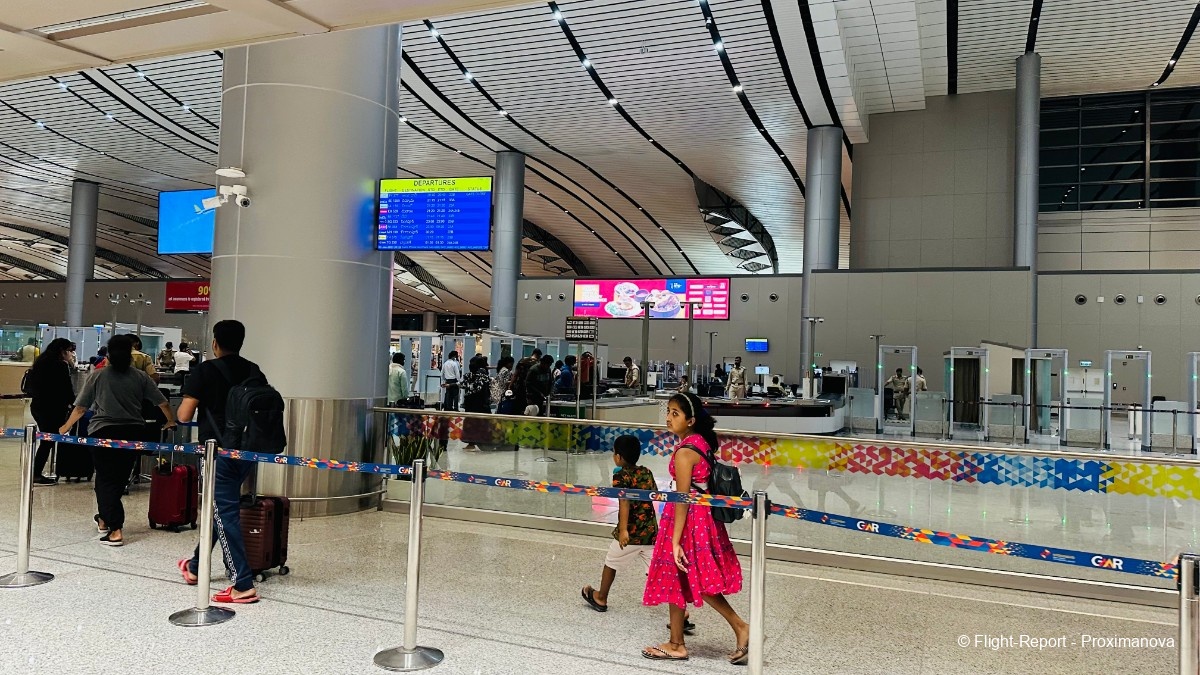
RRR: Retail, Relay-xation and Recreation
Okay, there was no Relay bookstore in this particular terminal, unlike at Kempegowda, but there was definitely a WHSmith — which I don’t think I ever forget to mention when talking about Indian airports, along with the global Oscar-winning blockbuster RRR, a proud product of Hyderabad. So here goes.
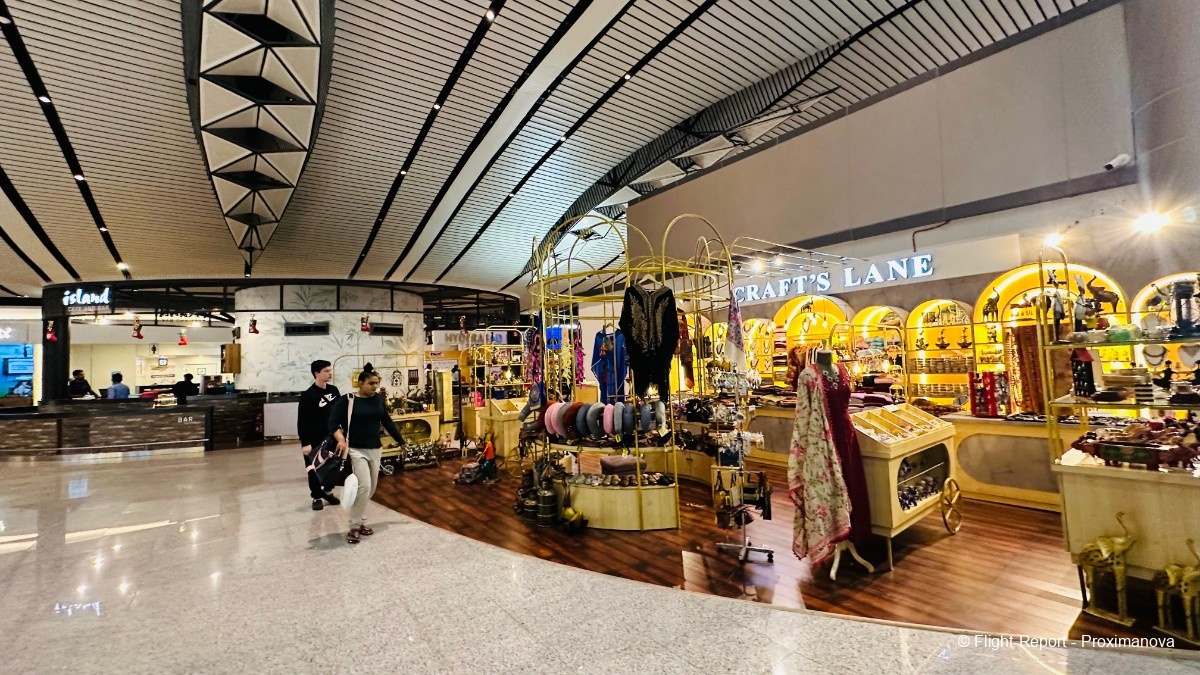
Among the glittering boutiques was a particularly large setup for Kama Ayurveda, with a sign for ‘Holiday HYDration’ (sorry, could not resist inserting HYD pun there) at the entrance along with videos of girls swirling their thick tresses on loop.
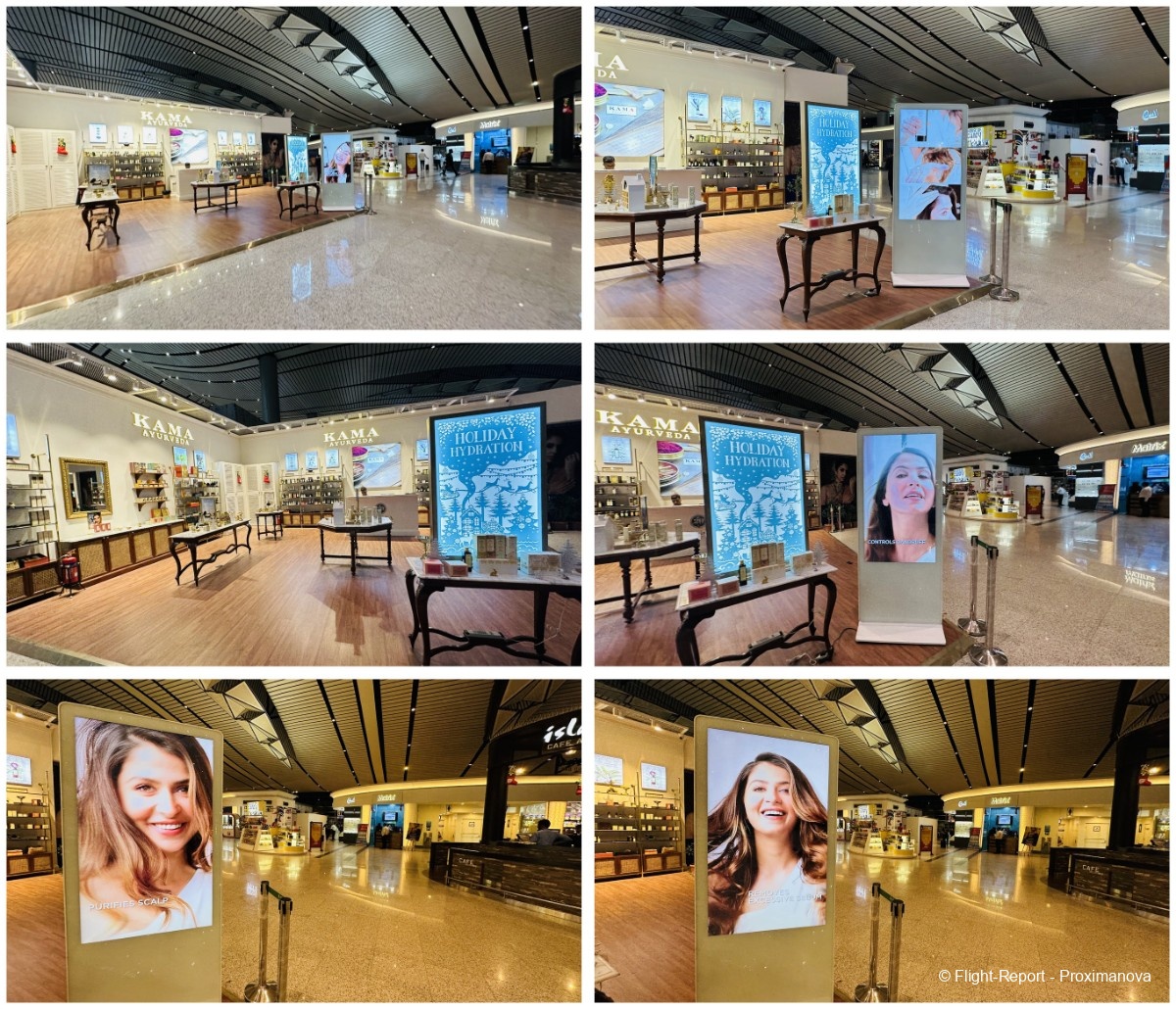
Then came Matrix, a company specialising in international SIM cards for frequent travellers.
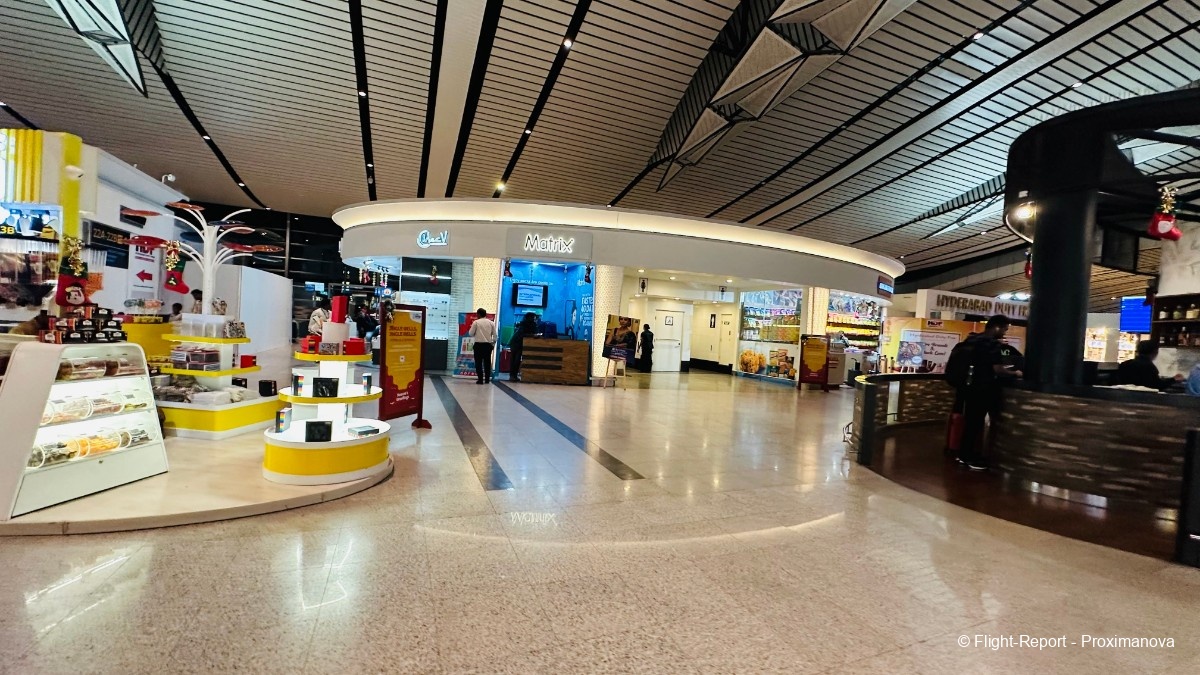
AH, WHSMITH!!! The more I see this and Relay at big Indian airports like BOM and BLR, the more I realise how much I have been short-changed by Chennai Airport, which with its terrible excuse of a shack in the international terminal (and the somewhat better Higginbothams in the domestic terminal) is doing itself no favours.
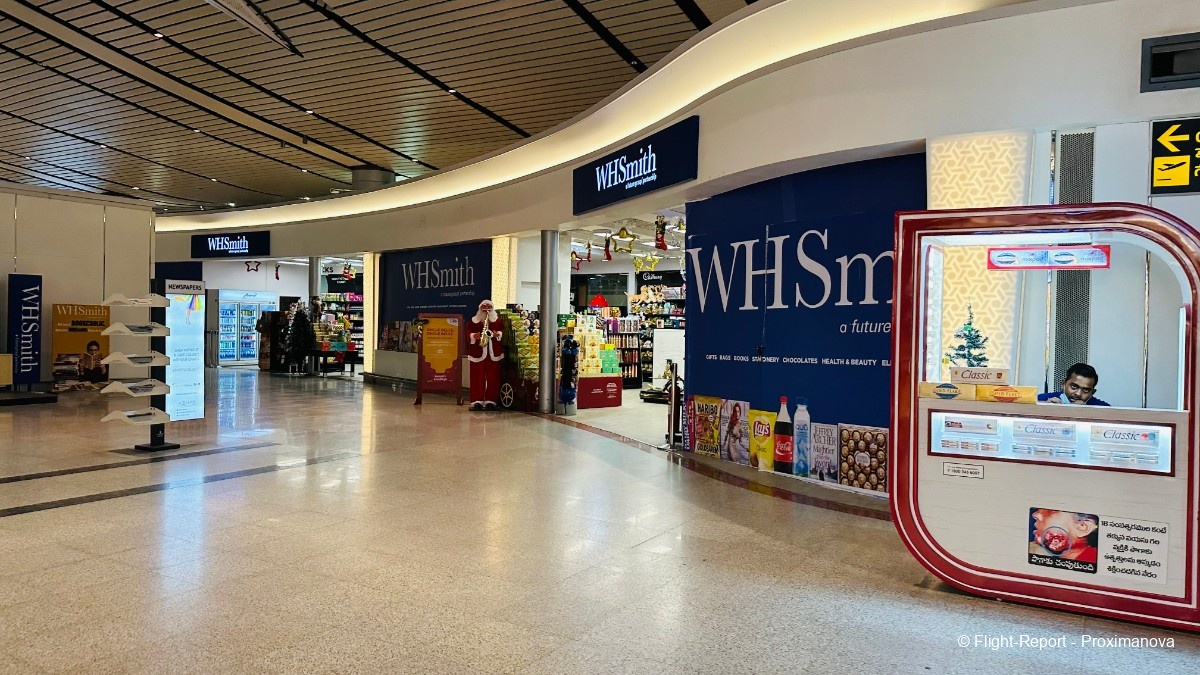
Nearby was Bikanervala, a renowned Indian sweet-shop for generations — also nowhere to be found in Chennai.
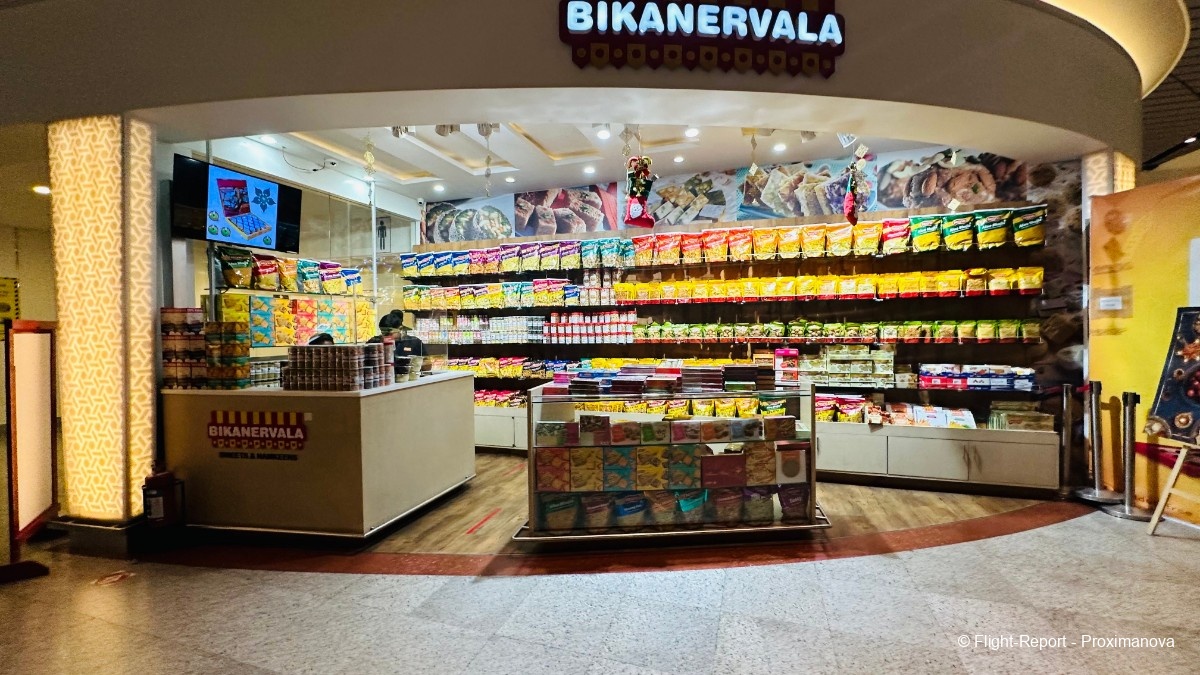
It had a bunch of tasty mixed candies and mukhwas (digestives), but I resisted buying one out of concern for my health and wealth.
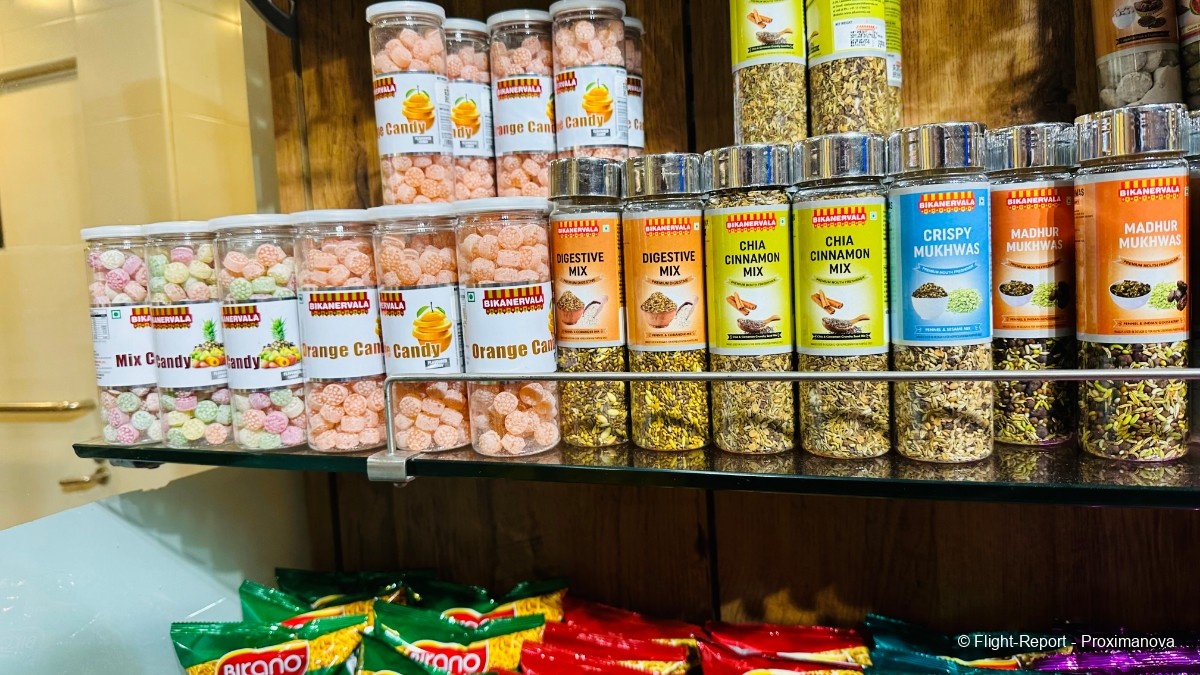
The departures were largely to the Middle East, including Saudi low-cost carrier flynas to Riyadh, which flies to Delhi and Mumbai but not Bengaluru or Chennai — with Lucknow in the north and Kozhikode in the south being its other Indian destinations.
British Airways is the sole European airline at HYD: it has neither Lufthansa and Air France (which serve BLR and MAA in South India) nor KLM (which serves BLR, and will soon be joined by new alliance partner Virgin Atlantic). However, LH will return to Hyderabad in January 2024 after a hiatus of over a decade.

After immigration came Hyderabad Duty Free on one side, and the city’s famous Karachi Bakery on the other. (No, nothing to do with Pakistan’s coastal commercial capital.)
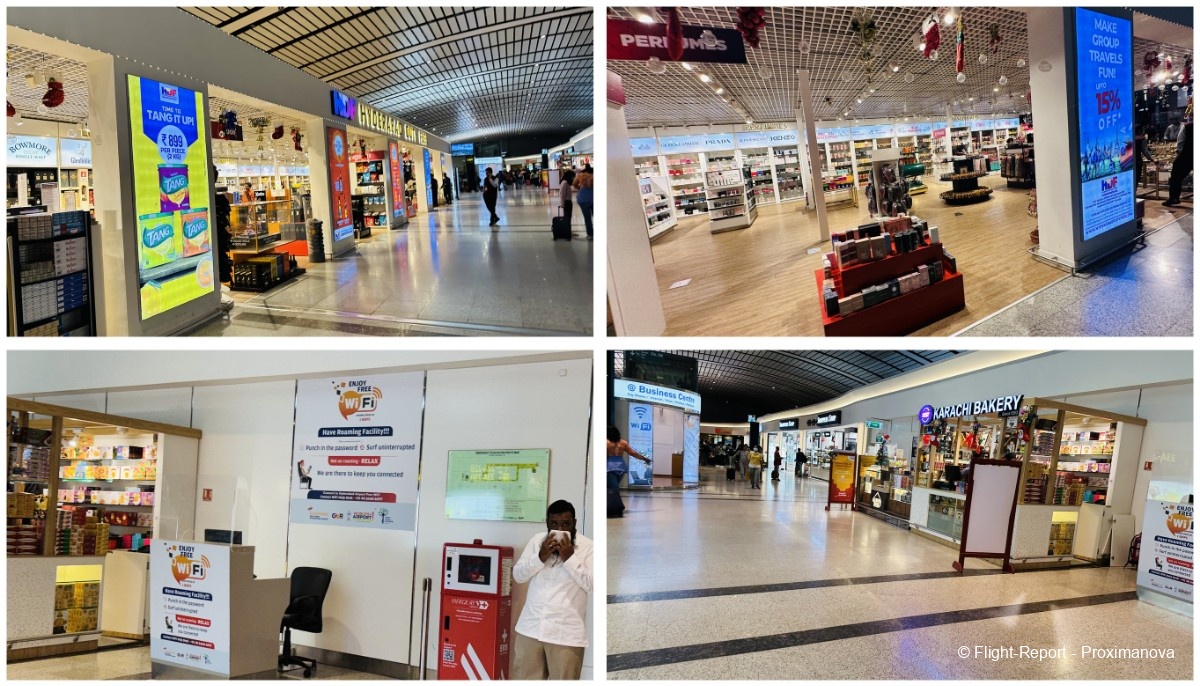
Closer to the departure gates was a business centre, advertising services ranging from scans and printouts to a payphone (?!), with a row of Lenovo ThinkCentre desktop PCs — but no chairs — inside.
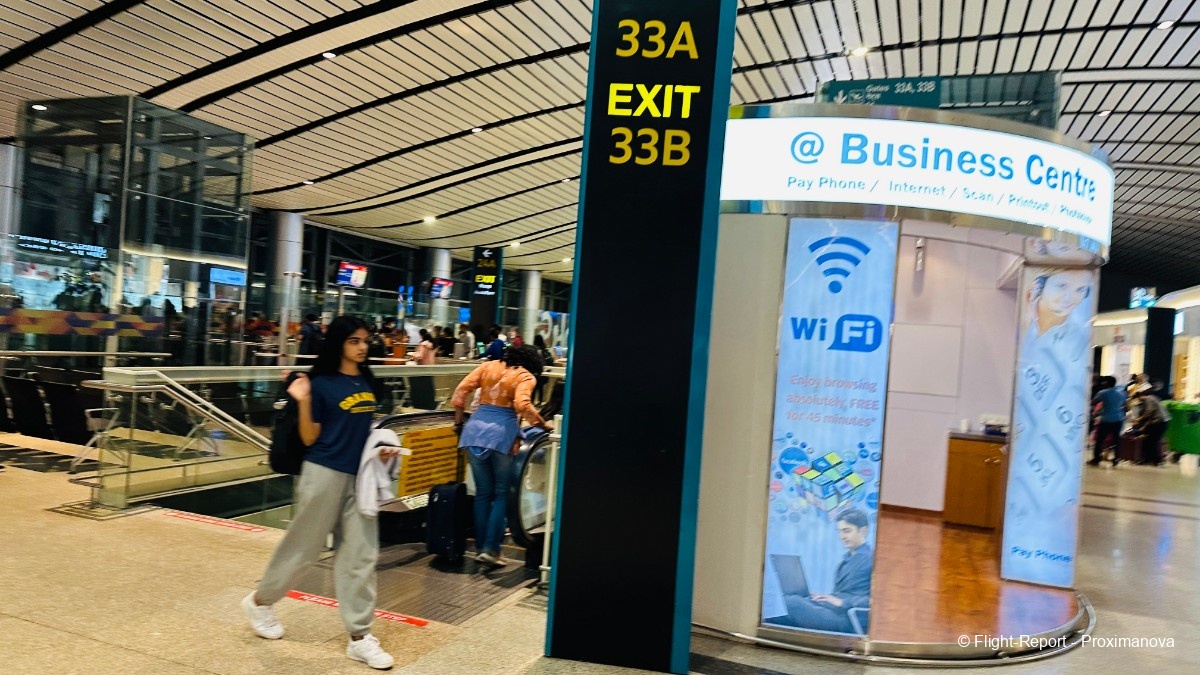
Funnily enough, the filename of the below image on my iPhone is IMG_2005.jpg — which happens to be the very year Lenovo acquired IBM’s computer business including the iconic ThinkPad brand! Is that supposed to be a coincidence or what?
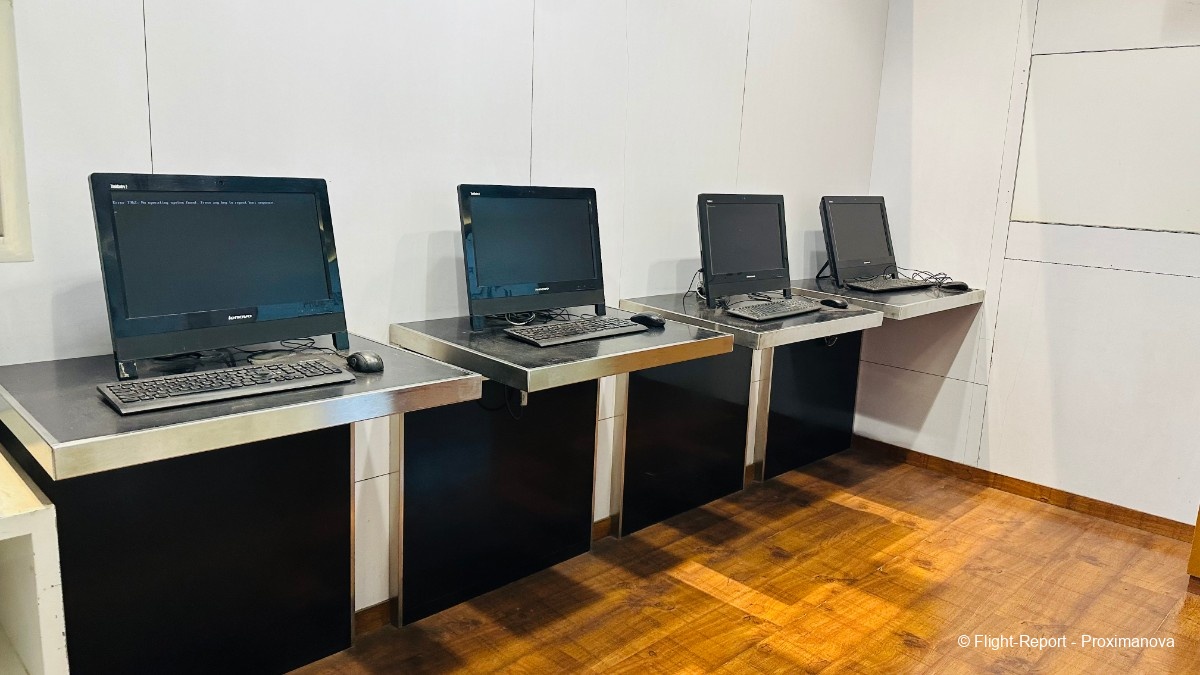
Passengers were lining up for Emirates’ EK529 next door, with A6-EGT waiting for them. On the other side was Shoppers Stop, a large Indian chain of department stores with the typical selection of fashion accessories.
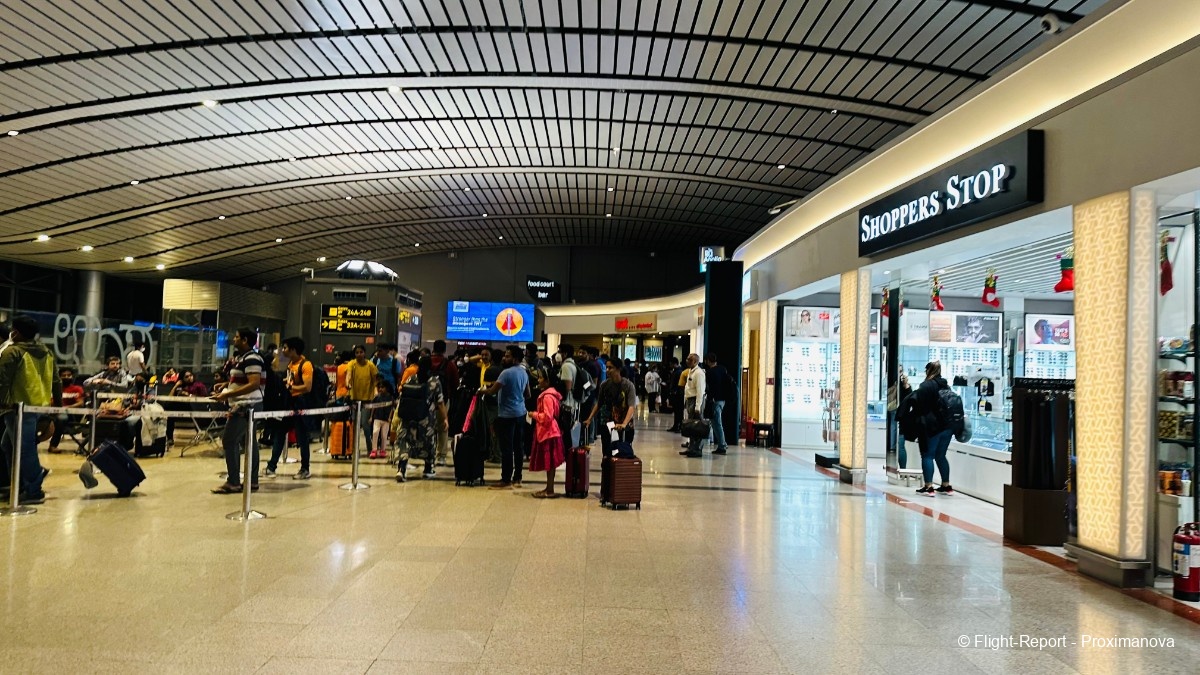
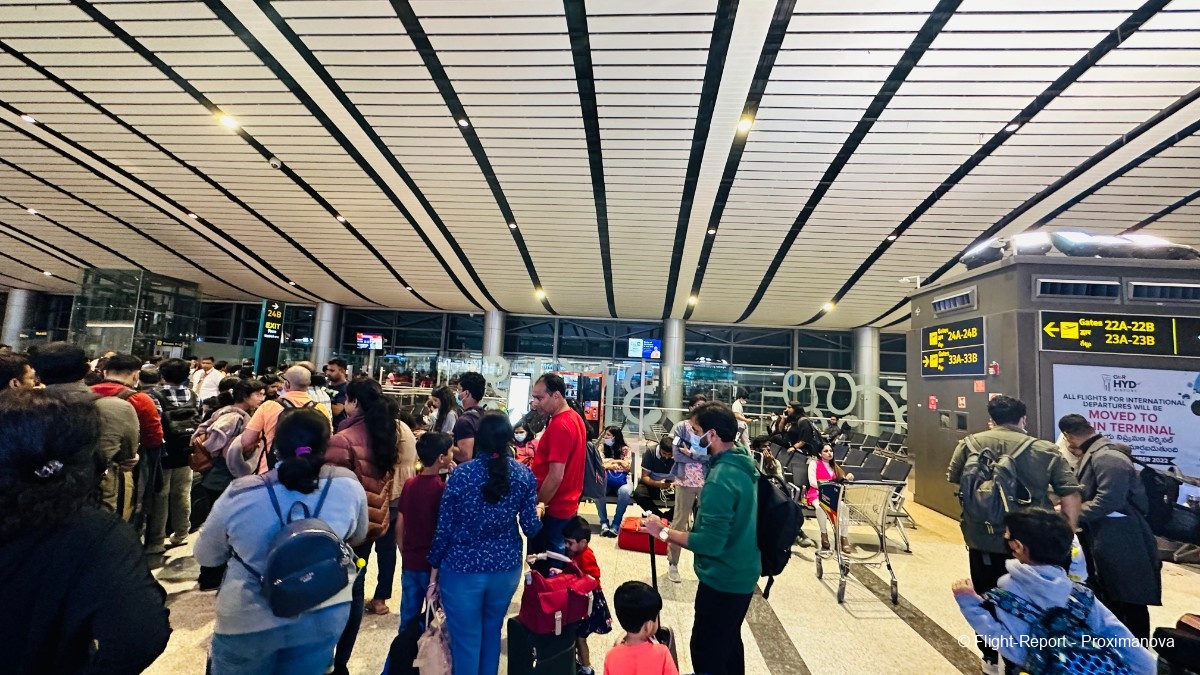
HYD struck me as a swanky airport with a nice selection of boutiques, but I’m sorry to say there wasn’t the same selection of food outlets that I saw at BLR’s international departures. Or is that a function of Indian domestic terminals in general having more facilities and shops than international ones?
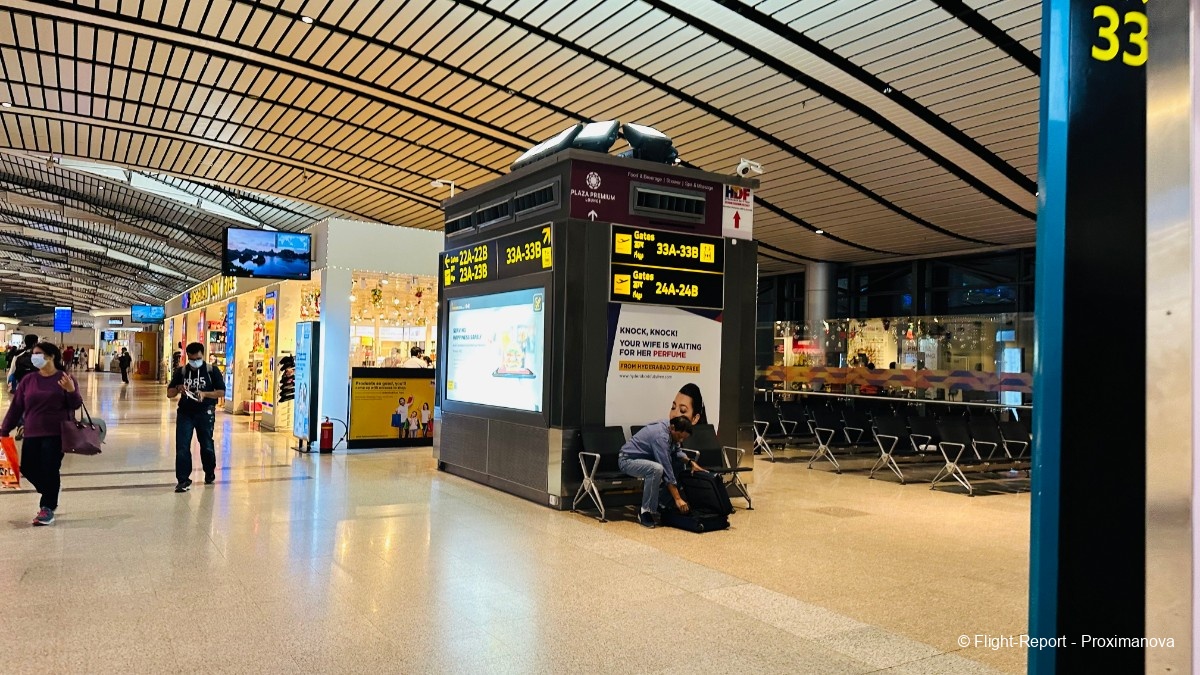
The lettering outside spelled out the airport’s name to taxiing aircraft, much like is the case at Kempegowda in Bengaluru.
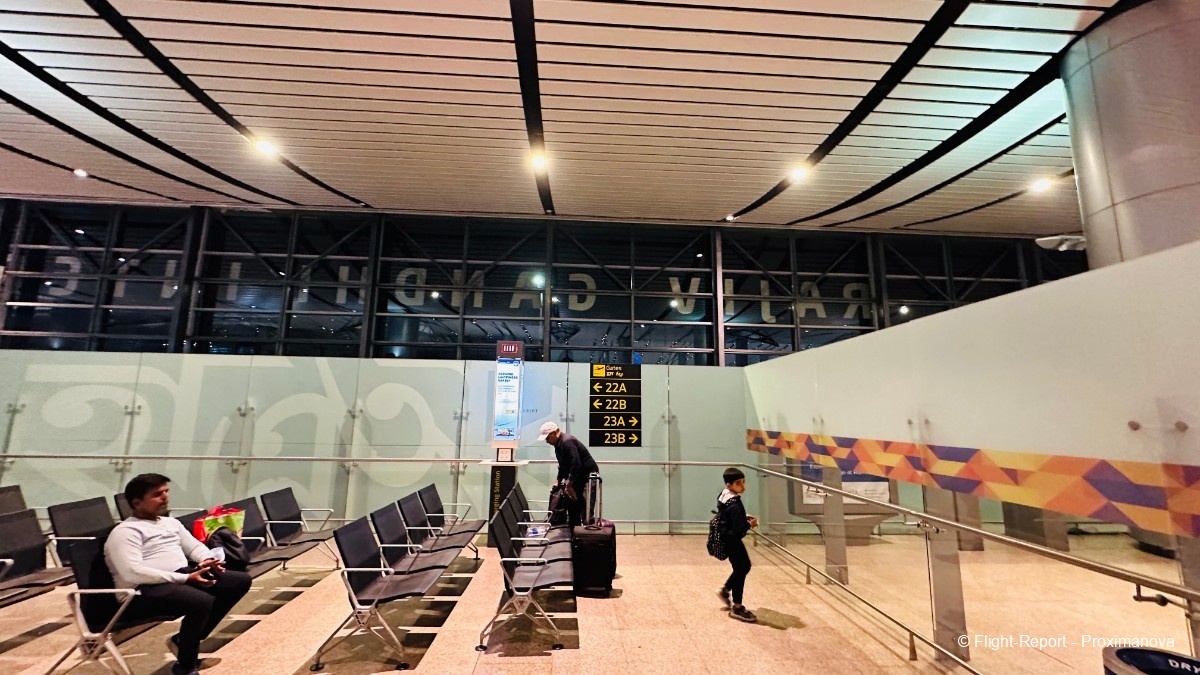
There were only a couple of eateries to be seen near the gates, until I thought I had stumbled upon an order-anywhere solution (see next section) — except it didn’t work…

Ads for the Himalaya Drug Company rang in the New Year, towering over telecom major Airtel’s kiosk for its premium Airtel Black service.
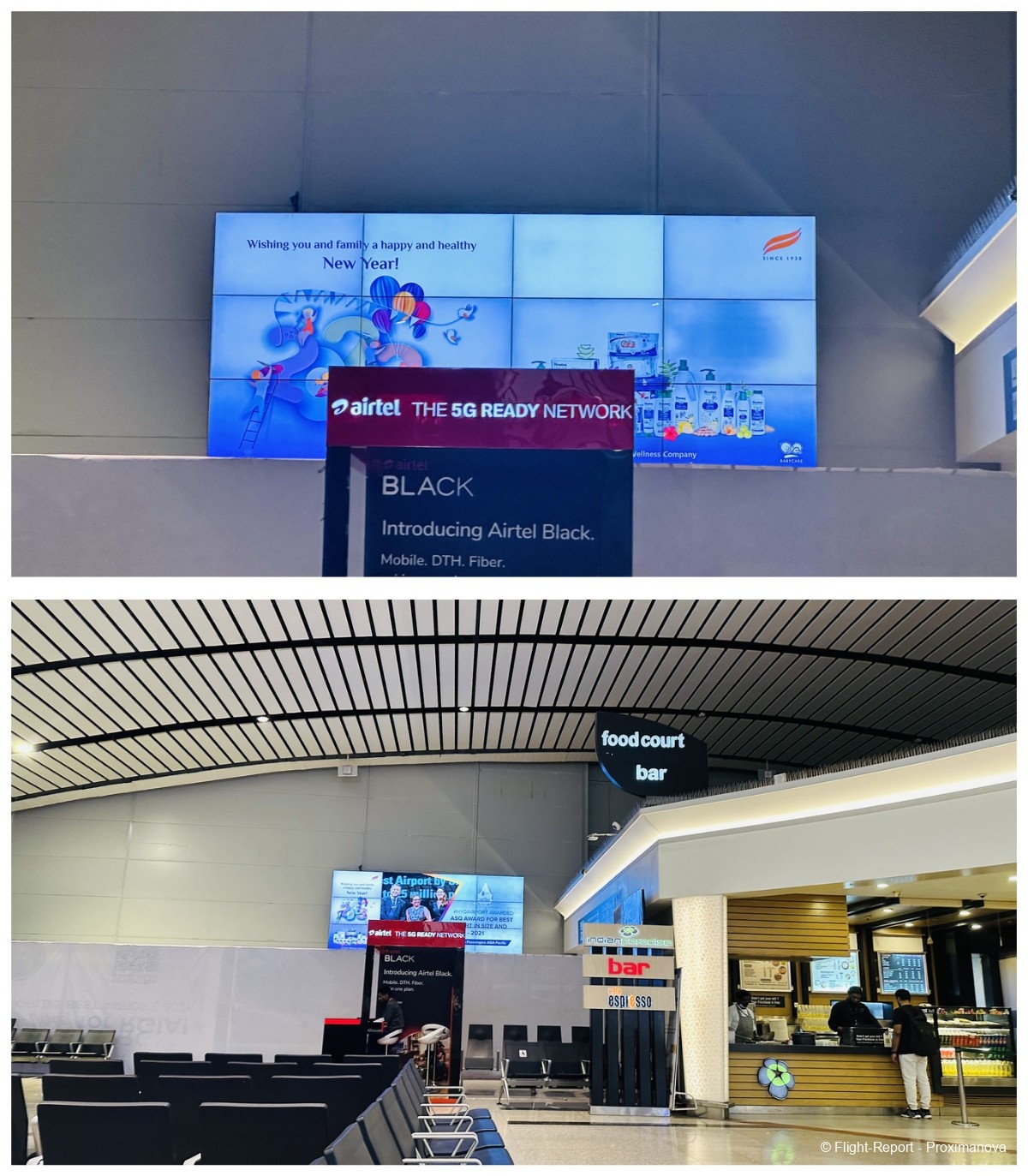
A pair of young travellers, strollers in hand, proceeded towards the gates, having walked past the pretty shops and lights.

Failed and successful efforts at RE’HYD’RATION
It was now that I saw an ad for HOI, a new initiative by GMR Airports — consisting of Delhi, Hyderabad and the new North Goa (GOX) airport, which opened later that week on 5 January — that advertised contactless food delivery anywhere throughout the airport from a wide range of restaurants. Hallelujah, I thought — but I shouldn’t have.
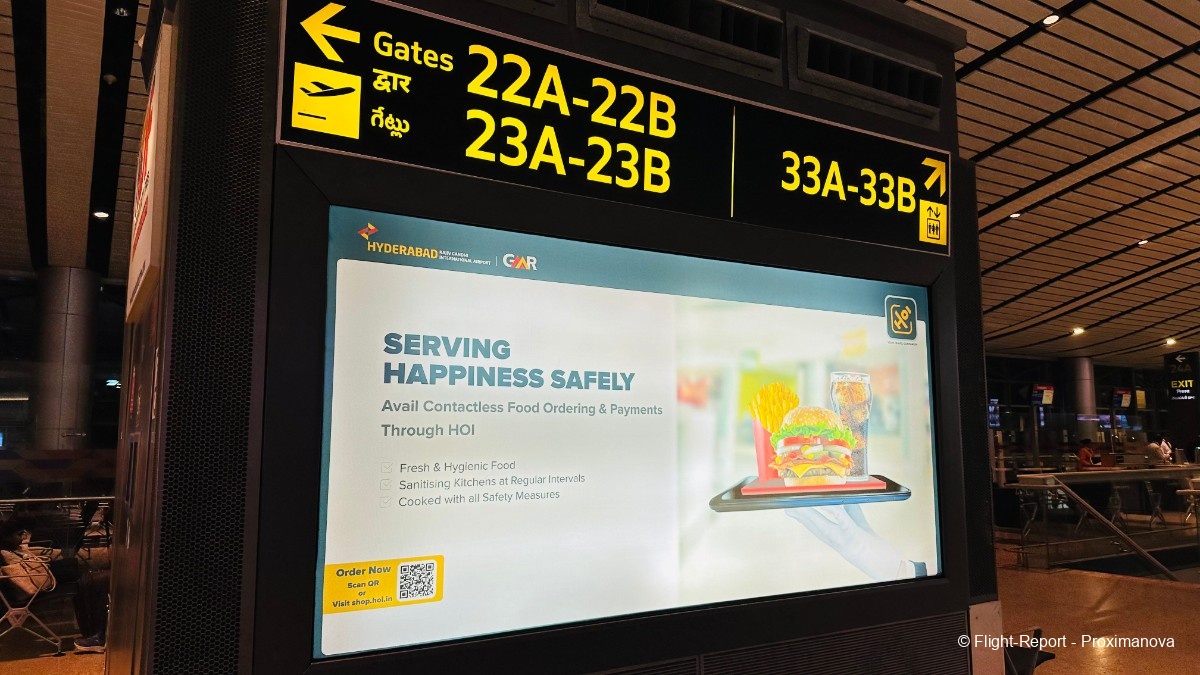
On HOI’s website, I found detailed descriptions of its design and promised benefits. I must say that GMR put in a lot of effort to ensure that HOI had as pleasing a design and UI as possible for a 2020s website. All the more so because it used my favourite Proxima Nova font — as you can judge from my username here!
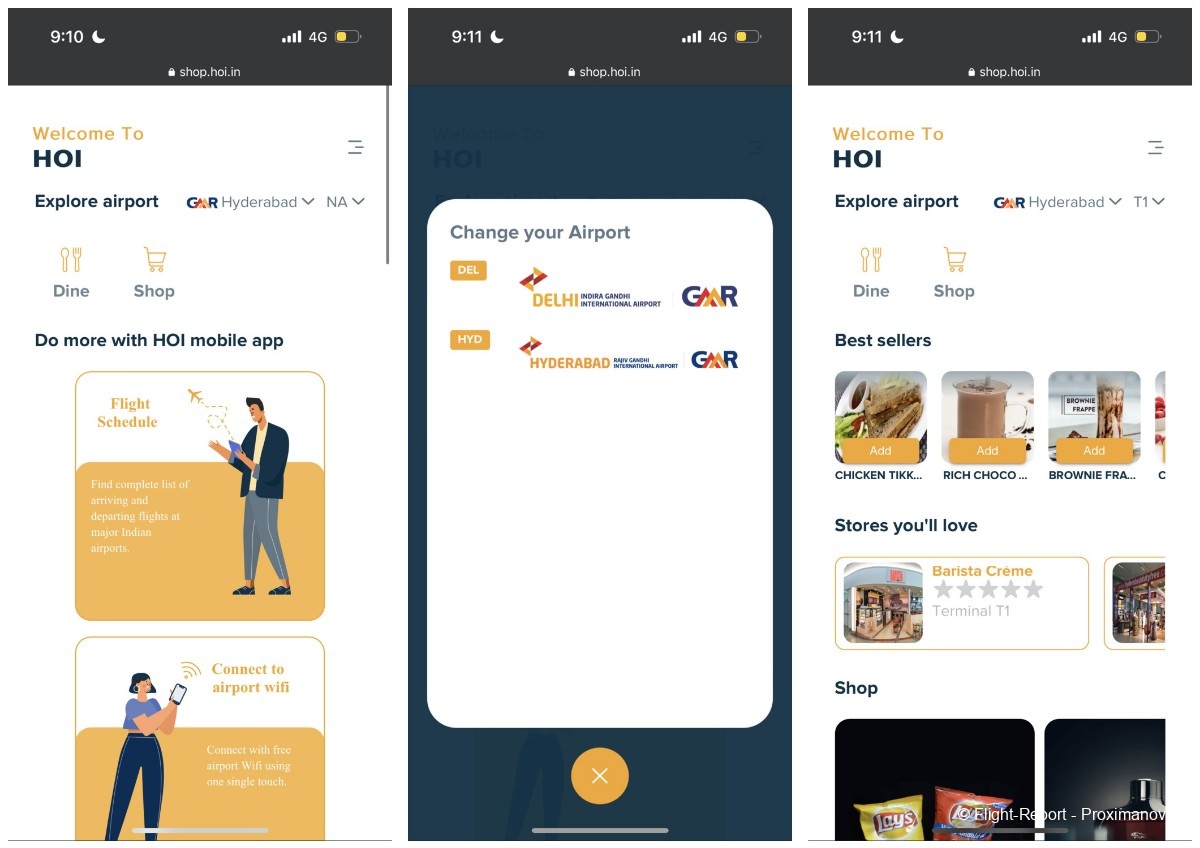
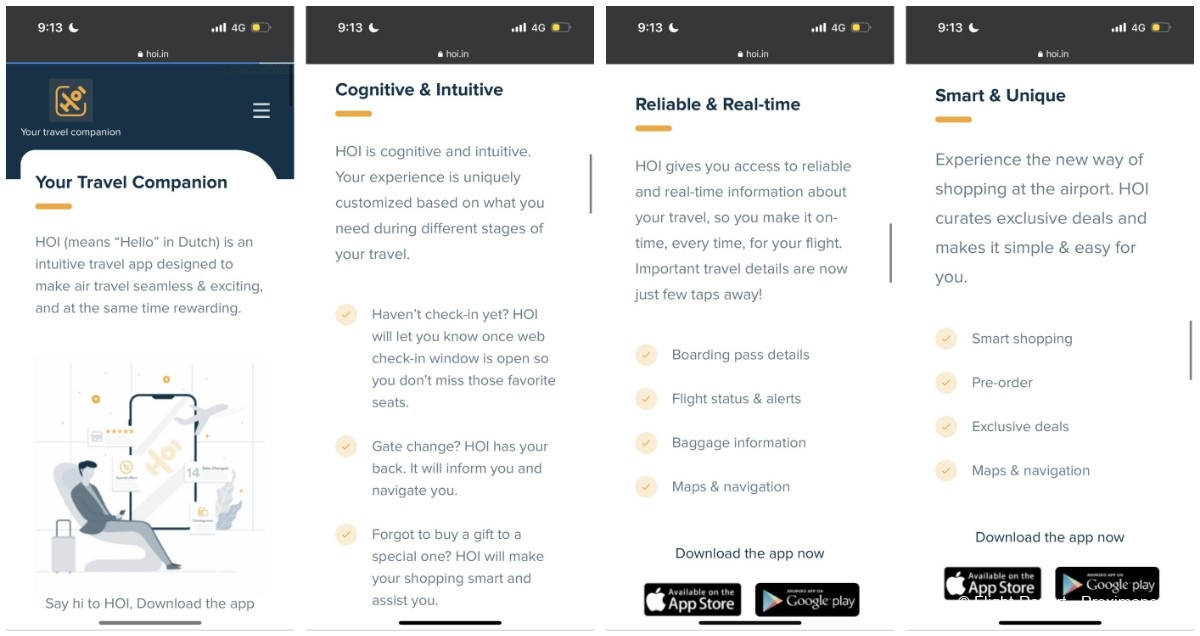
I decided to order a meal from Burger King and paid for it soon enough. Oddly, the only available drop-off location in the international terminal was Gate 33A downstairs, which required an escalator ride to a completely desolate waiting area, bare save for a security guard.
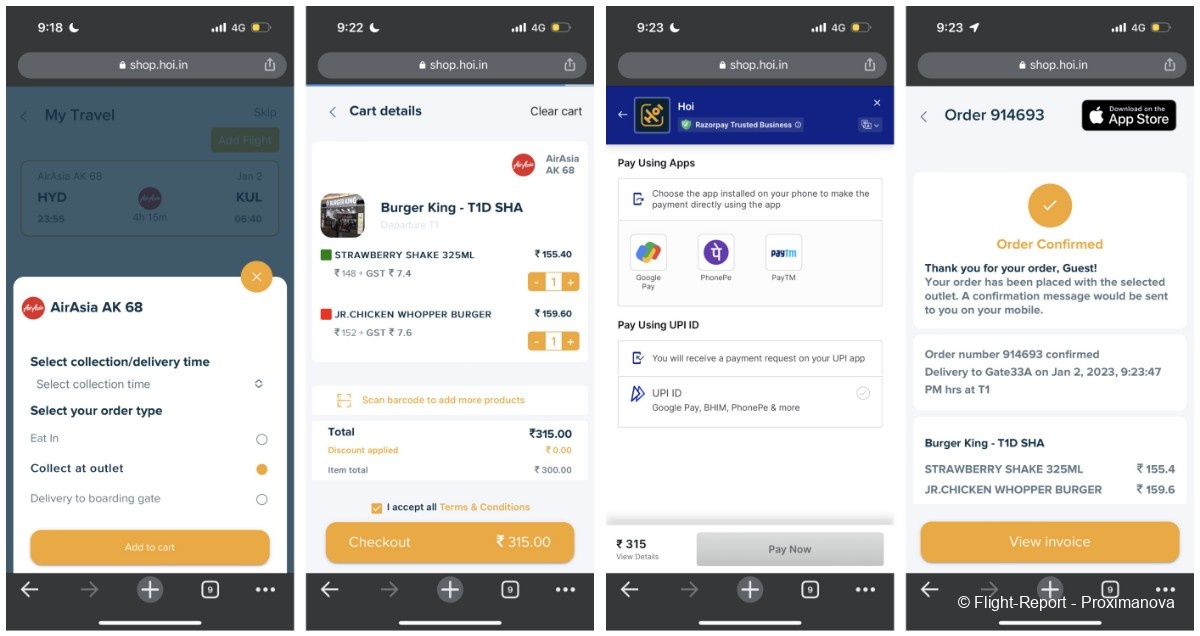
Nothing and nobody barring a couple of ad-wrapped pillars, a drinks vending machine…
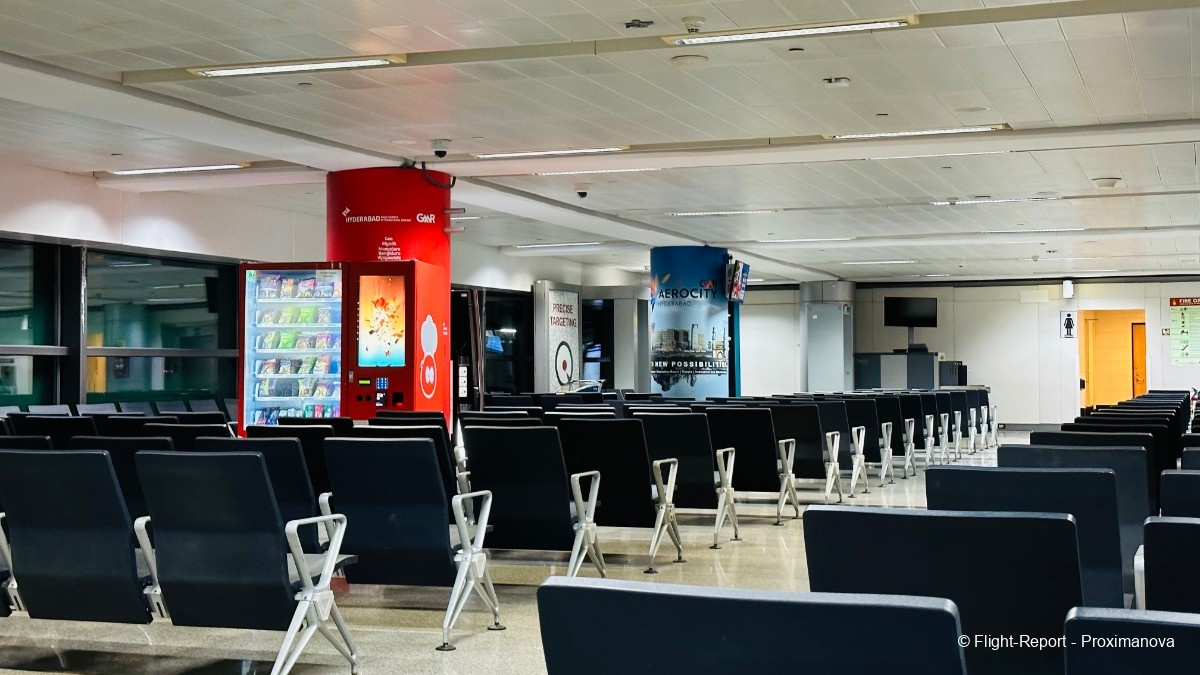
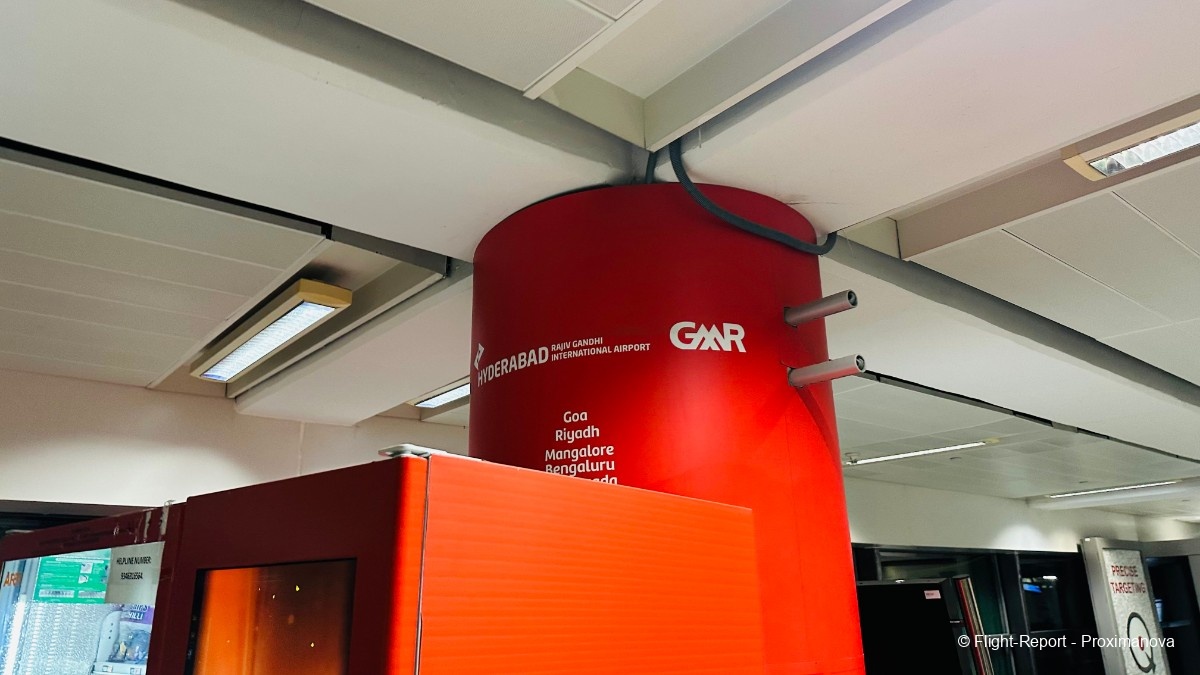
…and a series of ads on loop, ranging from RGIA’ advisories on consumer rights and requests for feedback…

…to commercial ads, including for Malabar Gold & Diamonds…
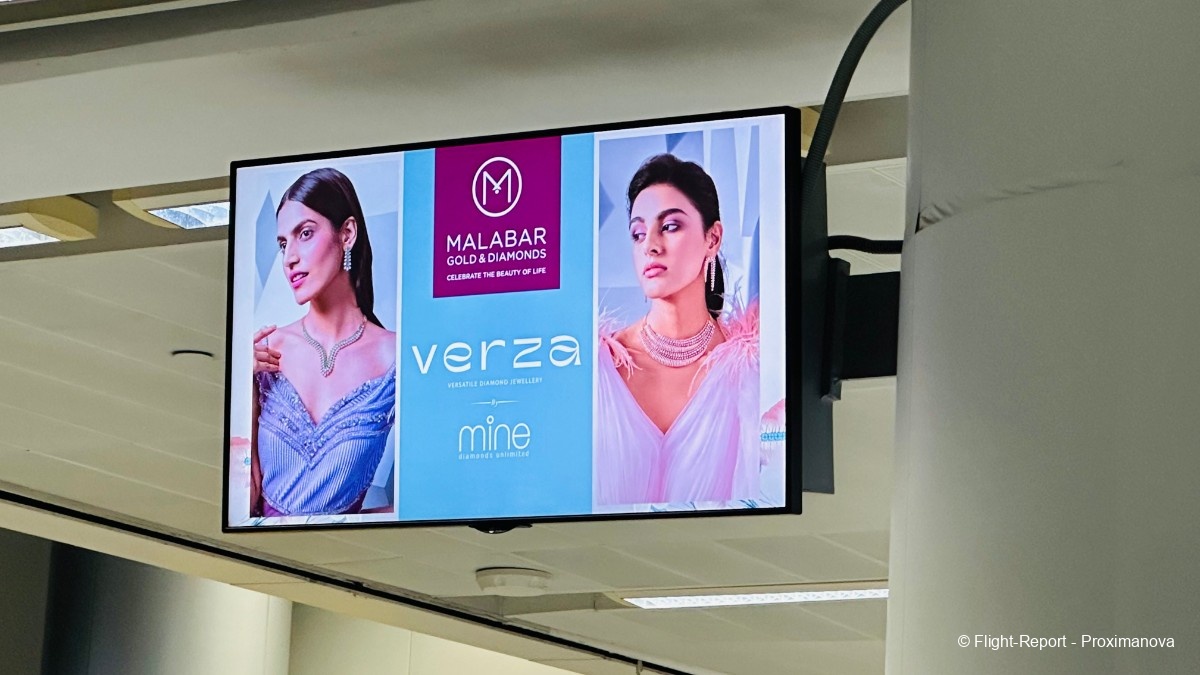
…and the second season of Shark Tank India, which would premiere on major Hindi entertainment channel Sony Entertainment Television that very night — along with Season 7 of MasterChef India in its very first season on Sony TV, having aired on Disney-owned Star Plus before. Shark Tank India occurs later in this report, since one of the sharks, Namita Thapar, had written a book which I bought from the WHSmith before leaving HYD.

Indeed, The Economic Times had a front-and-back full-page ad-spread promoting the new reality shows on SET and its SonyLIV streaming service. Indeed, Sony TV relies much more on reality shows than competing Hindi entertainment channels like Star Plus, Zee TV and Colors, which are driven by melodramatic (‘saas-bahu‘) serials.
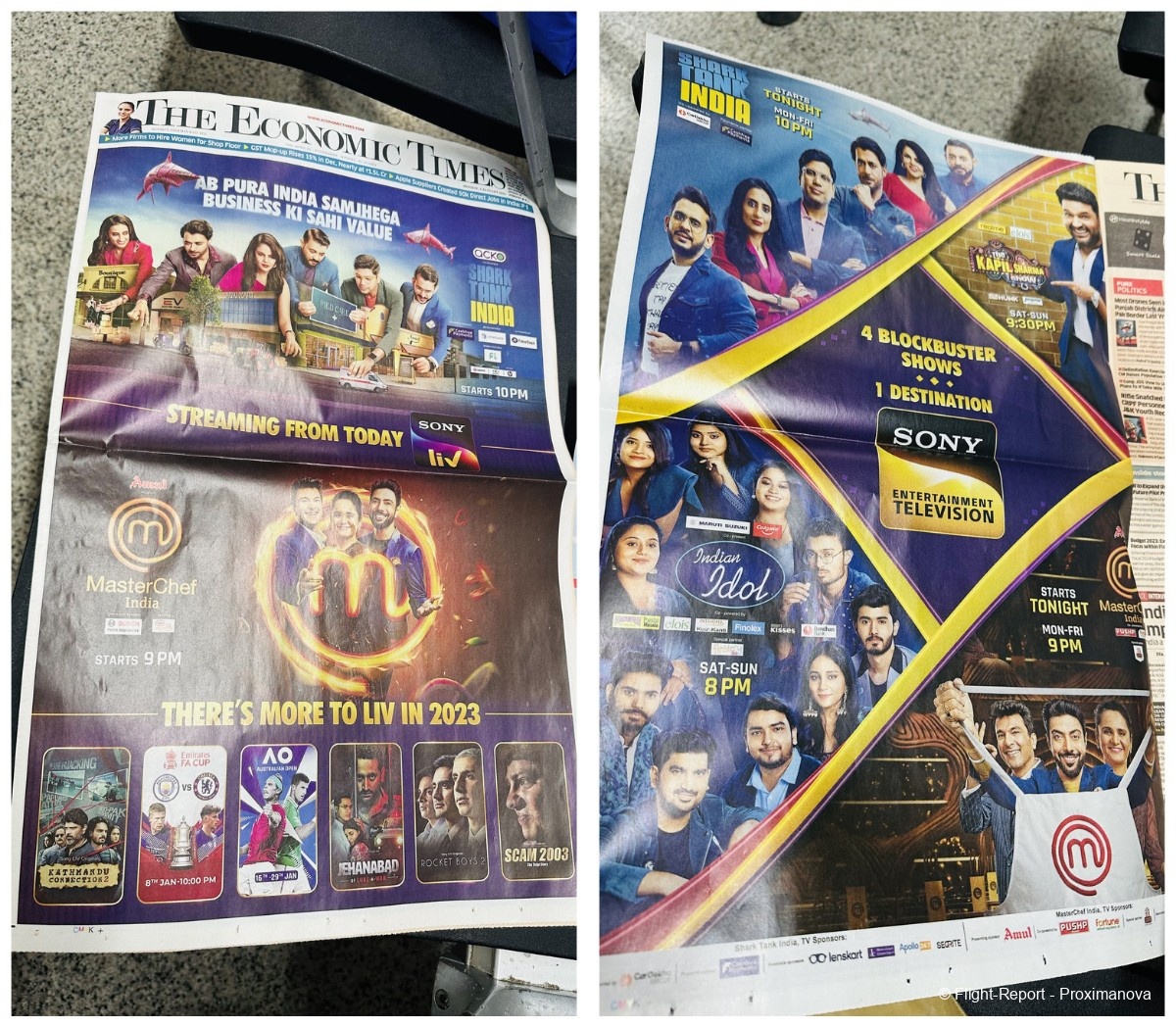
Hyderabad — and the rest of the country — had partied all night and into the morning to welcome the first (nearly-)COVID-free, restriction-free year since what seemed like forever. The Deccan Chronicle newspaper, headquartered in the city with a presence all over South India, covered the celebrations with pomp and festivity.
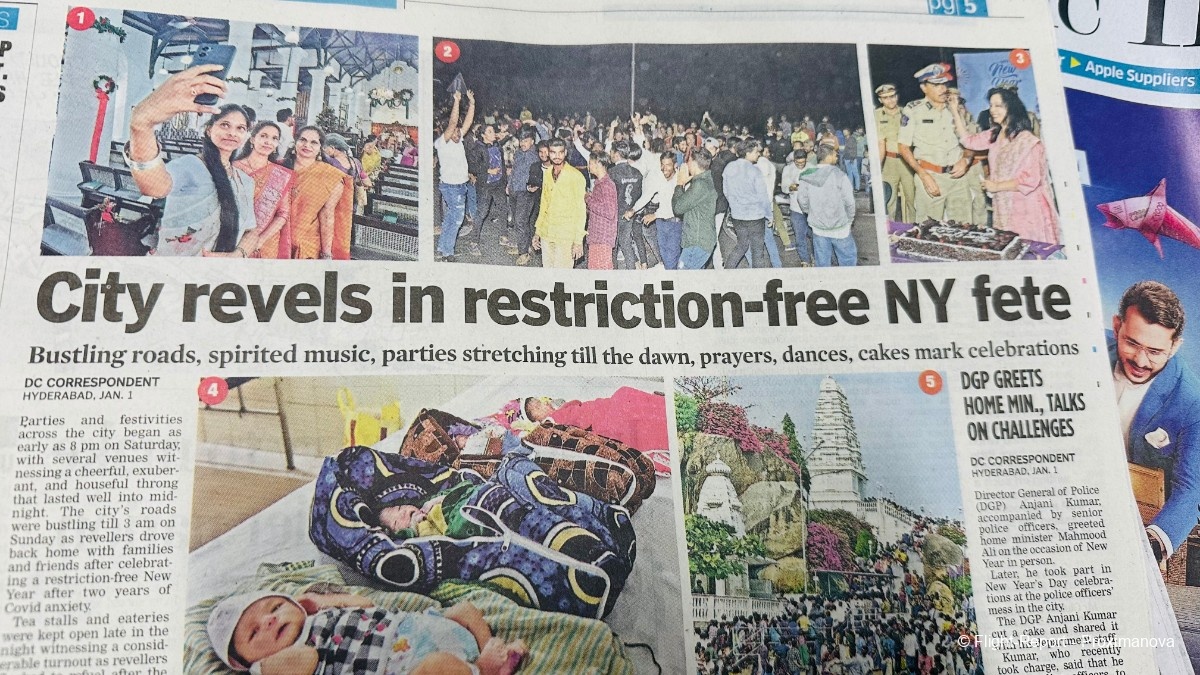
But shoehorned into the corner was a tragic incident: at three in the morning on New Year’s Day, a 20-year-old girl in Delhi had her foot caught in the axle of a speeding car, and it dragged her naked, lifeless body for four kilometres. The Sultanpuri case dominated Indian headlines in the first few days of 2023, before the Air India ‘pee-gate’ scandal took centrestage.
Meanwhile our northern neighbour Nepal had inaugurated the Pokhara Regional International Airport (PKR), built with Chinese assistance. This is the third international airport in the mountainous country after the capital Kathmandu’s Tribhuvan Airport (KTM) and Bhairahawa Airport (BWA) — but, several months on, it is only KTM that handles all international flights out of Nepal, as has always been the case. Neither PKR nor BWA has managed to sustain any international flights, and even though Nepal Airlines announced a flight from BWA to Kuala Lumpur in June, goodness knows whether it is operating at all. Similar is the case in Sri Lanka, where despite international airports existing in places like Jaffna and Hambantota, it is only Colombo’s Bandaranaike Airport that connects the island country to the world.
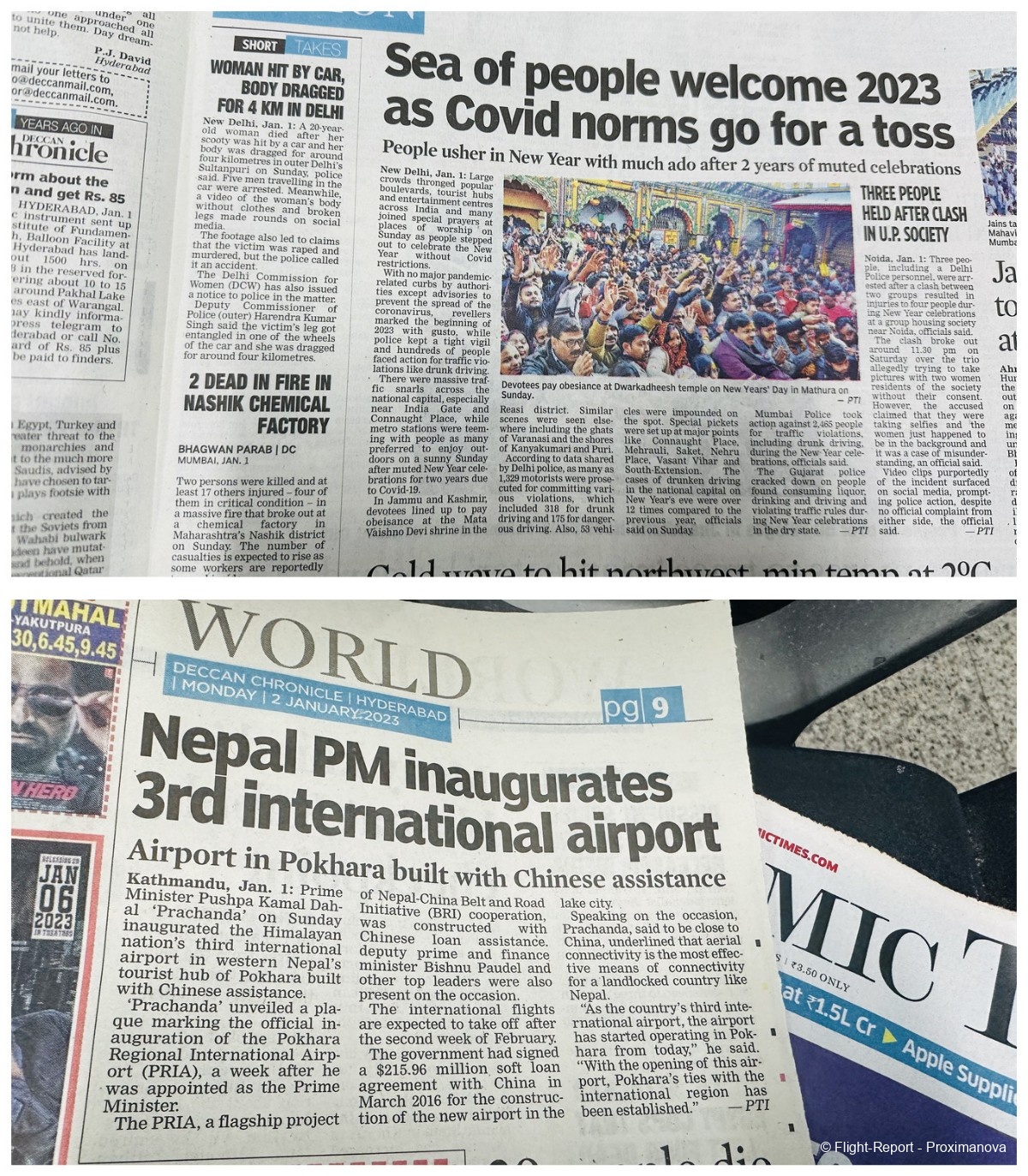
However, Pokhara would appear again in the news a couple of weeks later, this time for a macabre, sombre reason: the crash of Yeti Airlines flight YT691 on a sunny Sunday morning minutes before landing, resulting in all 72 people on board the ATR 72 losing their lives. Shockingly, one of the passengers — one of five Indian fatalities — managed to record the final moments of his and his passengers’ lives, before the turboprop (registration 9N-ANC) was consumed by flames.
This continued the awful pattern of the first major aviation disaster of the year having no survivors. Indeed, since 2019, a chilling pattern has been discovered with the deadliest crashes of each year (ET302, PS752, SJ182, MU5735 and now YT691): not a single soul survived; the crashes were in either January or March; they were the first crashes of the year, and the only crashes in each year not to have any survivors; the doomed aircraft was almost always a Boeing 737, with 9N-ANC, an ATR 72 — Nepal has no 737 operators — breaking that last trend.
Enough with the macabre, and back to the merry: here was A6-EGT waiting for the passengers of EK529, a flight number that is used for another South Indian city — Chennai — by both Qatar Airways and Singapore Airlines.
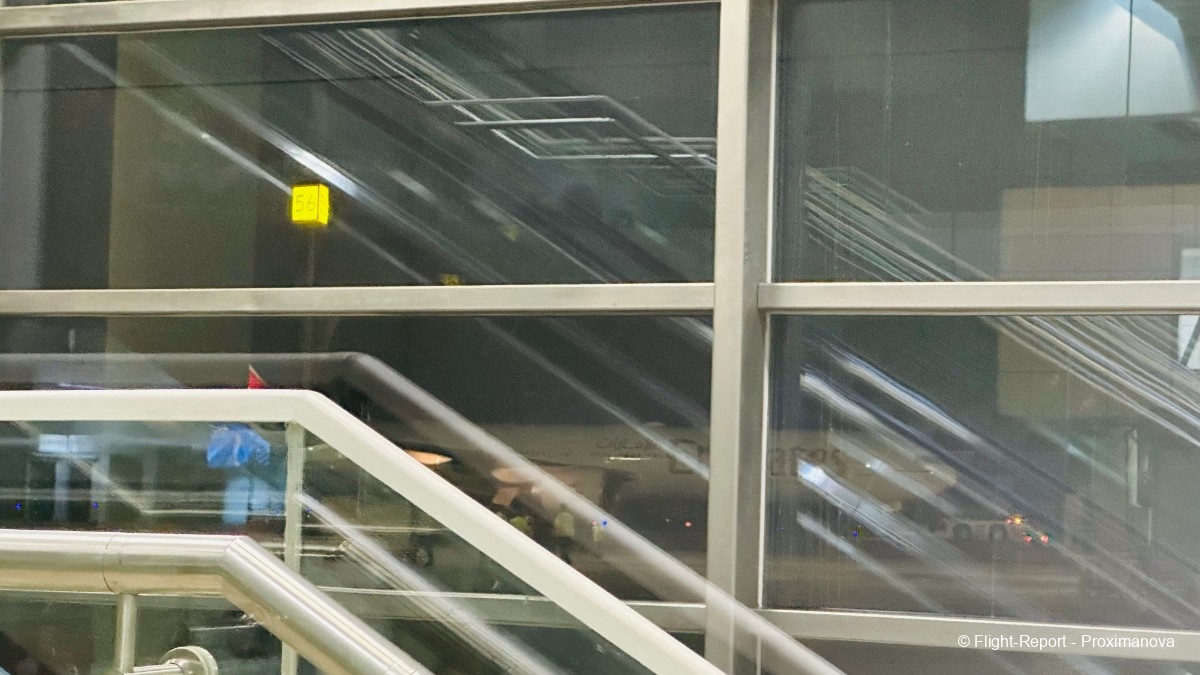
Nearby, a boarding sign for Oman Air had been placed. In a year’s time we should see the blue circle of Oneworld on it — and you can thank Qatar Airways for ushering its friendly boutique neighbour into this premium grouping — unless the alliance has the good sense to substitute that eyesore from 1999 with a better-looking replacement.
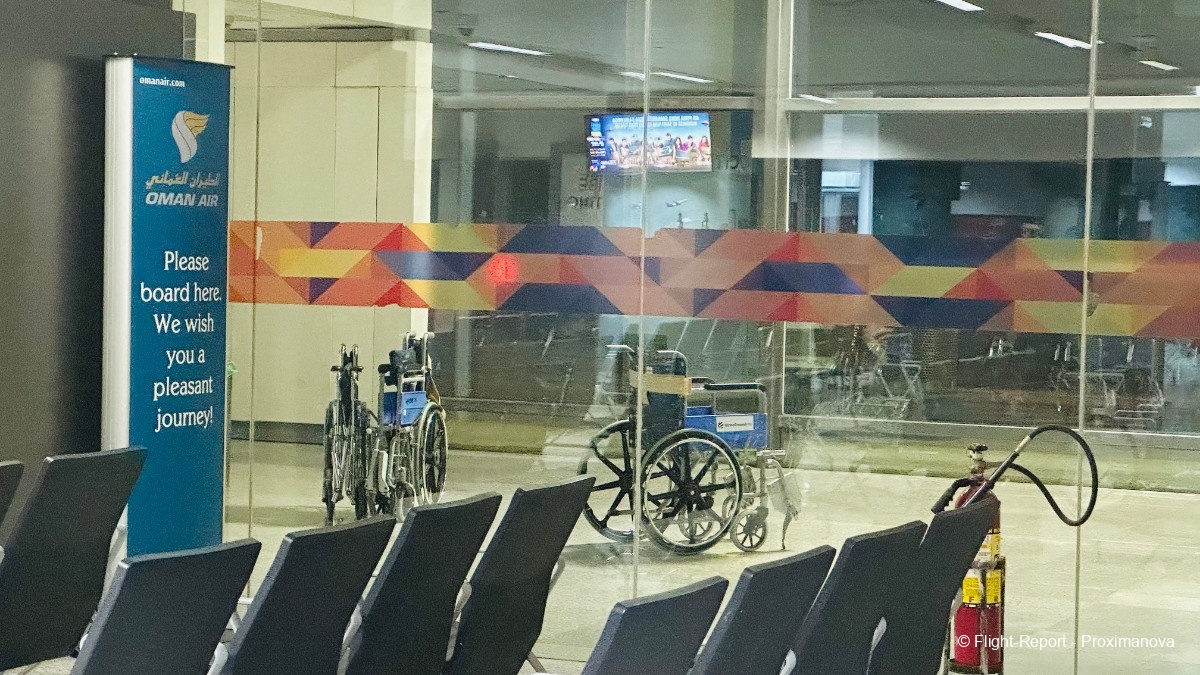
I waited and waited, but the food never came, and I cursed the HOI platform endlessly for aggravating my hunger. At ten minutes past ten, I ventured back up the stairs and entered the sole restaurant.
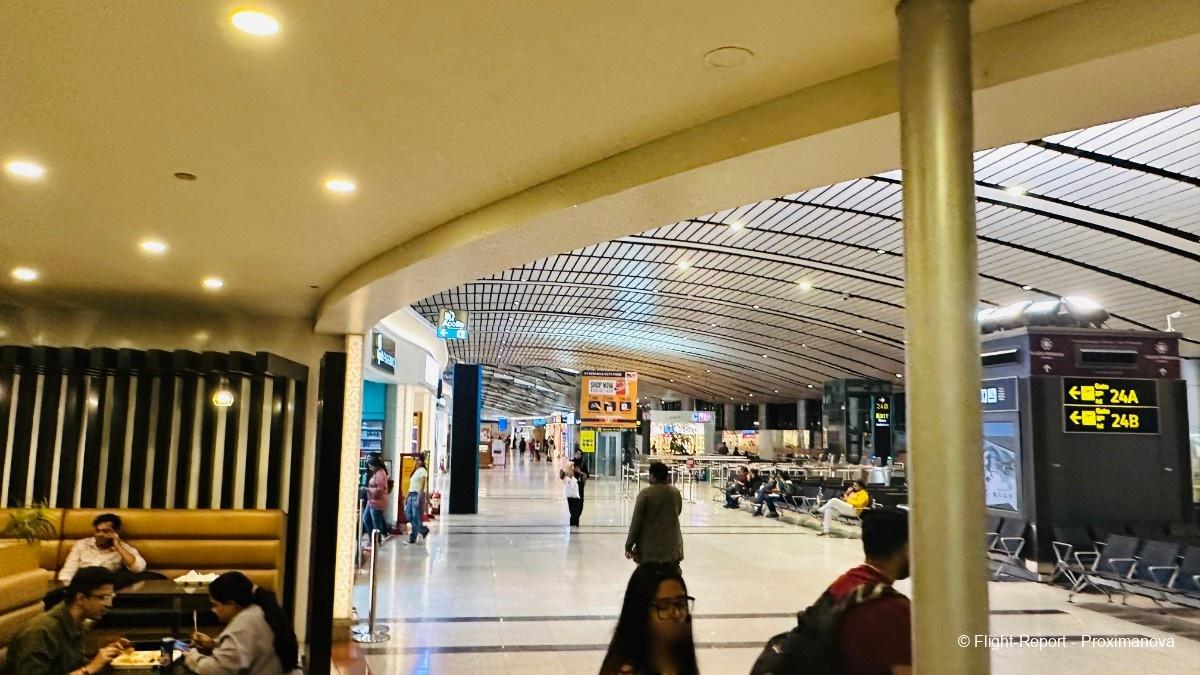
The HOI polloi (ha!) were making merry: a group of Telugu-speaking techie guys at one table, a North Indian family (below) at the next.
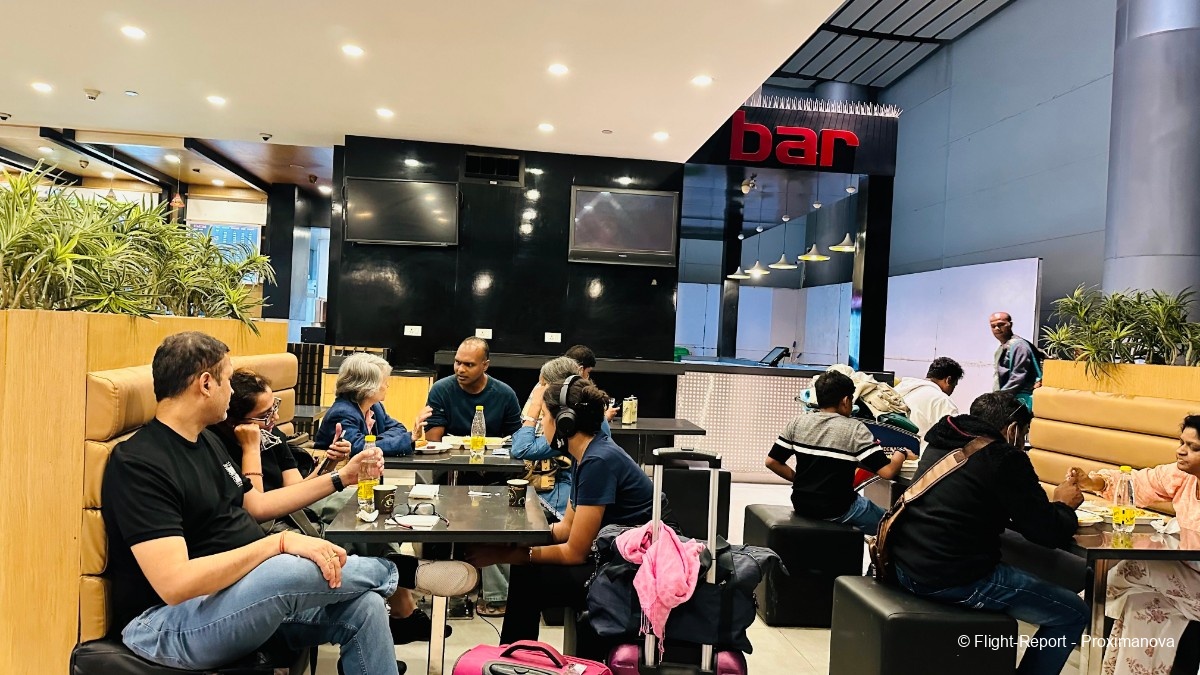
Something is better than nothing, as I always say, and before long I had a delicious veg thali meal and a cup of sweet lassi on my table. It cost more than the ₹315 I’d paid for the non-existent Burger King meal. But I guess I can’t blame HOI or the airport, since the outlet was probably in the domestic part of the terminal, and either the delivery guy might not have known the drop-off location or it might have faced hurdles with clearances.
Nevertheless, HOI should be praised for making the option exist in the first place, all the more so with its pretty interface, and I know for sure I’ll be trying it out if ever I pass through HYD, DEL or GOX (the new North Goa airport) again.
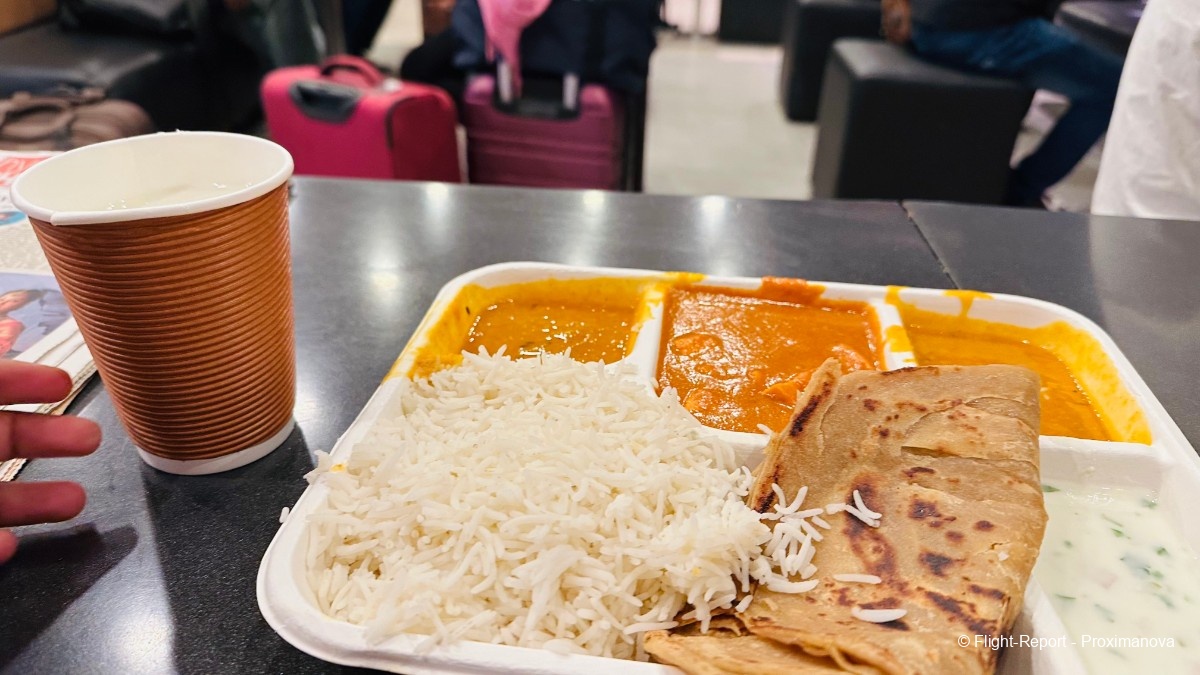
There were a bunch of destinations across both Southeast Asia and the Middle East, in addition to Colombo and Dhaka, as well as British Airways to Heathrow. Interestingly, Hyderabad is today the only Indian city to be served by both Singapore Airlines and Scoot, though prepandemic Scoot (and the erstwhile SilkAir) also flew to Bengaluru, Chennai and the like. However, Scoot is set to resume flying to Chennai starting from the winter season in October.

Books, gifts, dolphins and sharks
No Indian airport visit is complete unless I check out the Relay/WHSmith and see what I can add to my ever-expanding book library and/or refrigerator. A young couple were the only other customers, dressed in their airport-ready attire.

I was pleasantly surprised to see a rocket-shaped Tintin stand; I’ve had the entire collection for more than a decade, and it remains my (and my father’s) all-time favourite comic-book series. It goes without saying that Flight 714 (to Sydney, not Bangkok, as my recent report would suggest!) was also among the displayed titles.
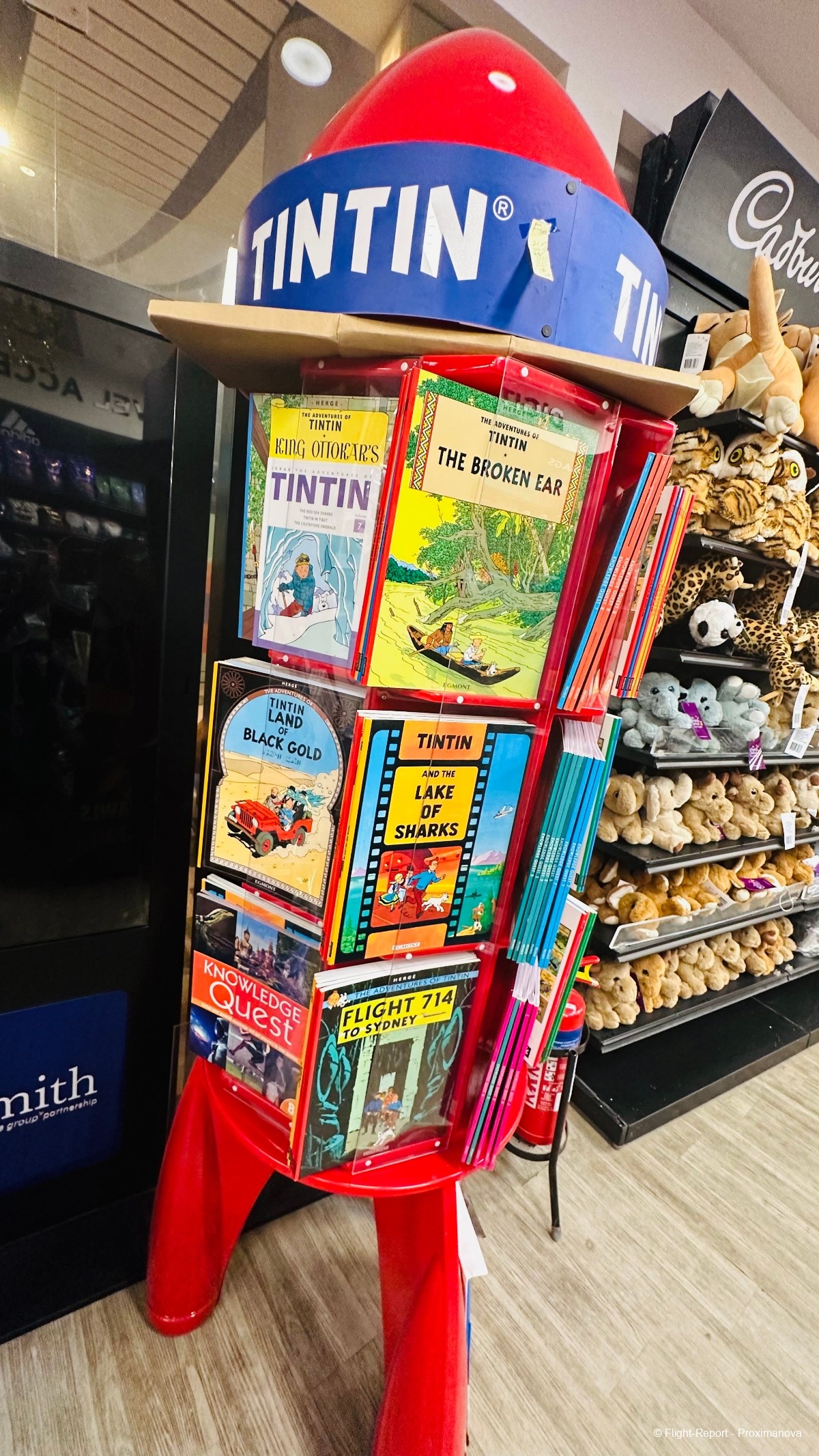
Behind global bestsellers Elon Musk and Lessons in Chemistry was hiding the book I wanted to buy now: The Dolphin and the Shark by entrepreneur Namita Thapar, CEO of Emcure Pharmaceuticals and one of the judges on Shark Tank India. Her book was the best thing to buy on the day the show’s second season premiered.
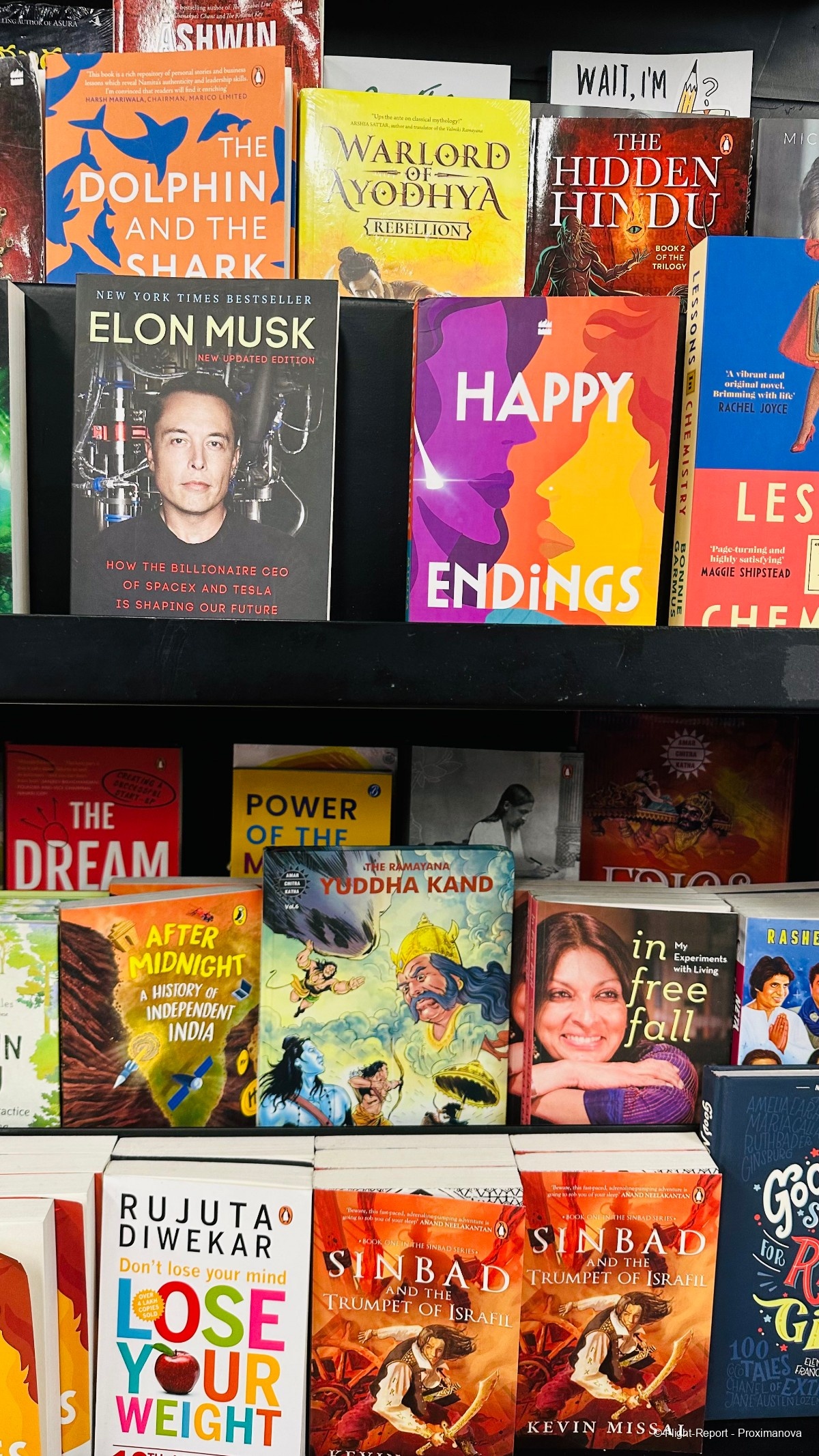
I must say, she strikes quite the presence in the corner image on the back cover. Along with Mrs Thapar’s collection of tips and insights into the world of startups, I also bought a Reader’s Digest — another thing I devoured as a child — but, I’m sorry to say, I haven’t got around to reading it!
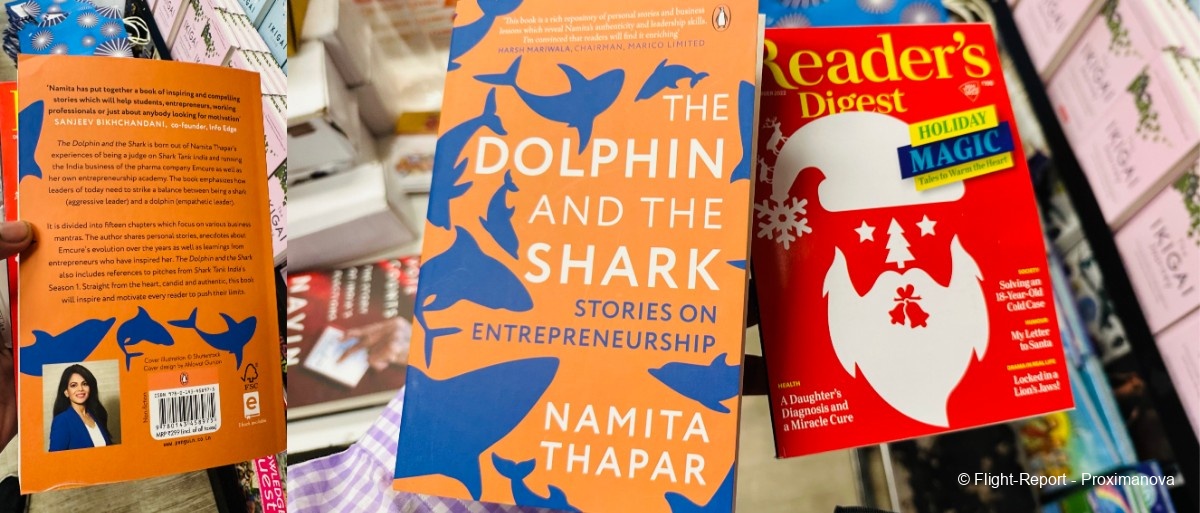
Now it was eleven and 9M-AGO had passed the riverine city of Vijayawada, not too far from Hyderabad, while 9V-MBJ of Singapore Airlines had already landed. A6-EGT was well on her way to Dubai, and so was A320 4R-ABL down to Colombo as UL176.
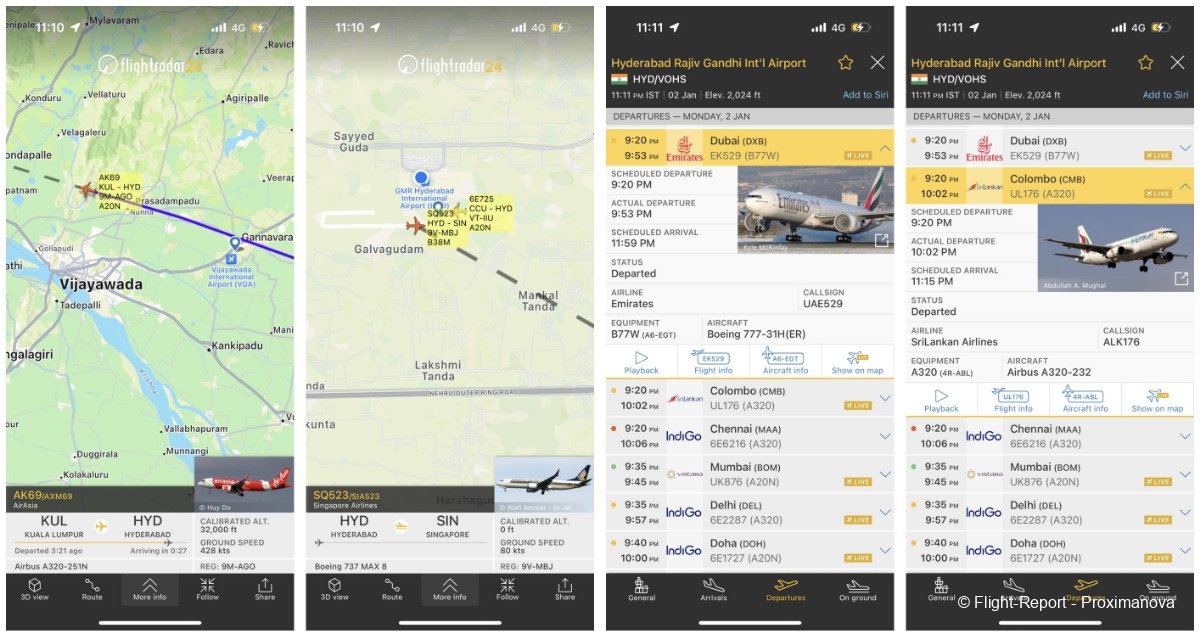
Keeping the topic on Shark Tank and Sony TV, I’d posted the newspaper ad on the DreamDTH television forum, where I am a longtime member, and gradually accumulated a number of likes. Right now, though, one of the passengers in the waiting area was watching Facebook videos of the Hindi serial Bade Achhe Lagte Hain, which aired on Sony TV a decade ago and was recently resurrected — but only as a finite, short-lived series.
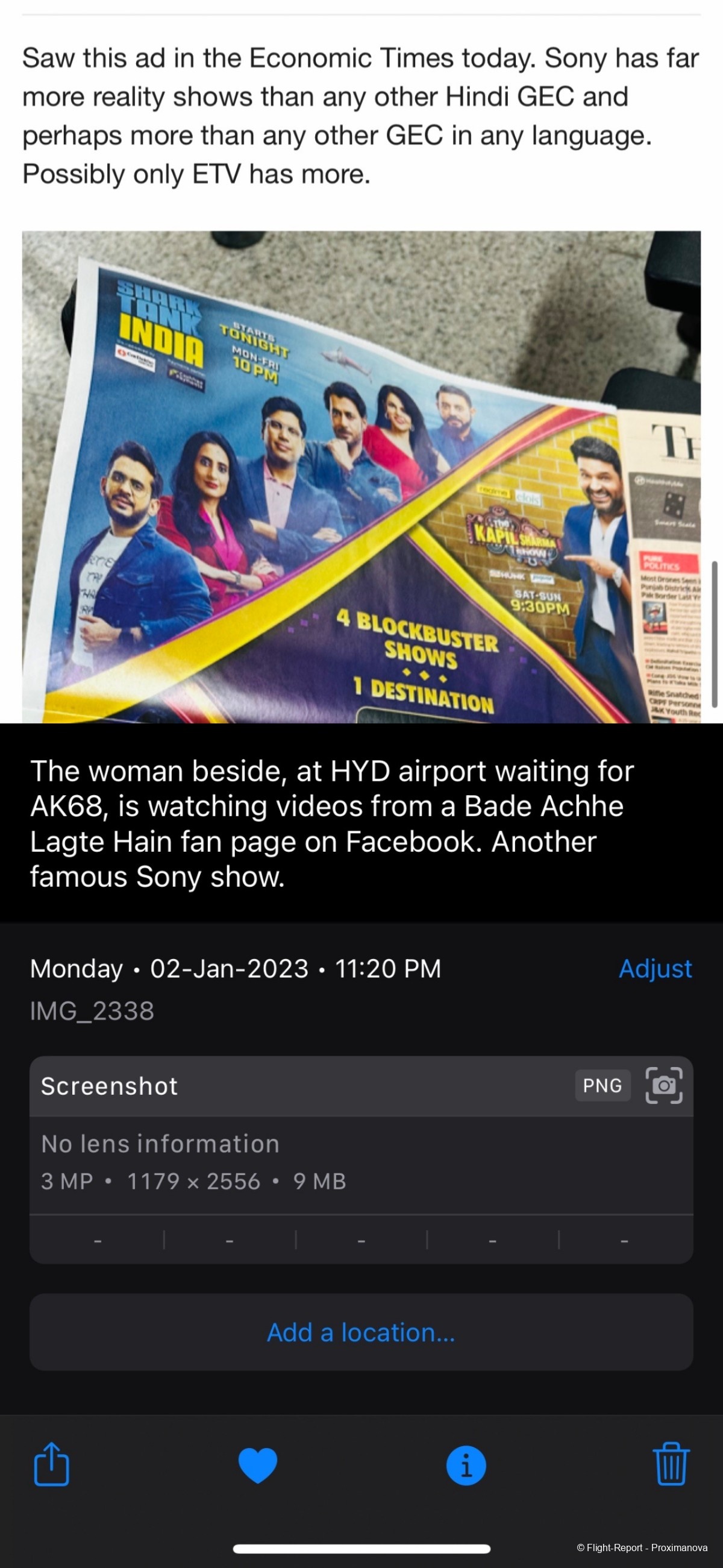
On reaching gate 23A, I filled in one half of my journal, there being not much to write about anyway — other than the fact that I’d found out that the aircraft operating the AK705 leg the following morning would be 9M-RAV, the airline’s latest sharkletted A320ceo.
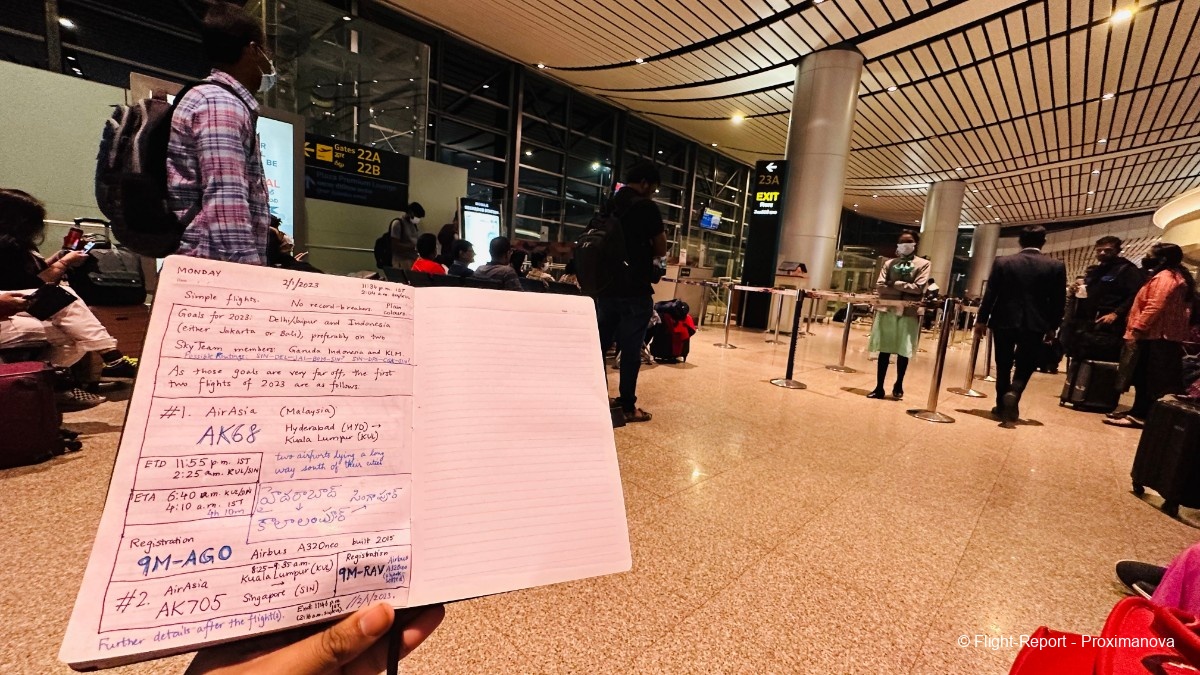
I had one last look at the WHSmith on the other side of the glass barricade, as the passengers lined up, waiting for their turn to board AK68.
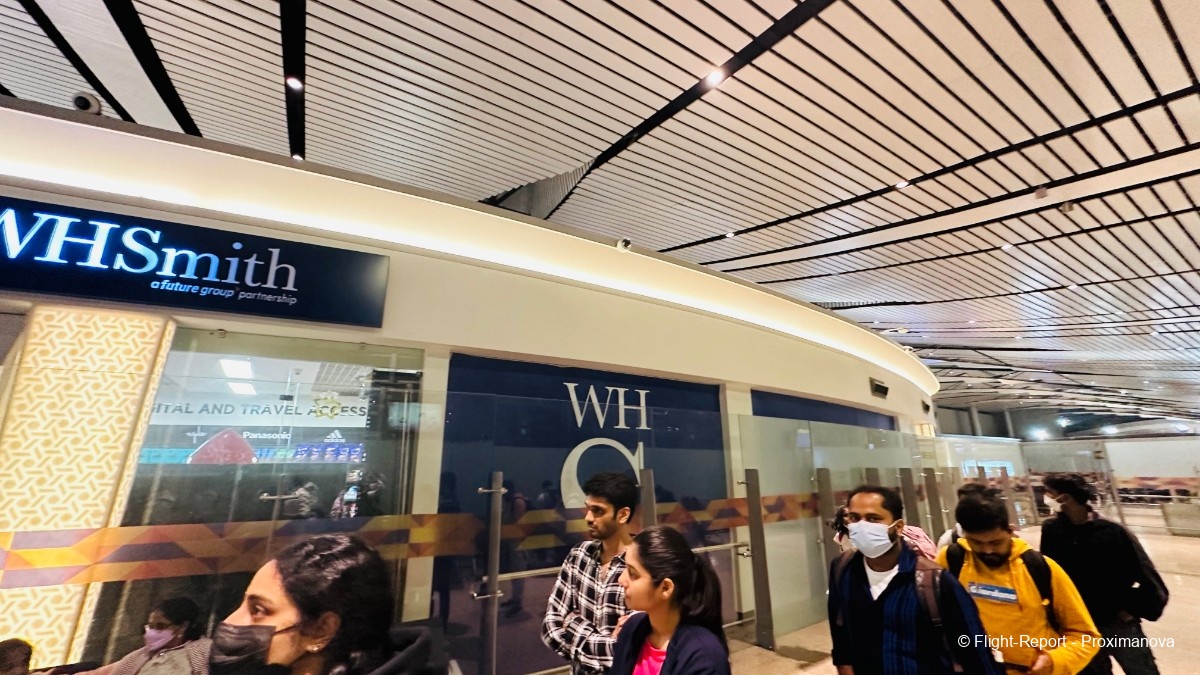
It was nearly midnight now, and 9V-MBJ had long since left for Singapore. The departures were all to Southeast Asia until 1:30am, and to the Middle East thereafter — barring, of course, BA to LHR, as well as regional flights to Colombo and Dhaka. Funny that Gulf Air and BA had similar flight numbers: 275 and 276, respectively.

Two Southeast Asian LCCs’ A320s were boarding at adjacent gates, but while 9M-AGO was all ready and waiting, 9V-TRN had not even landed from Singapore.
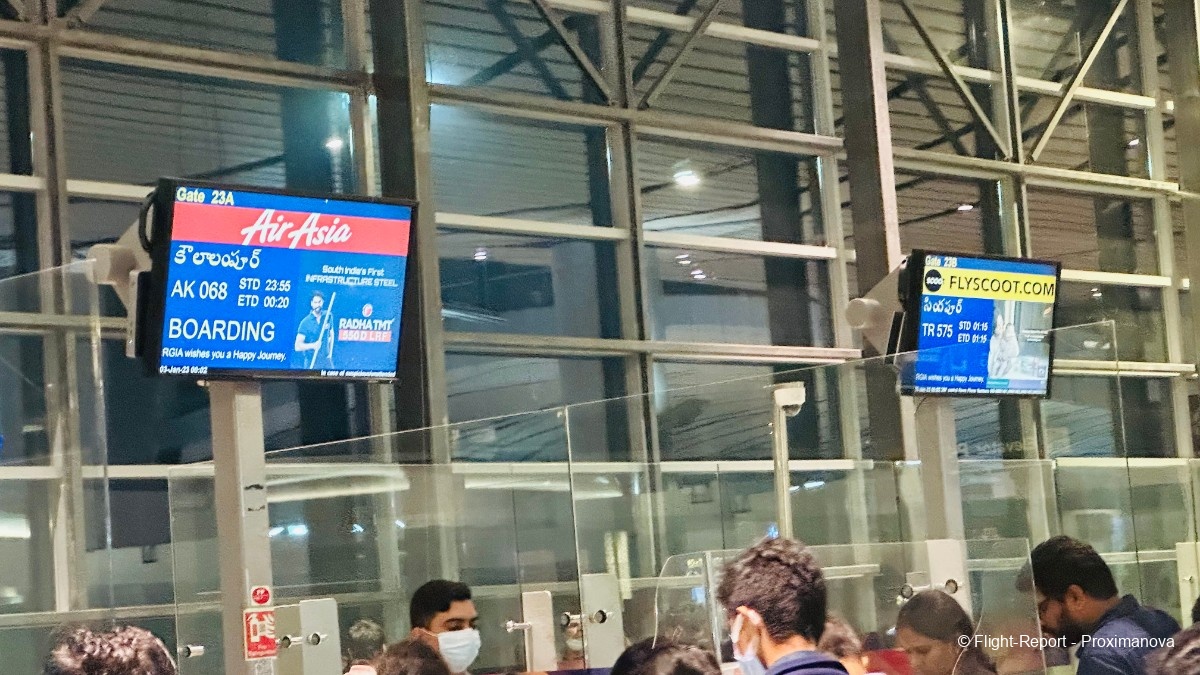
As I often see is the case, boarding signs for an unrelated airline — in this case Etihad — were placed nearby. I think Etihad has one of the best corporate fonts of any airline in the world. Has Air India Sans managed to beat it? Almost!
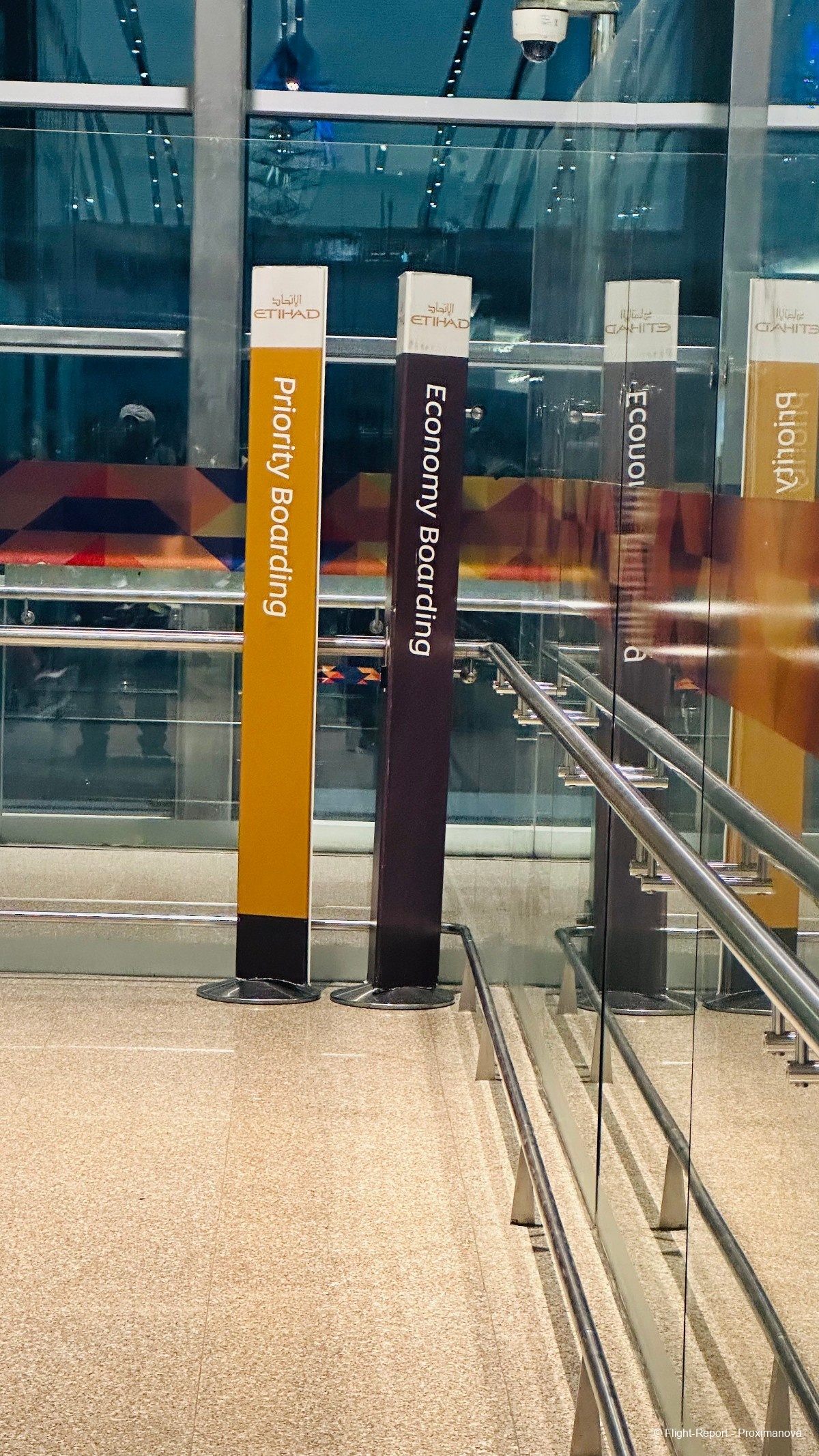
Now I went one level down to the boarding gates, as the plane waited outside.
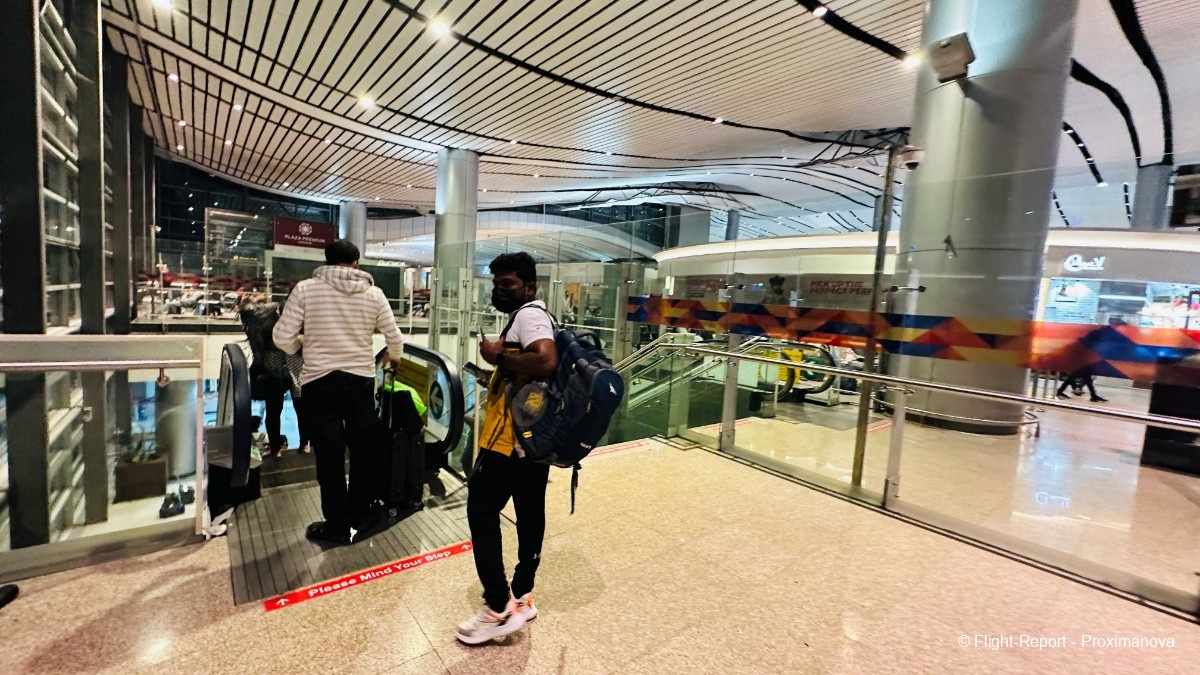
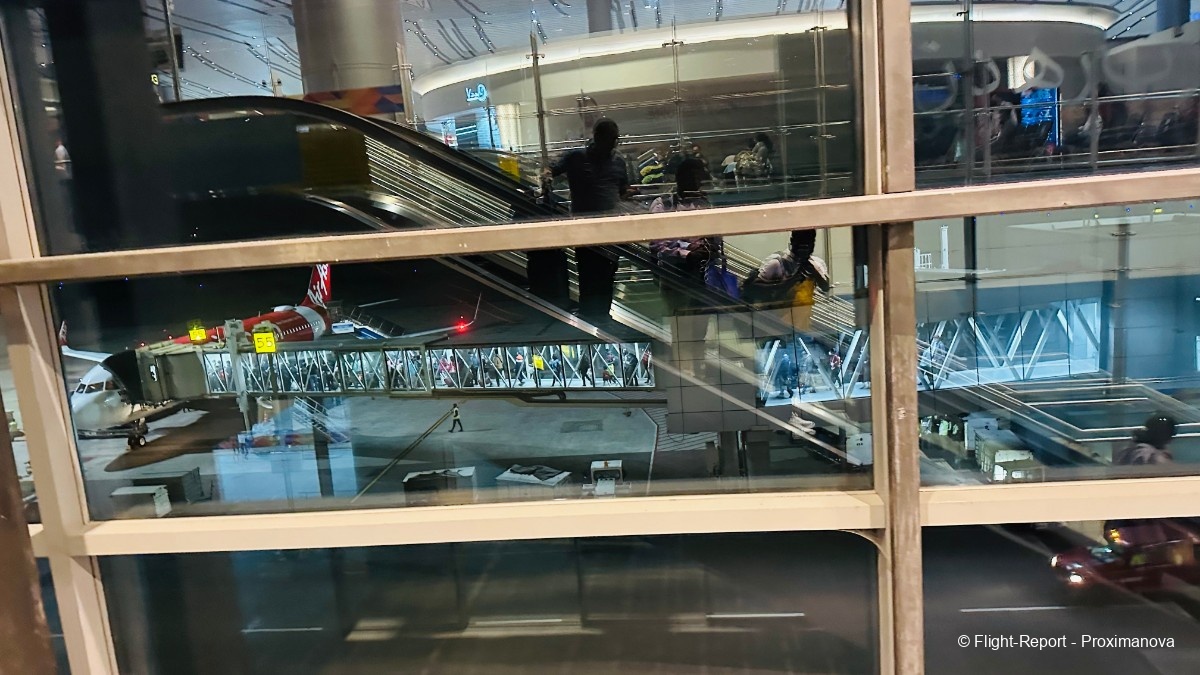
Out of Exit 23A and down the jetbridge we went — the last non-HSBC-branded jetbridge (at Changi, that is; the ones at KLIA have no ads inside) for the next three months.
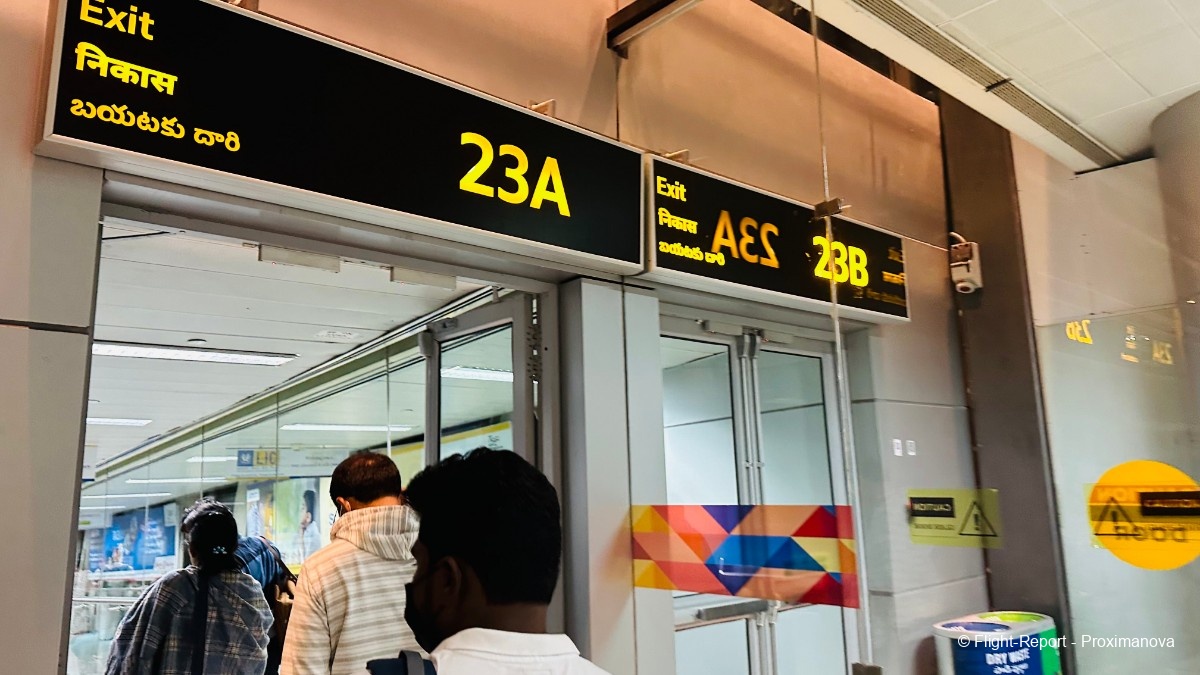
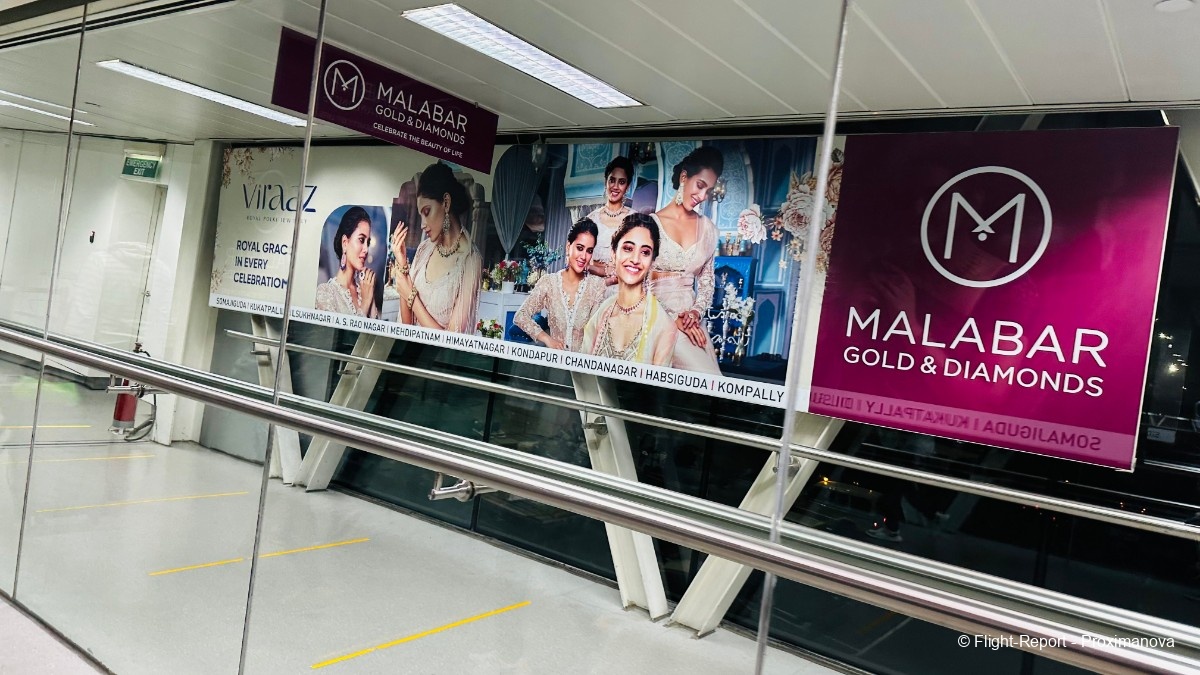
The tell-tale radome hump on the back is not what I would ever have expected from a low-cost carrier. SpiceJet is the only Indian LCC which ever came close, but it did not come around to implementing any Wi-Fi.
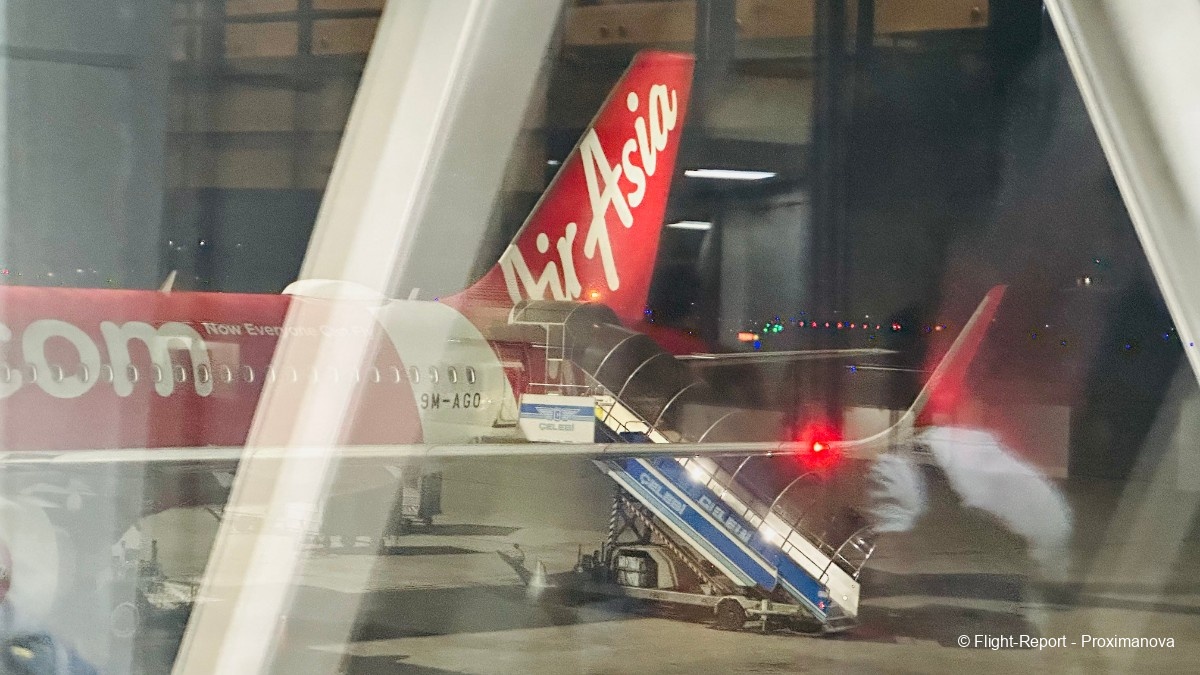
Only if you go beyond IndiGo will you know that Wi-Fi-enabled LCCs do exist in South and Southeast Asia. And so it was that I stepped on board possibly the best low-cost flight I have taken in a long time, perhaps even better than I5612 the previous Tuesday by virtue of its catering and inflight map, even though AirAsia India’s AirFlix system is possibly the best of any Indian airline for its UI.
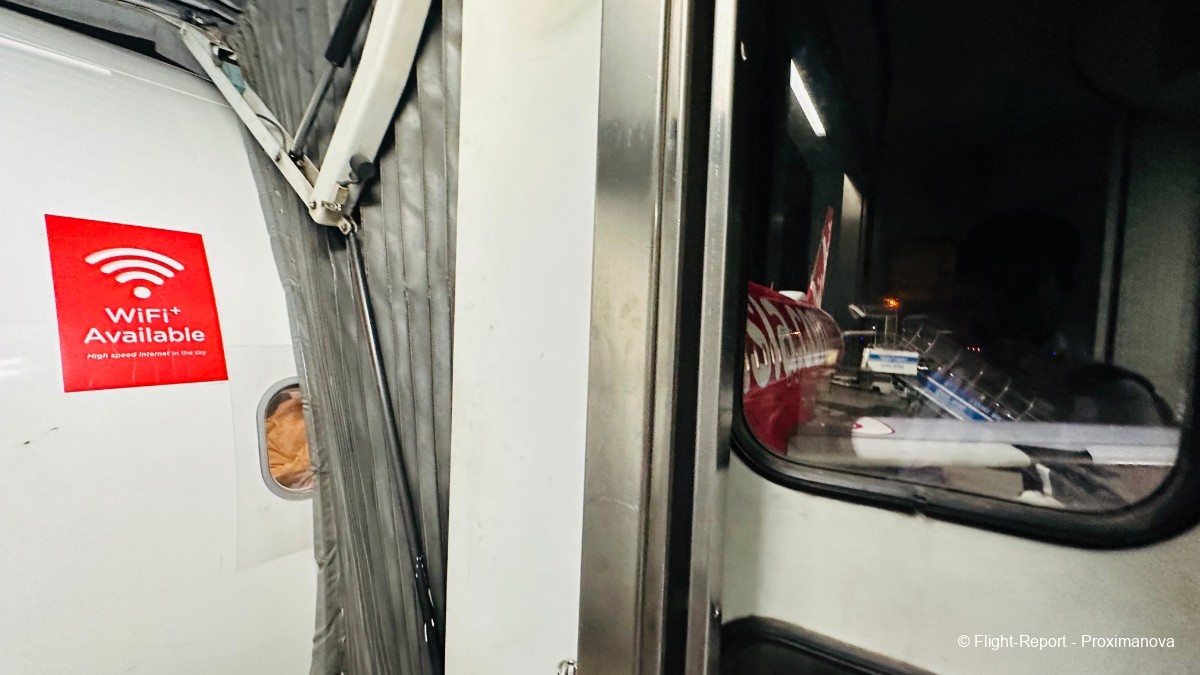
The flight: Boarding and departure
Flight: AirAsia (Malaysia) AK68/AXM68
Date: Tuesday, 3 January 2023 (booking date considered as Monday, 2 January 2023)
Route: Hyderabad Rajiv Gandhi (VOHS/HYD) to Kuala Lumpur International (WMKK/KUL)
Aircraft: 9M-AGO, Airbus A320neo (fourth A320neo ever built)
Age: 7 years 3 months at the time (built as D-AVVB, Airbus testbed: 29 September 2015, delivered to AirAsia: 1 December 2017)
Seat: 22F
Boarding: 12am IST, UTC +5:30 (2:30am MST, UTC +8)
Departure: 12:45am IST (3:15am MST)
Arrival: 7:25am MST (4:55am IST)
Duration: 4 hours 10 minutes
Notes:
• First flight on AirAsia (Malaysia) since four flights on them in October 2013 (MAA–KUL–SIN), which were my first-ever international flights. These were followed by four more on Thai AirAsia in May 2016 (MAA–DMK–CNX).
• First two-digit flight number since flying the late-night 6E53 (which has now changed to 6E1001) for the last time in 2020. With the exception of 6E6825, every single one of my other flights since 2021 has had 3-digit flight numbers.
• This aircraft had a lengthy storage period, with no flights from March 2021 to October 2022. If this were IndiGo, the plane would have been retired on crossing the six-year mark.
Big ads for the airasia Super App covered the overhead bins. It primarily targets its home country of Malaysia, and to a smaller extent Thailand and Indonesia, whereas in Singapore it is unheard of as it has yet to come up with a strategy for taking on the Grab–Gojek duopoly.
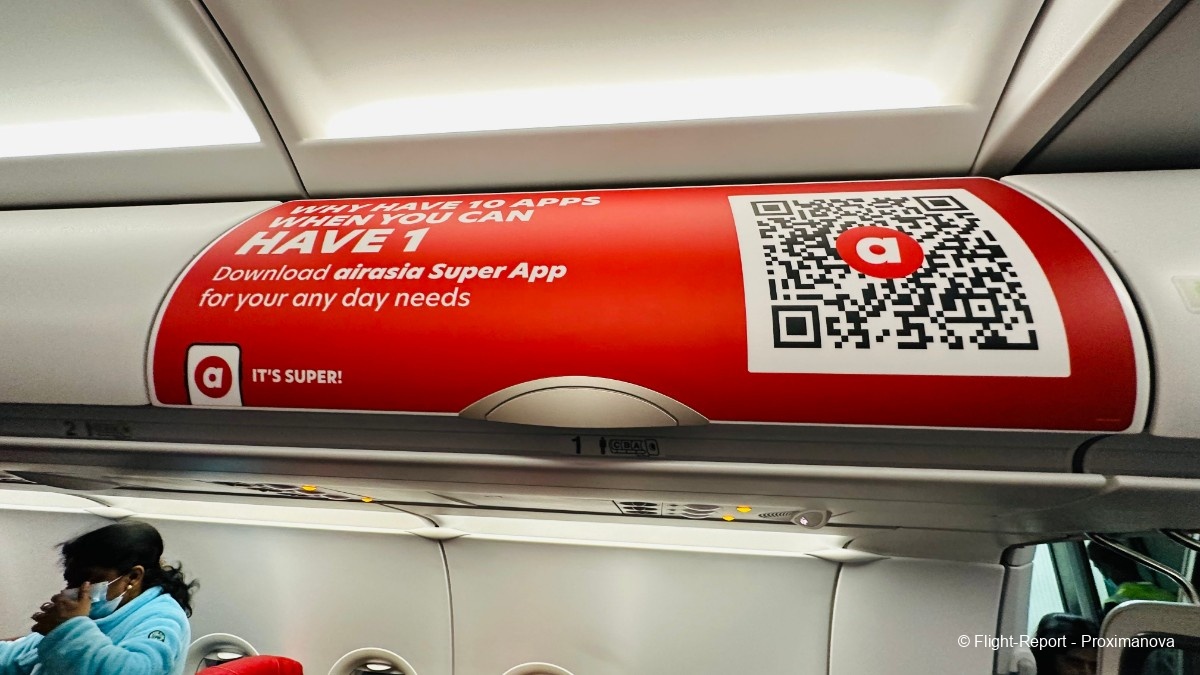
People had started to settle into the dark black leather seats.
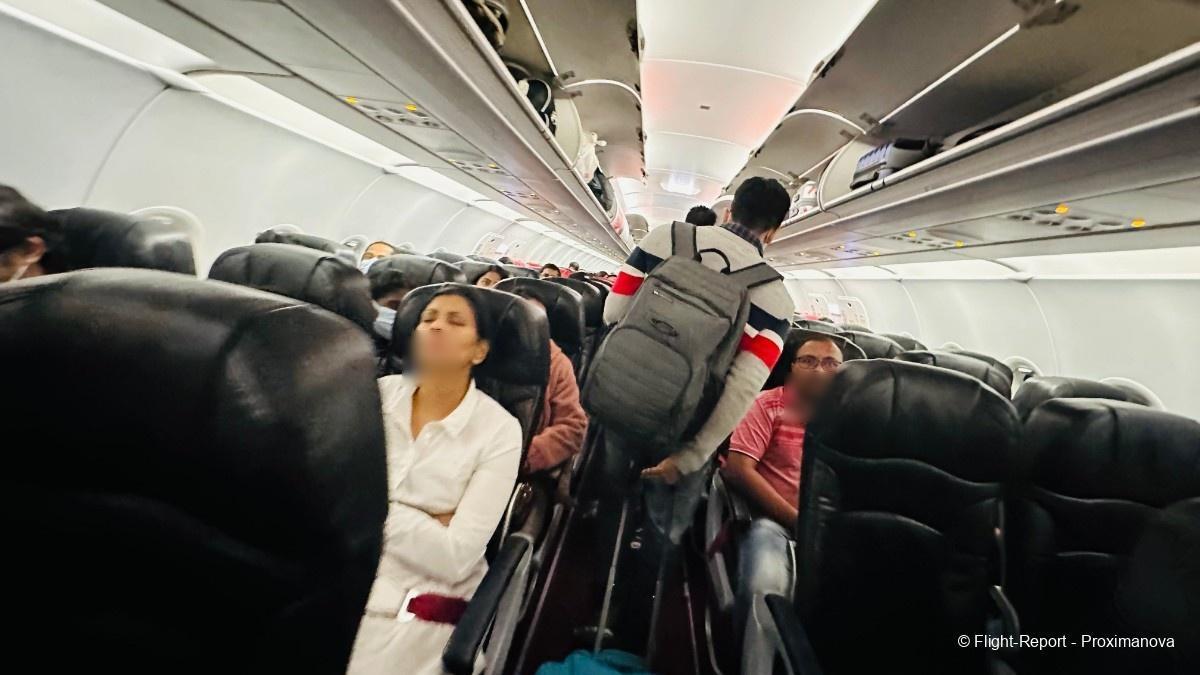
Beside us was Malaysia Airlines’ 9M-MXX, a 737-800 that would follow us to KUL as MH199. Historically far more 737s than A320s in South and Southeast Asia have offered seatback IFE, thanks to Garuda Indonesia, Malaysia Airlines and more recently Singapore Airlines — not to mention the erstwhile Jet Airways — adopting the 737, whereas neither Air India nor ASEAN operators like Vietnam Airlines have seatback or streaming IFE. (At least VN has overhead monitors, which no one in India has ever had.) The all-Airbus SriLankan Airlines and the soon-to-be-gone Vistara are the only A320-family operators in the region with seatback IFE.
However, with MH progressively eliminating seatback IFE on its 737 fleet and moving to streaming IFE — including on its new 737 MAX — at least one of them is going in a different direction, while on the other hand I hope Air India finally starts to introduce it on at least a small subset of its A320-family planes once its merger with Vistara (whose cutting-edge A321neo I’ve flown once and written about several times) is complete.
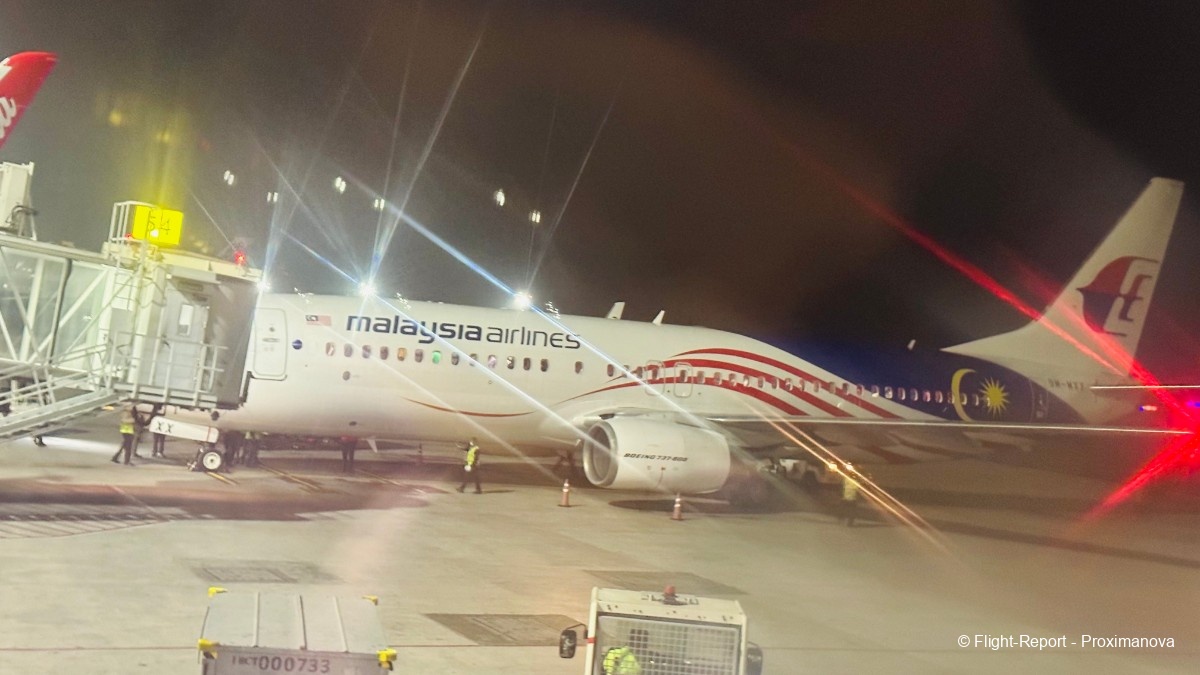
But a low-cost carrier won’t have seatback IFE anyway — not even on widebodies — and so this was the very best thing it could offer: a wide, if data-limited, Wi-Fi offering coupled with free (but rather useless) entertainment offerings. There was also a feature to test if a particular flight number had airasia wifi, and funnily enough this flight (AK68) didn’t show as having it — yet the inbound AK69 did.
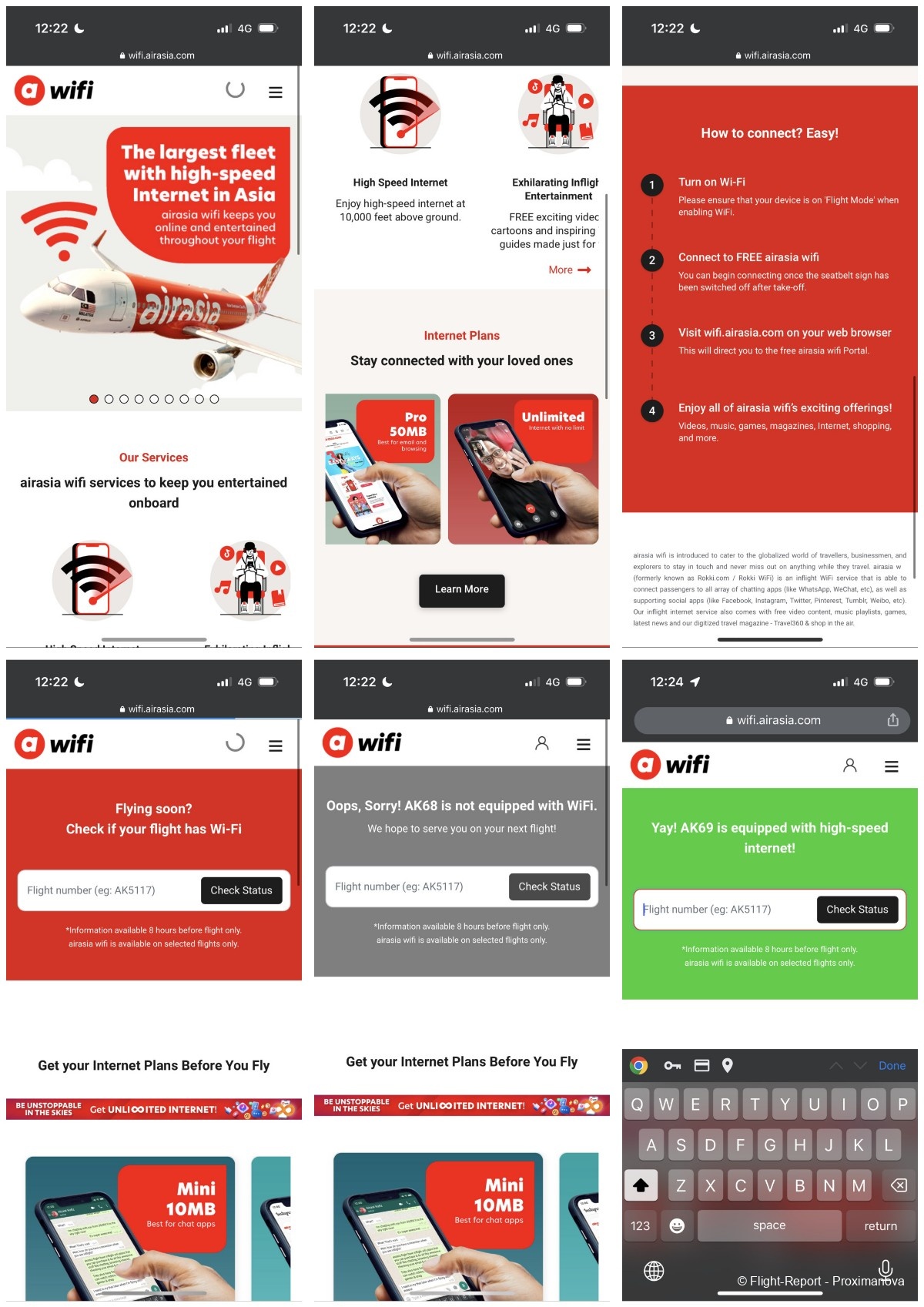
The Santan menu and duty-free catalogue had a bewildering variety of options, and indeed Santan restaurants have opened across Kuala Lumpur and other parts of Malaysia. During my visit there in May 2023, I was disappointed to find that the one in NU Sentral, adjoining the megahub KL Sentral station, had closed down! But I also did pass by the one in Mid Valley Megamall, perhaps the largest mall I’ve ever been to after The Dubai Mall, which has a smaller Santan Café.
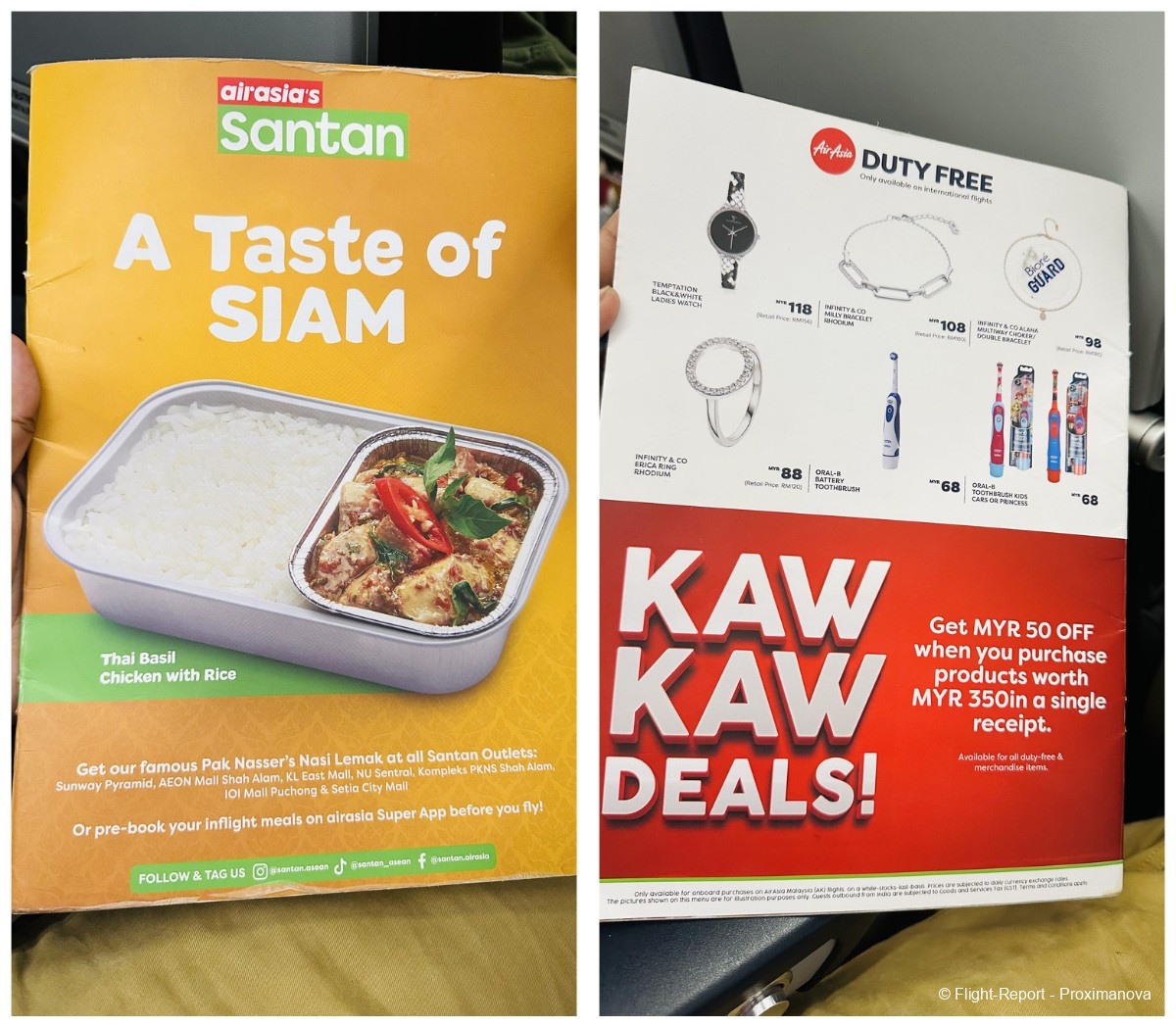

How much airasia food and airasia ride will stand up to the power of Grab and Gojek I won’t know, because the former has given up on Singapore, and the latter will not have an easy way in. At the back was a somewhat strange ad for the Philippines’ Special Resident Retirees’ Visa, which I had no idea existed.
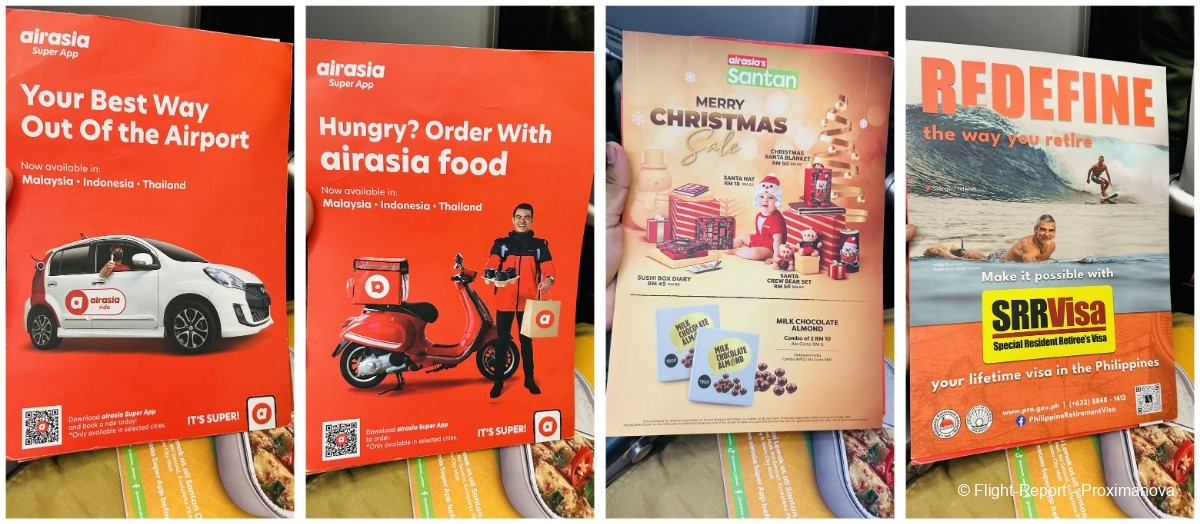
This was the safety card, which I’m slightly surprised was not the version with the smiling boy in black and girl in red — hands folded in a namaste (or, rather, a selamat datang) — as I’ve seen on AirAsia safety cards in the past.
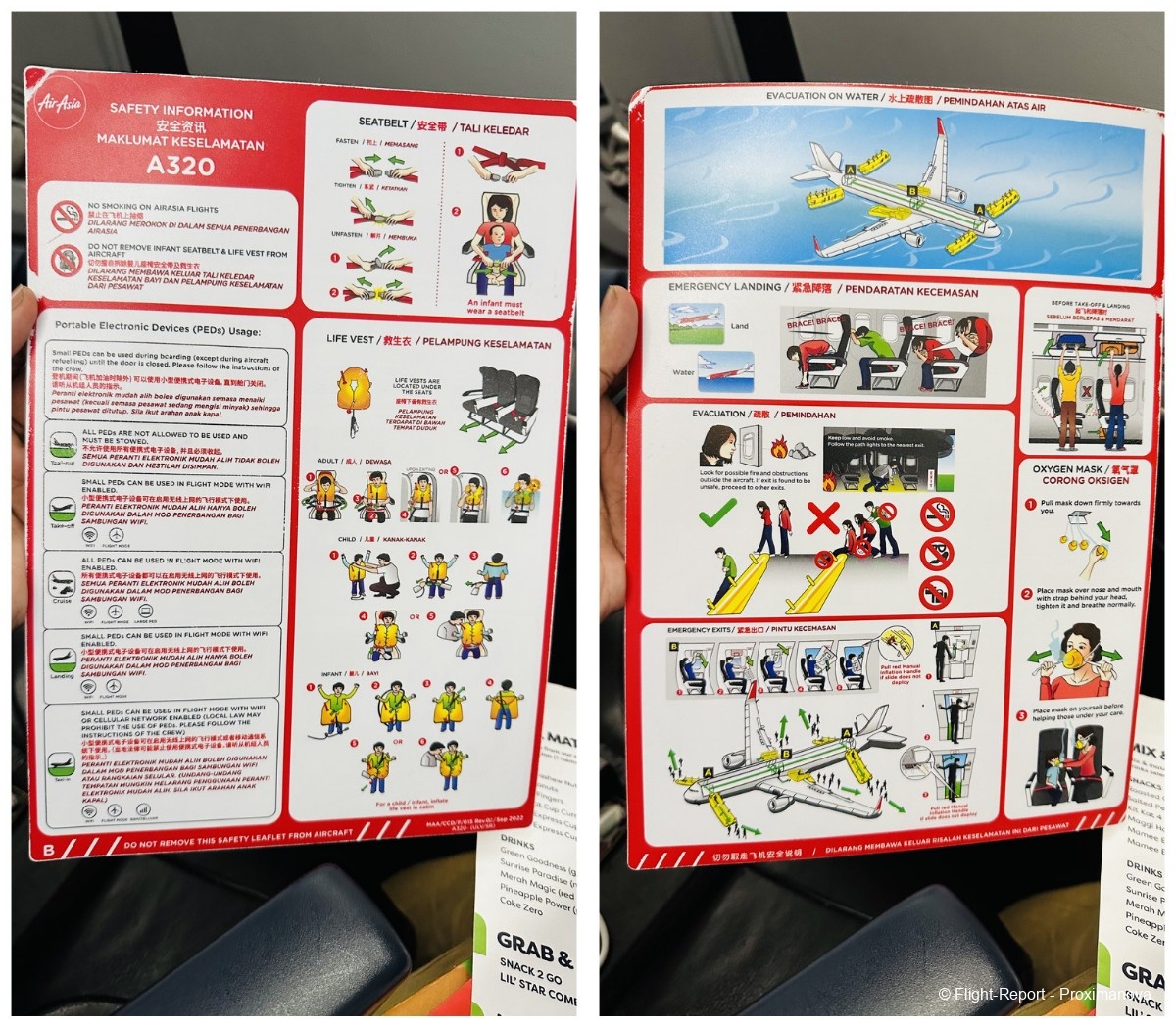
No special mood lighting on this A320neo — only the standard-issue white lights, which would have been super-boring if not for the bright red ads targeted at those who were super-hungry or with super-itchy feet.
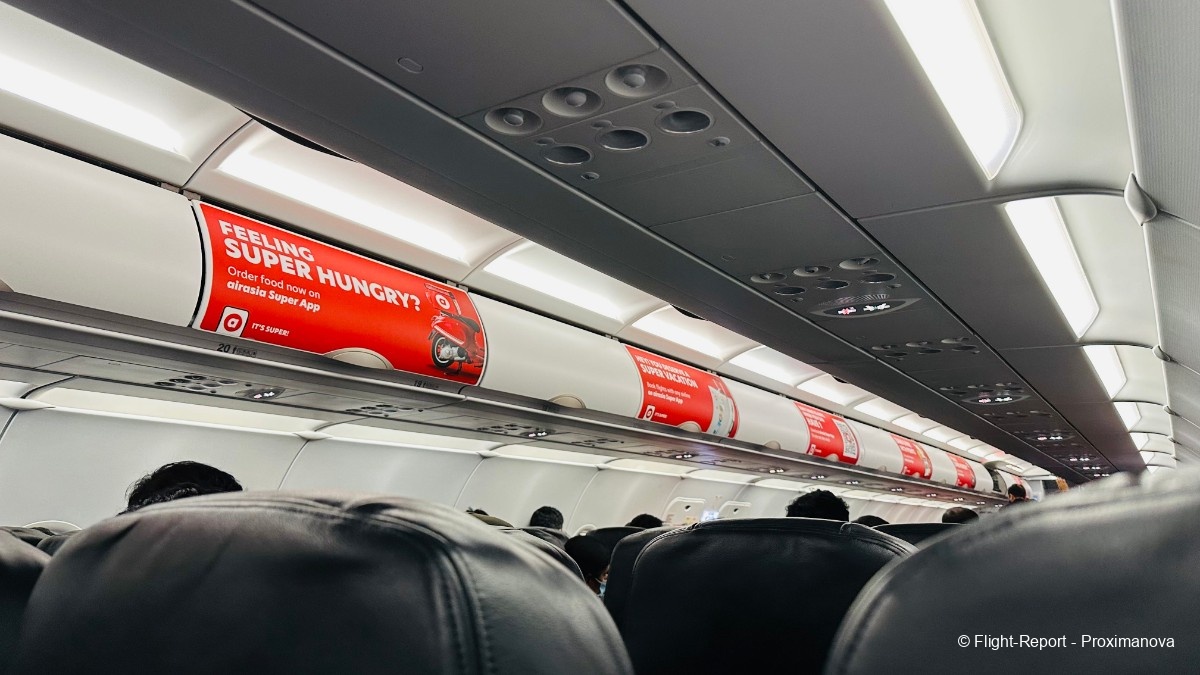
I was not a little shocked to see an A320 (B-50006) of Tigerair Taiwan — a subsidiary of China Airlines, and now the only Tigerair airline left in the world — fly all the way from her home in Taipei to Hyderabad for goodness knew what. Also nearby were HS-TQE, one of six 787-8s at Thai Airways, and also a 737-800 of Quikjet Airlines operating on behalf of Amazon Air, which has made HYD its Indian base.

As we taxied out we passed by VT-IIU, which I believe was also headed to an international destination, I can’t say what from my Flightradar24 screenshots. In any case I have no wish to fly IndiGo on international routes, least of all at night.
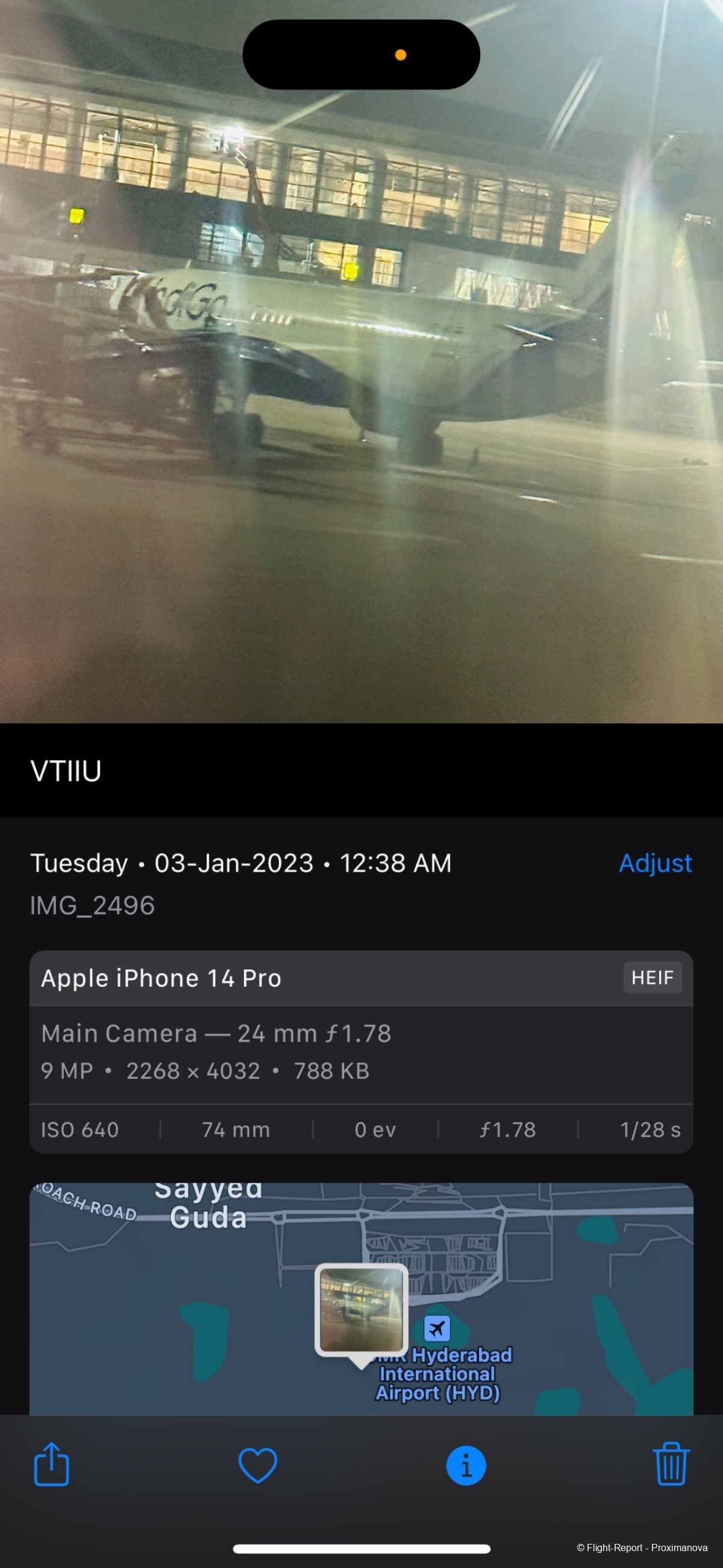
At half-past twelve we were already on the way to the runway, which was surprisingly devoid of the rows and rows of IndiGo and other aircraft you typically see at Indian airports.
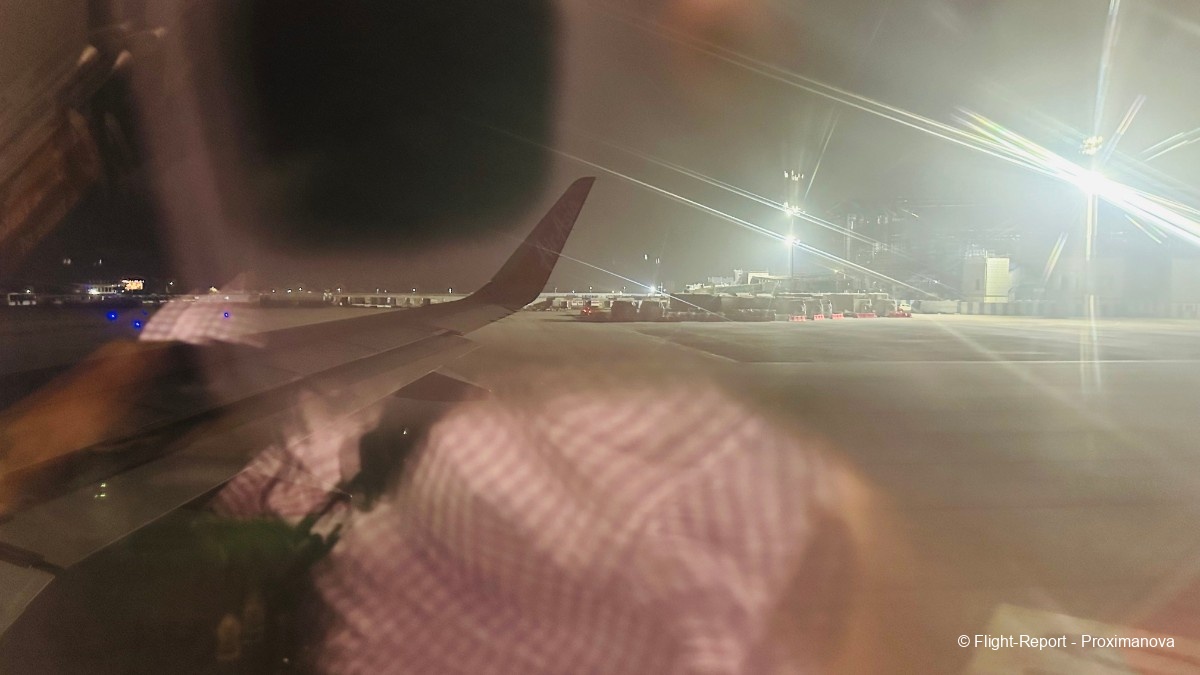
With the blue lights from the runway and the green lights from the wing for company, we blasted off at around 12:45am, bringing an end to my ten-day-long sojourn across three South Indian metros.
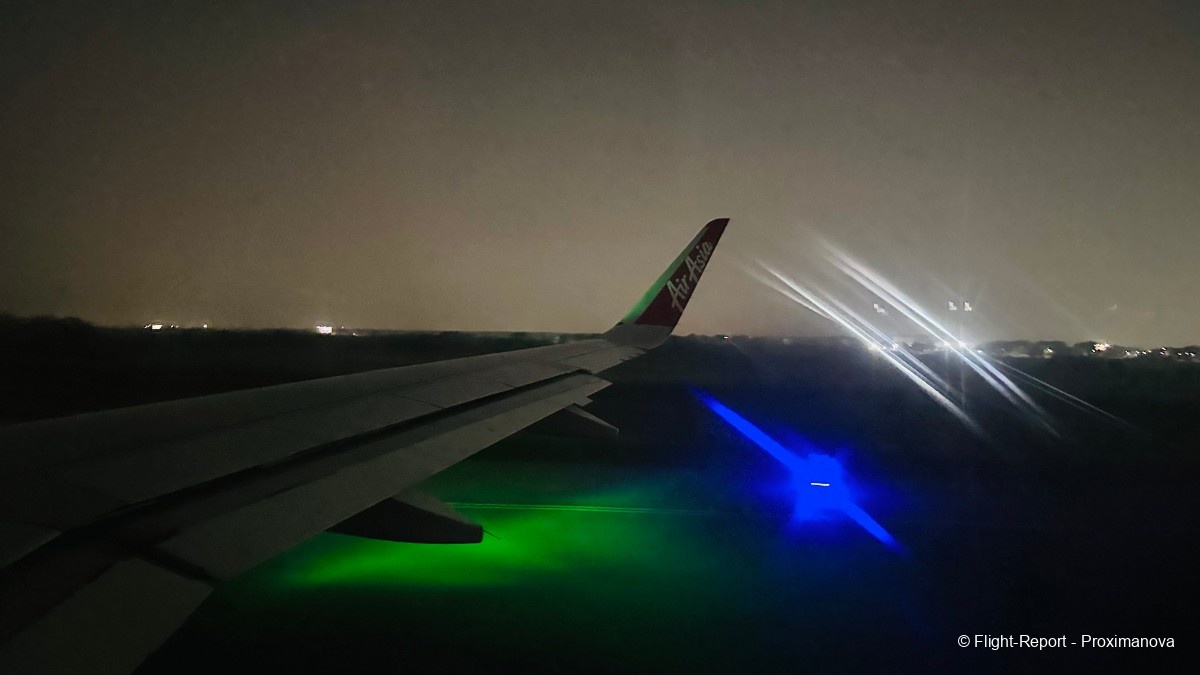
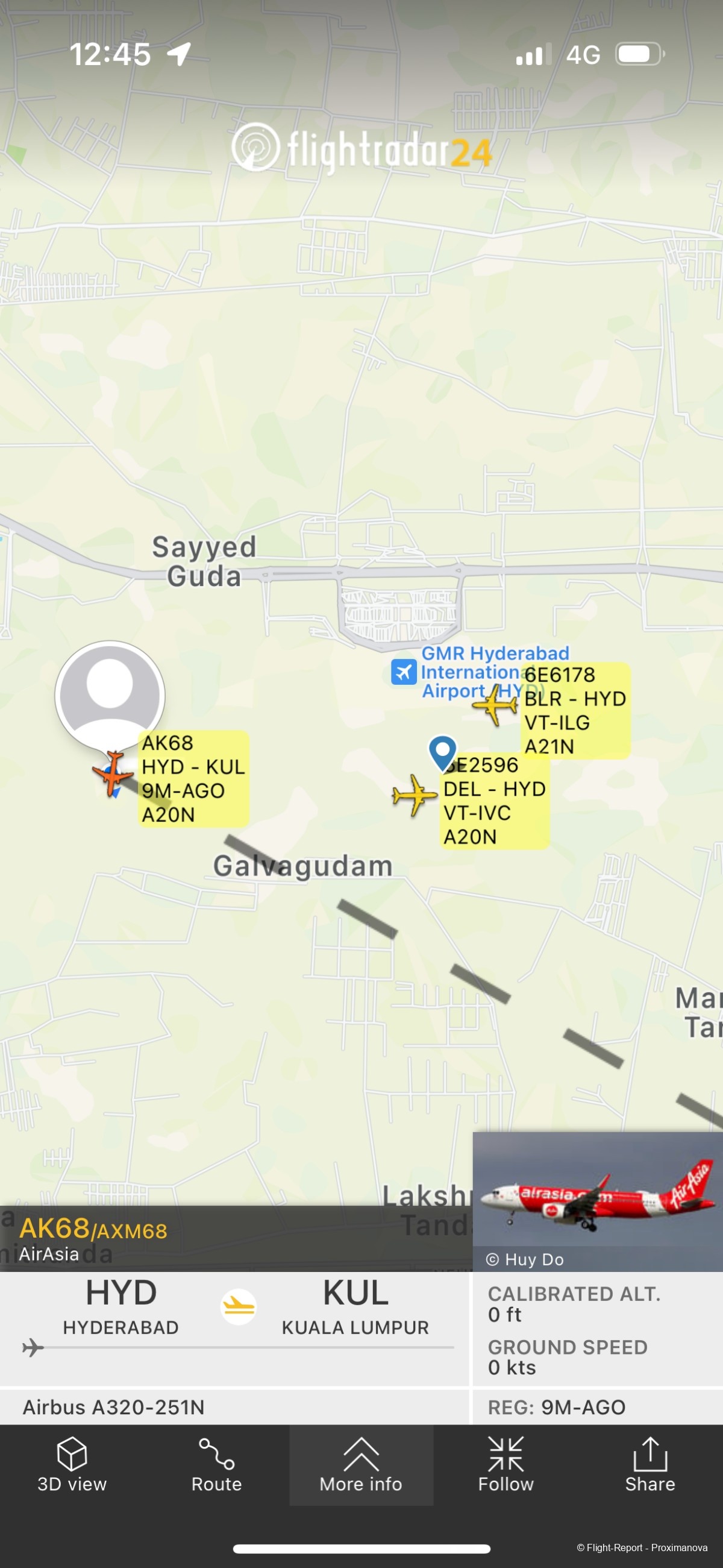
Catering, entertainment and (lack of) Wi-Fi
There was nothing but darkness outside — no splendid city lights outside the window, unlike during landing at Bangkok on Flight 714 — and the only noteworthy thing to happen was an announcement cautioning against the spread of monkeypox and preventive measures to be taken for the same. Unlike on an Indian airline, the cabin members’ names were not announced, which is not to be expected anyway.
Shortly after takeoff I browsed through the buy-on-board options, and there was quite the selection to be had, ranging from various hot and cold drinks, to noodles and sandwiches, to hot meals for purchase. I passed up on them as, of course, I had pre-ordered my hot meals, and what’s more I was not sure my debit card would work — which was confirmed soon enough.

When I tried to access the Wi-Fi portal, a pair of folded hands apologised for its non-availability over Indian airspace. Fair enough, since Singapore Airlines’ SITA OnAir Wi-Fi on its A380s, A350 Regionals and some 777-300ERs is similarly blocked over the country, but its other aircraft with their Panasonic Wi-Fi do not have this problem.

By way of entertainment was a large number of YouTube-esque videos, much of which was best suited for Malaysian audiences. I would have expected some movies or series to be offered, but such is not the case on AK, and non-Malaysians will have little choice but to play games, order food or check out the flight details. Still, far above anything else for an LCC in the region, certainly better than ScootHub which does little besides contactless food ordering, a few games and an inflight map — with Wi-Fi confined only to its 787s.
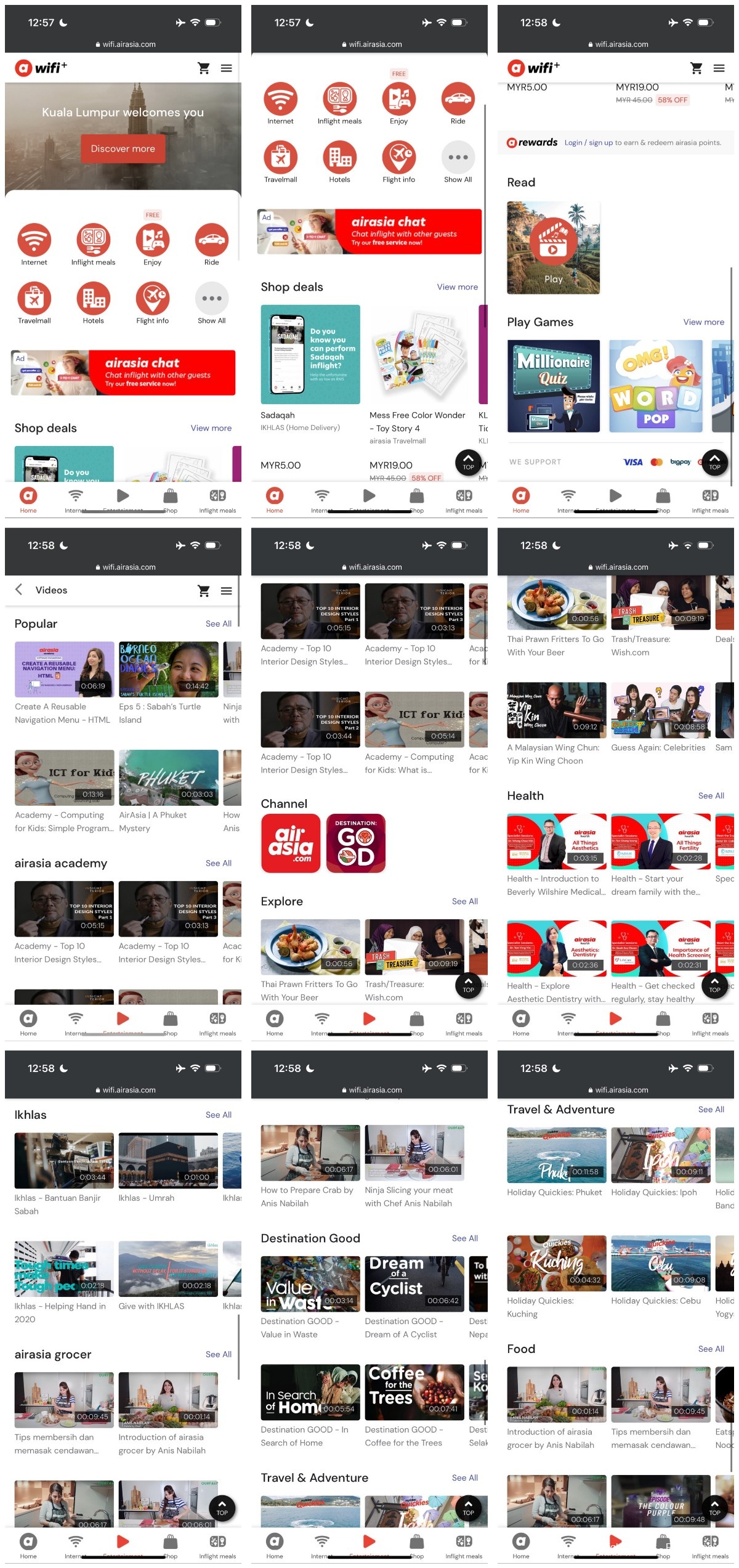
There was, astonishingly for an LCC, an inflight map showing the progress from origin to destination — replete with speed and altitude details — as well as some sights to visit in Kuala Lumpur, of which I visited the Batu Caves and a rooftop bar (Marini’s on 57) beside the Petronas Twin Towers during my May visit. Not even AirAsia India, with its far superior AirFlix system, had this moving map, and the difference between AK and IndiGo became even starker.
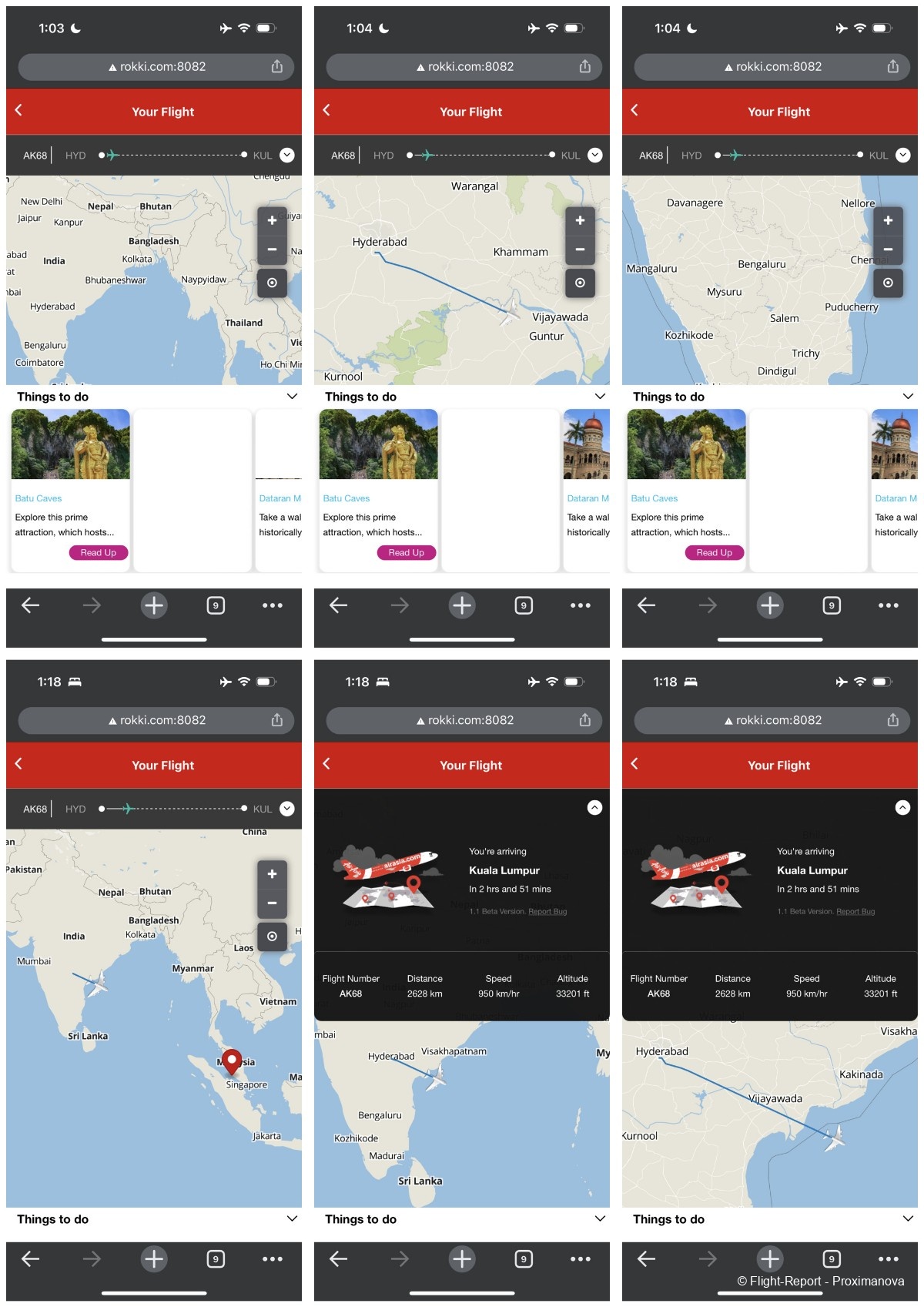
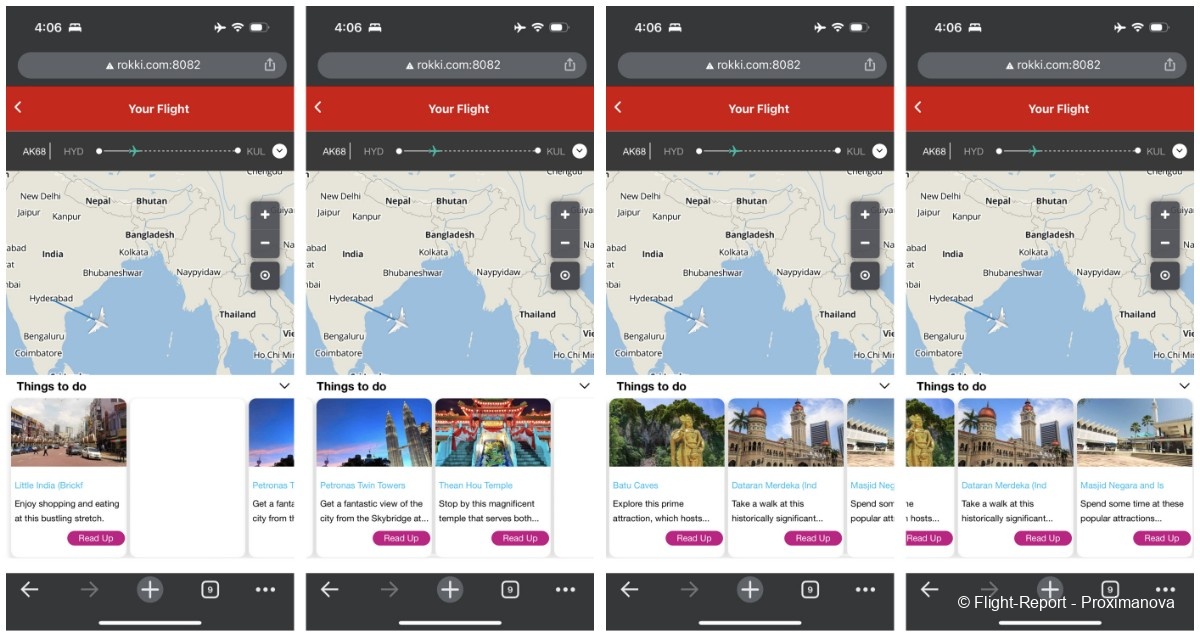
These were the Wi-Fi packages for purchase, but I have to say they were rather stingy, as 10 MB gets finished in no time, and a time-based solution would have been far better. Worse, those buying the Unlimited package have their speeds throttled to a piffling 128 kbps — practically nothing — after 200 MB is used up. Still, AK is head and shoulders above every other LCC in the region with a widespread Wi-Fi offering. However, my attempts to purchase the 20 MB plan went in vain, as the system refused to accept my card: not that I needed it on a redeye at four (Malaysia time)/half-past one (IST) at night, when sleep was the first order of business.
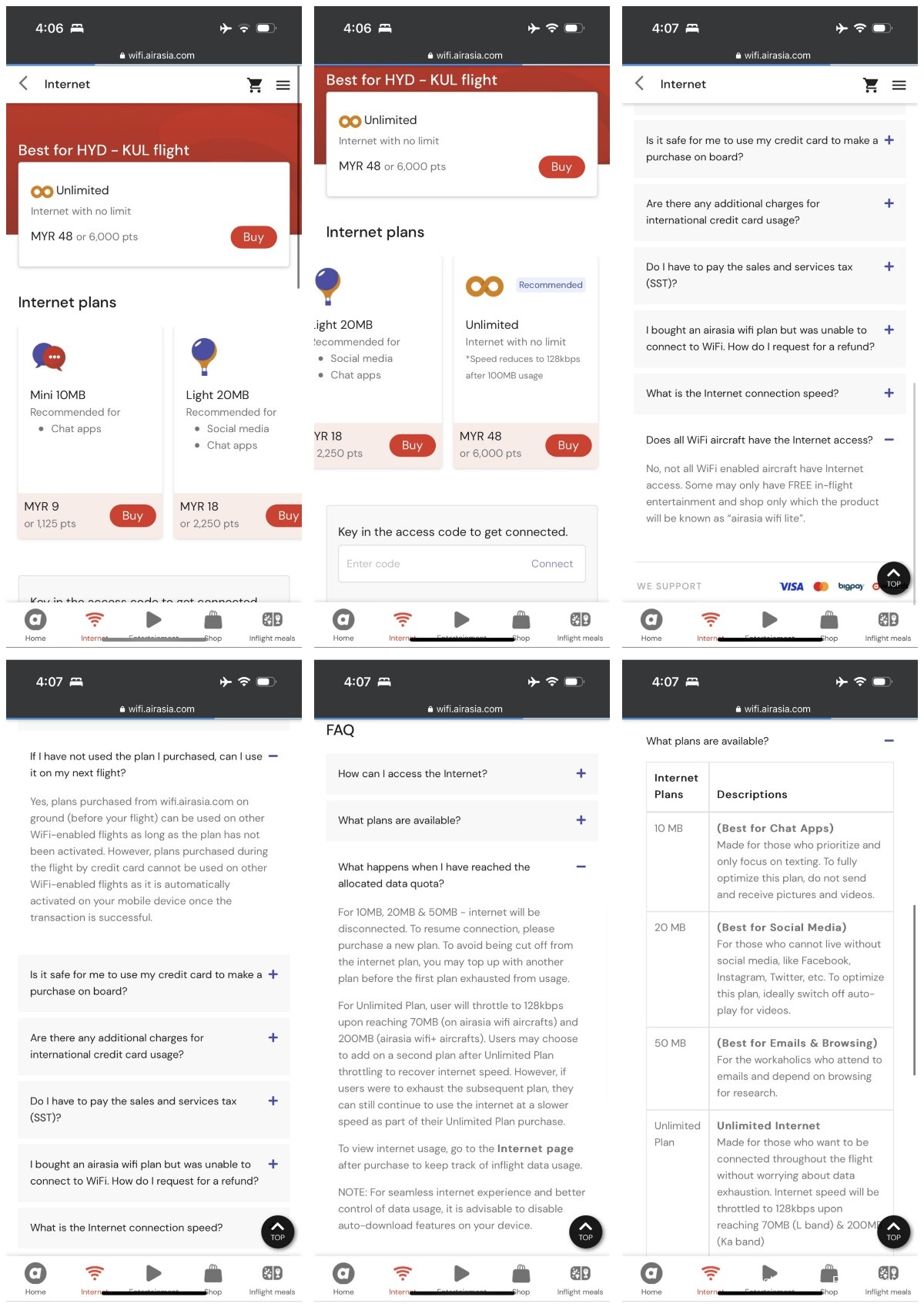
Before sleep came refreshment: the Bukhara Chicken Biryani and the Uncle Chin’s Chicken Rice (which I’d last had back in 2013 on my first-ever foreign trip to Singapore) were handed out, along with red plastic cutlery, a couple of sauces, some tissues and two bottles of Spritzer Air Mineral Semulajadi.
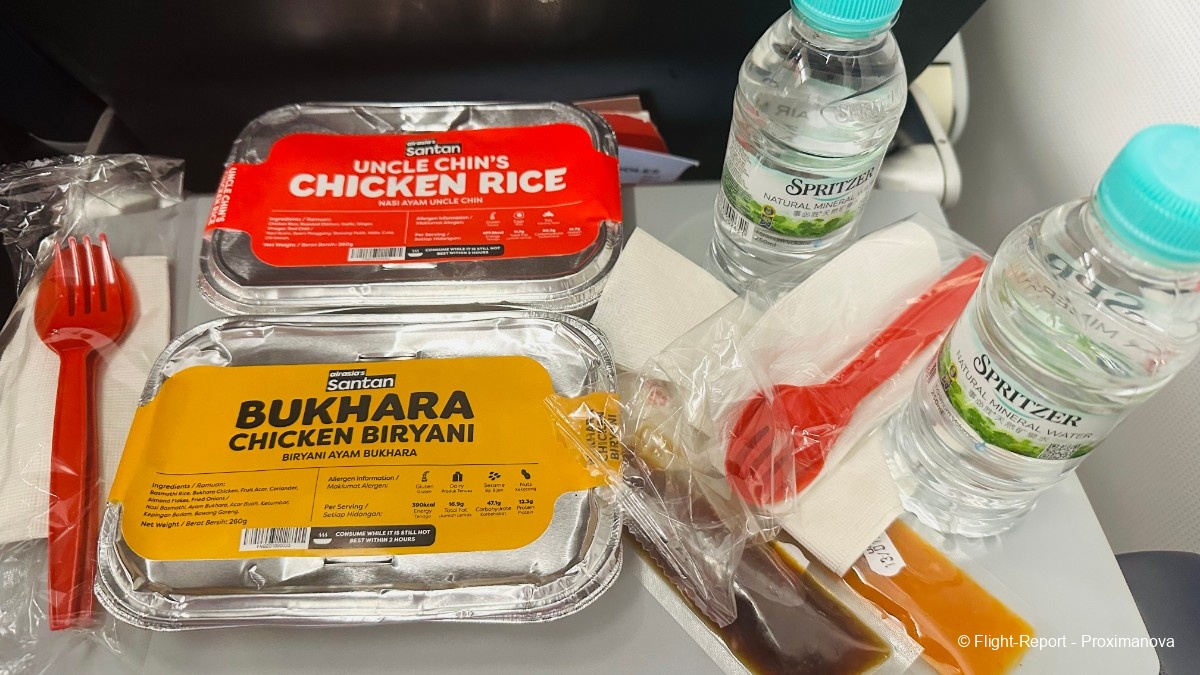
Needless to say, I enjoyed every morsel, especially the biryani, which was bursting with flavour and had a tasty sweet red accompaniment (apricot chutney?) to the side. No full-service airline will give you more than one meal, so AirAsia wins big-time here by allowing you to have two. Then again, no dessert or sweet side — you’ll have to order and buy from the entertainment portal.
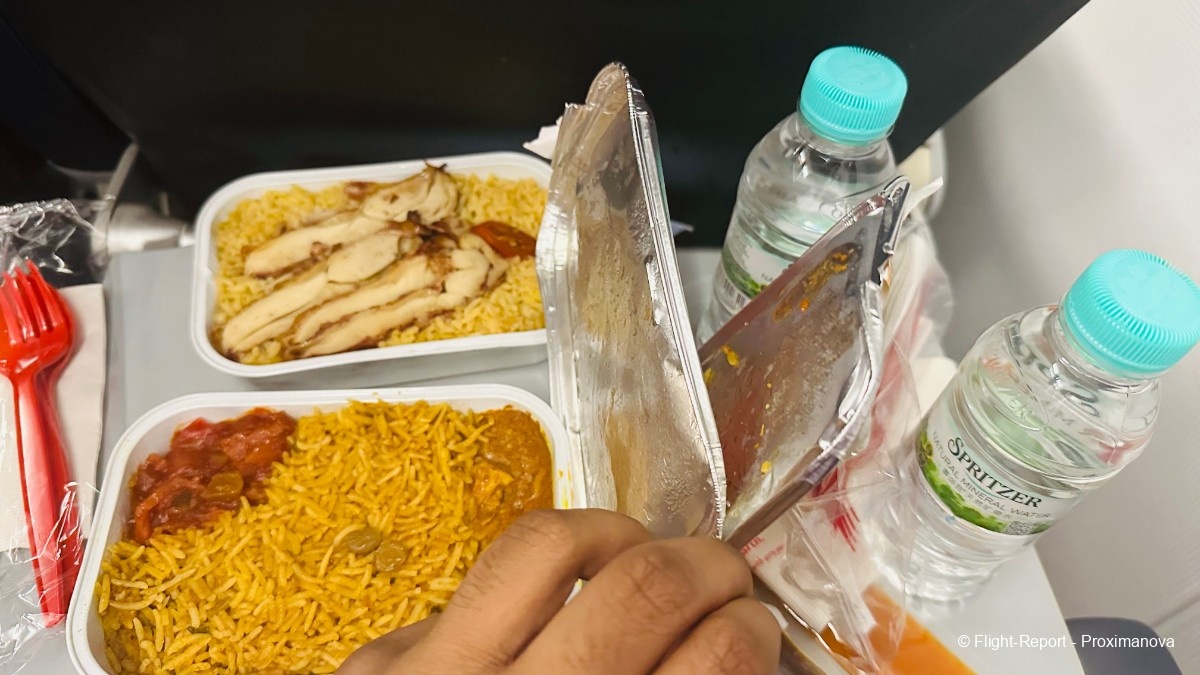
Only after I took a good hard look at the name badges of the two girls in the aisle — without being obnoxious, of course — could I confirm their names: Mayang S. Zebua to the left, Mai (that’s all her badge said) to the right. With them were two ‘men in black’: Hafiz and Ibrahim.
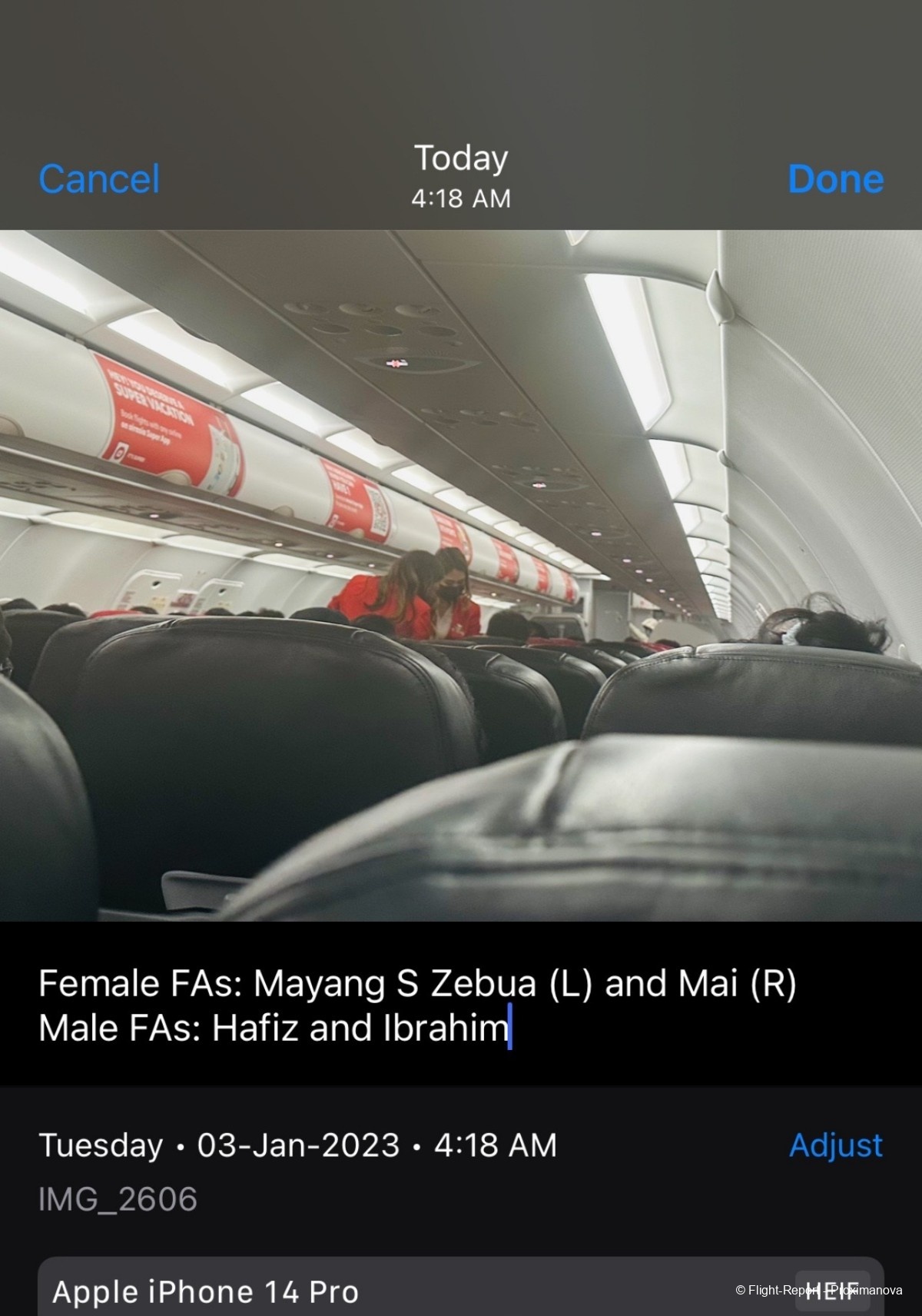
Shortly thereafter the lights were turned down, this being a redeye of course, and the only other thing I remember before drifting off to sleep above the clouds was asking Mayang S. Zebua for another cup of water. Her reply: it would cost RM4, something 6E would serve for free. As I had no ringgit on me — with the SGD conversion rate no good for the one-dollar coin I had — I let it pass.
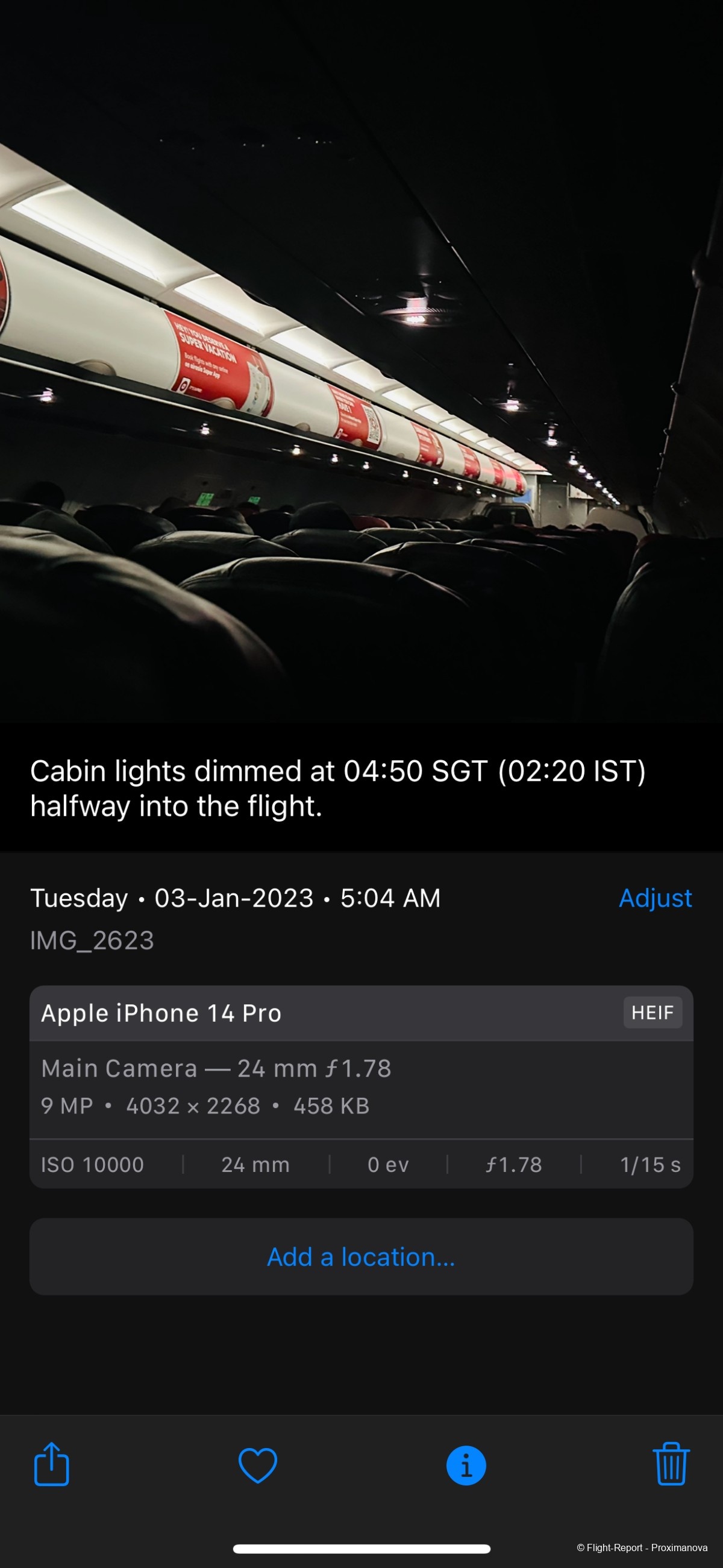
Descent at my favourite Far-South airport
At around 6:50am local time the clouds broke open and the sun made its appearance over the Malaysian coastline, with the dense green vegetation of the rainforest below.
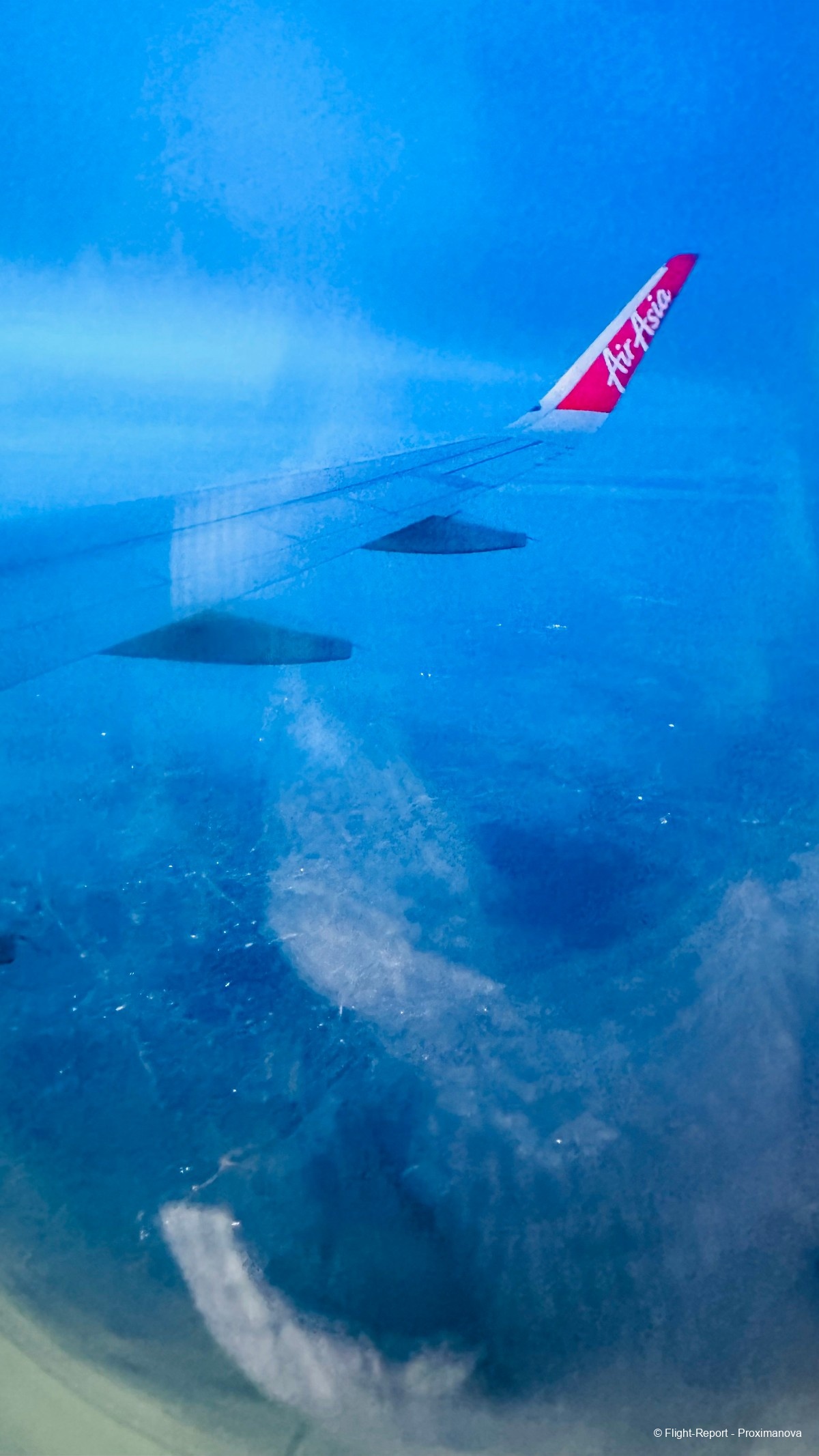

A streak of orange permeated the sky, with the red winglet and its serrations providing a contrast. We made our descent over the lush plantations surrounding Sepang, where KLIA is located, in the south of Selangor state and all the way down south from Kuala Lumpur, Shah Alam, Putrajaya and the greater Klang Valley.
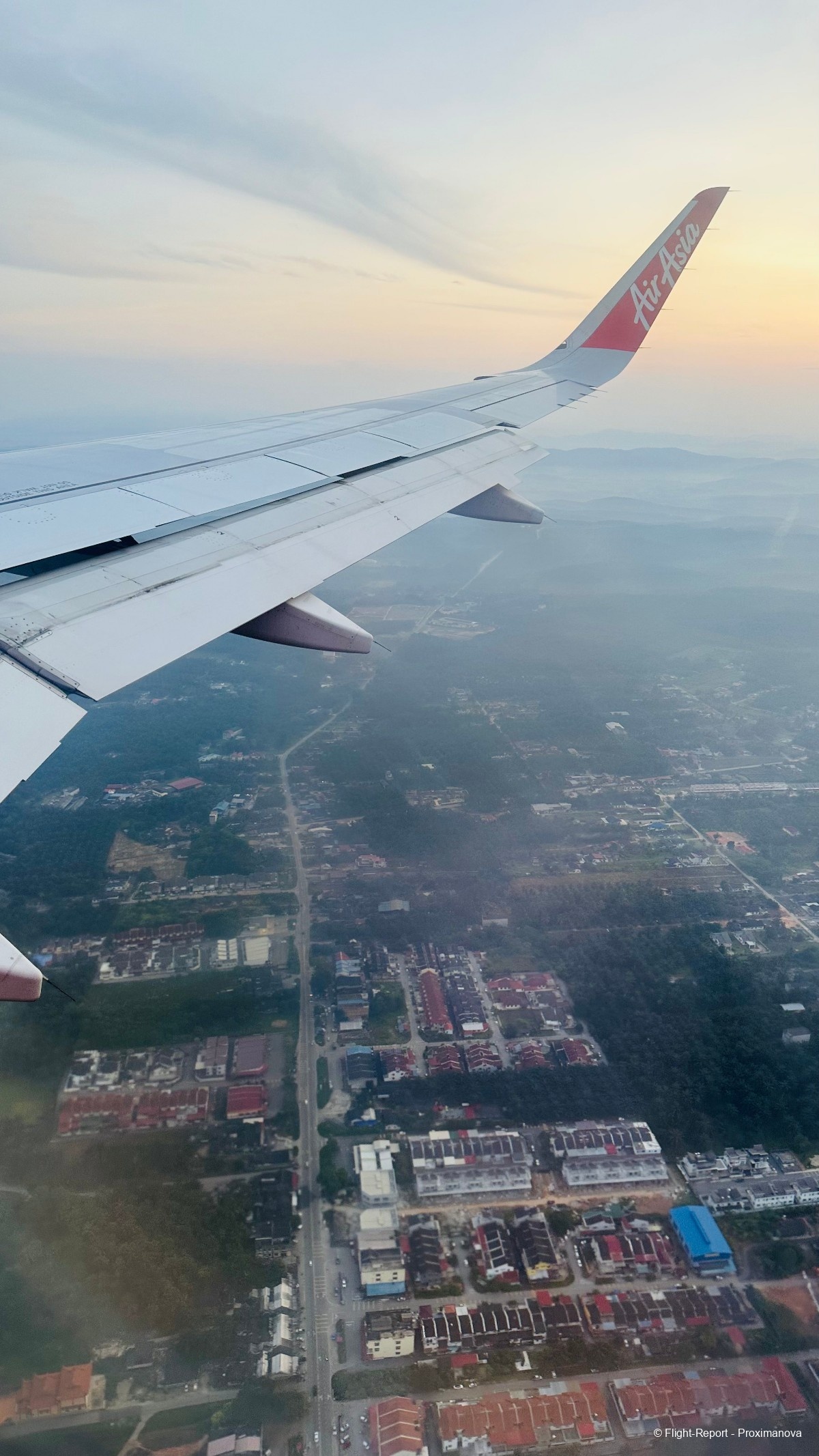
At 7:20 or so 9M-AGO touched down at the Airbus-dominated KLIA2, and as if to confirm that we were no longer at an Indian airport with their if-you-see-one-you’ve-seen-them-all IndiGo aircraft, a number of special liveries came into view — which goes to show just how much the AirAsia group loves special colours of all kinds, and just how much IndiGo abhors, hates, detests even the slightest modification to its standard scheme. (Very begrudgingly 6E added a sticker to A321neo VT-IUH to show that it was the 1000th A320neo-family aircraft produced, and some of its reintroduced aircraft, like A320neo VT-IKN, have an all-white fuselage like AirAsia’s 9M-AFO used to have. That aside, under no circumstances will 6E tolerate anything even remotely close to a special livery.)
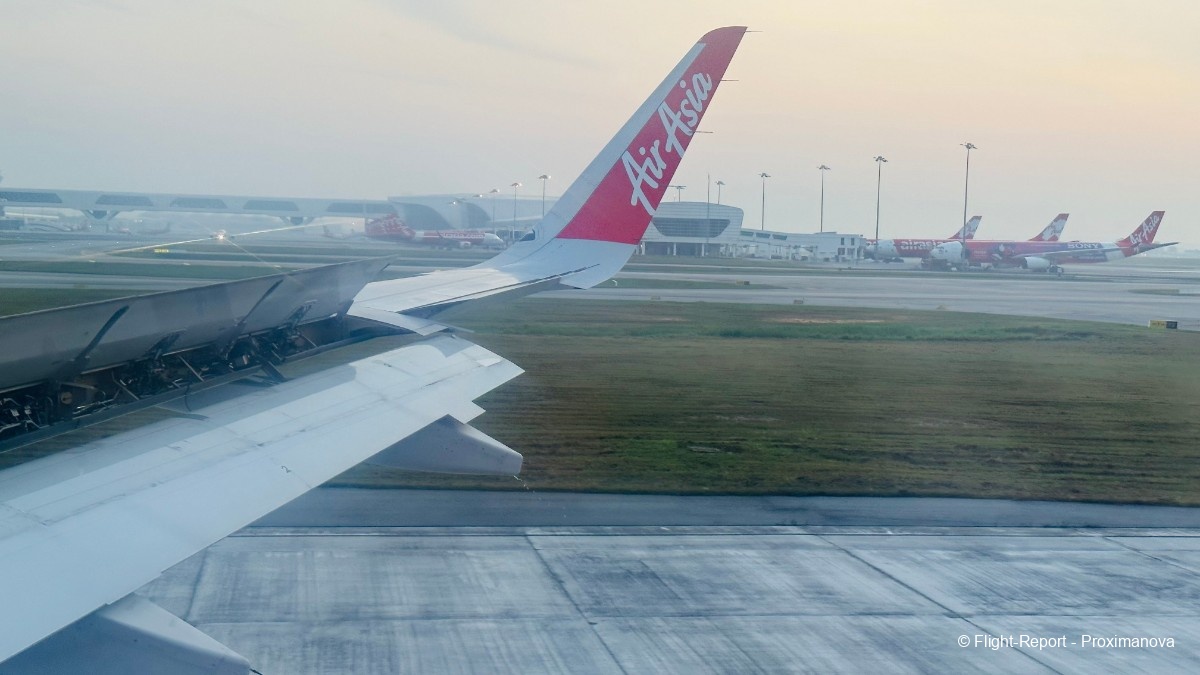
First off the blocks was a most interesting AirAsia X A330-300 (9M-XXJ, named ‘Harmonious DiverXity’) parked in the distance, painted in a livery endorsing Sony noise-cancelling headphones that are, or used to be, offered on AirAsia X flights. As with all AirAsia X A330s, this bird had to sit for the past couple of years in storage — both here at KUL and in Europe — and it was only on 15 January 2023, the same day as the Yeti Airlines disaster, that she could fly again.
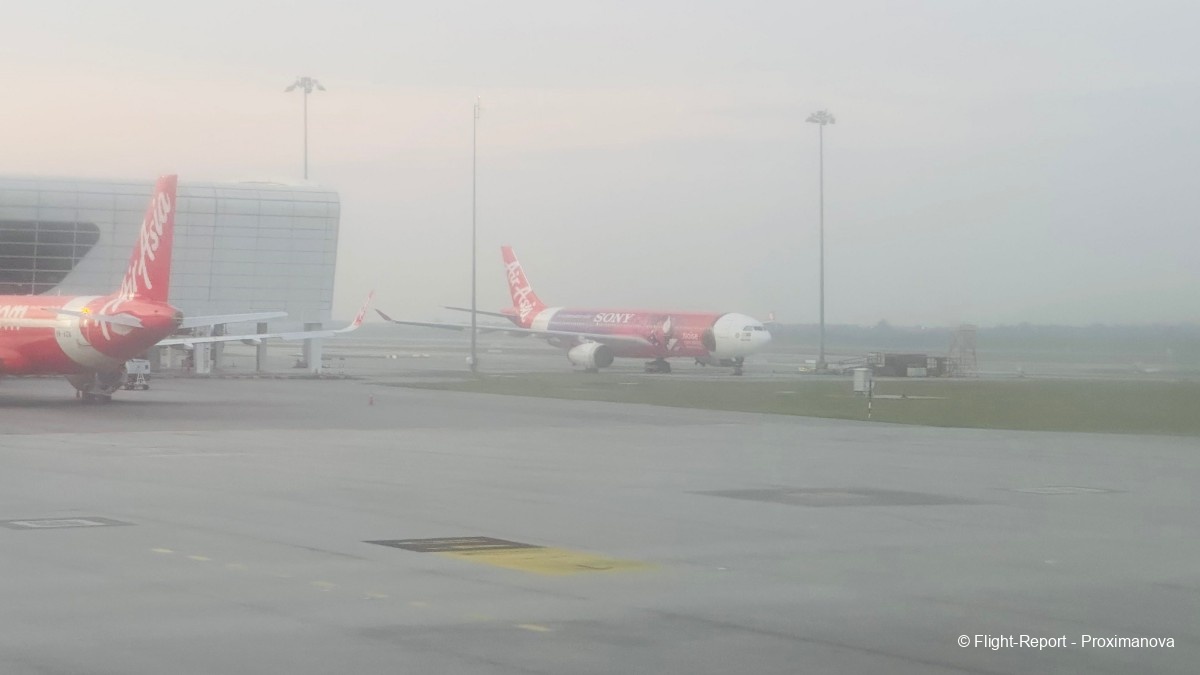
Next up was 9M-AHR in ‘Thank You Sabah’ colours, which has been parked since late 2020.
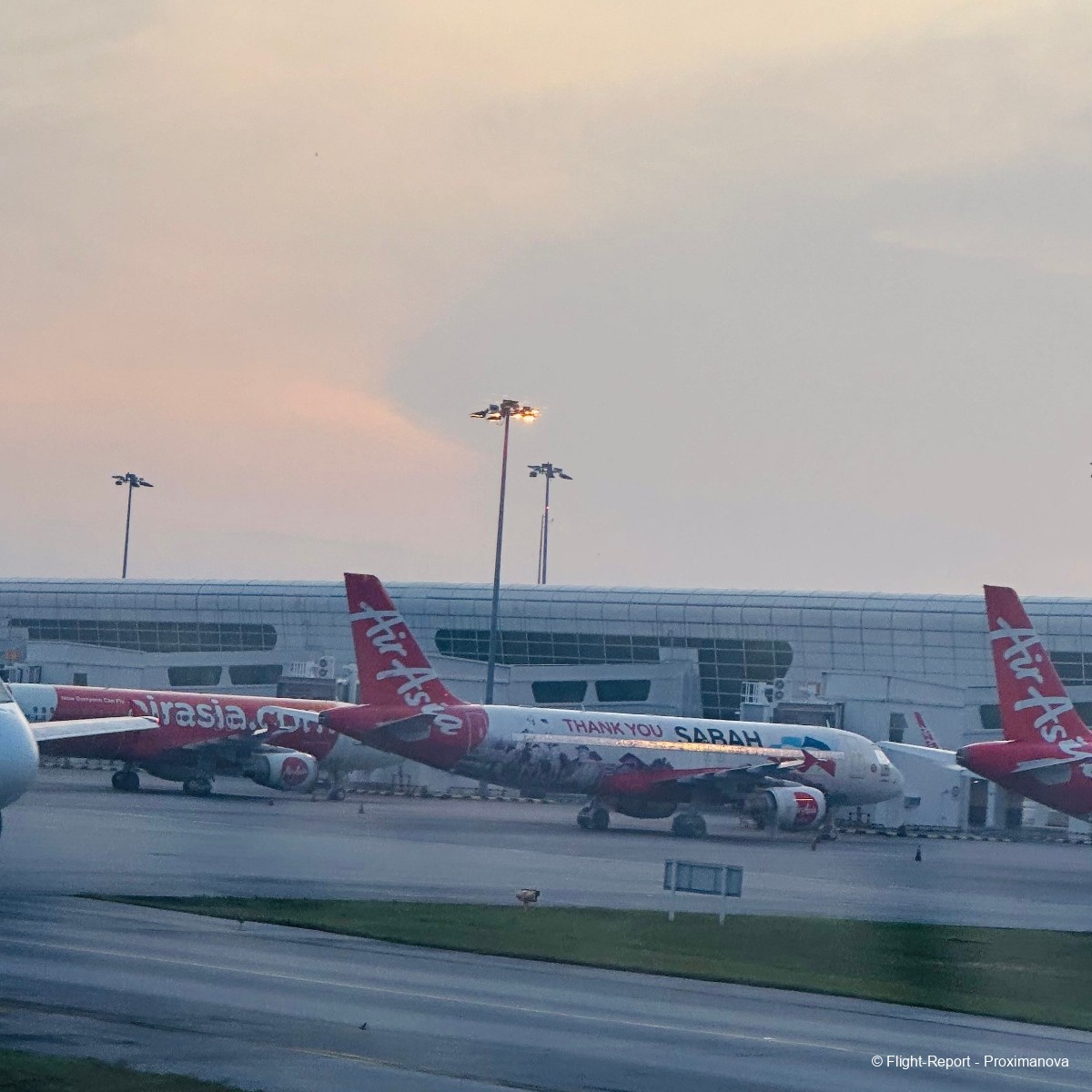
Now 9M-AHE in the ‘Jannine’ livery took off as AK403, bound for Padang (PDG) in Indonesia — a city with the same name as the iconic ground in Singapore where it declared its independence, and where the National Day celebrations returned on 9 August 2023 after years at The Float @ Marina Bay.
In her fifteen years at the airline since 2007, this aircraft has featured no fewer than three special schemes: first, for TuneTalk mobile prepaid (2013–2016); second, for Honghe Nativeland (2016–2020), one of several Chinese-targeted liveries at AirAsia; and now for the Thai musician Jannine Weigel, born in July 2000 — a few months younger than me — who has made it big with RedRecords, a joint venture between the AirAsia group and Universal Music Group. She is lucky to have herself plastered on an aircraft at that young an age, something that only happens in East Asia.
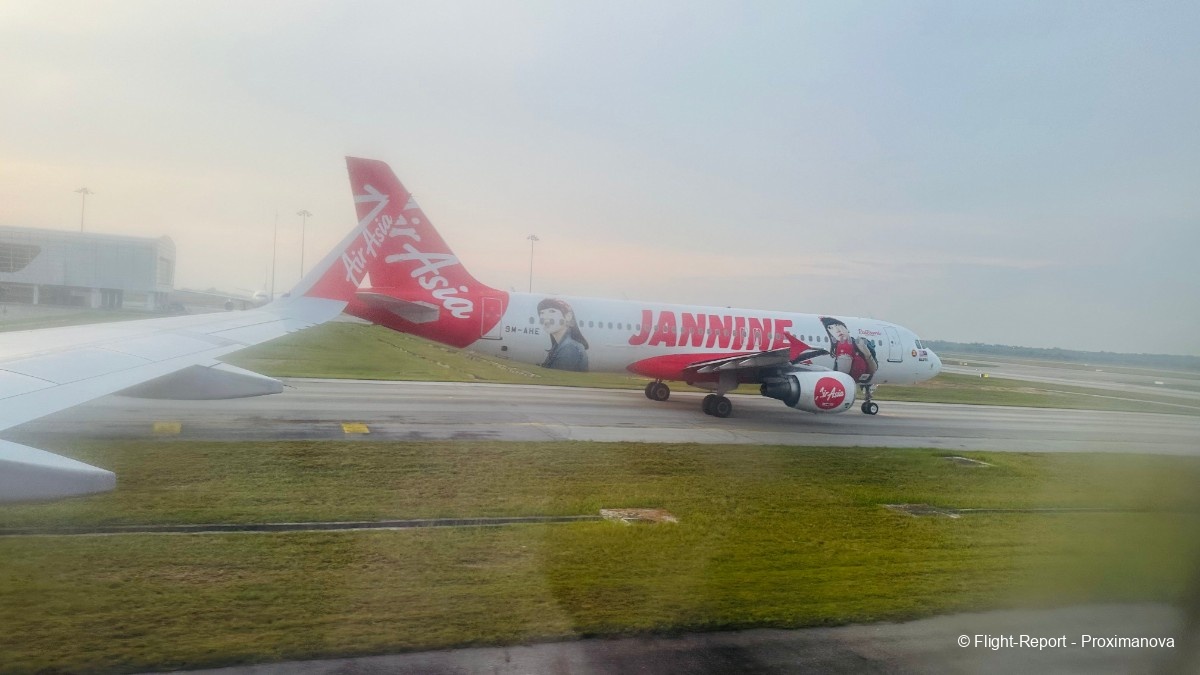
The next bunch of special liveries were as follows, each making AirAsia that much more of a colourful airline, and KLIA that much more special of an airport.
• Top left: 9M-AJS in ‘Let’s Fly to Terengganu’ livery.
• Top right: 9M-AFV in ‘Legends Hero Park Macau’ livery. I could only see the right side, which has only Chinese text; the left side has English.
• Bottom left and right: 9M-AQM in De’Xandra colours. I will upload better pictures of this plane in the next report when I got close to her.
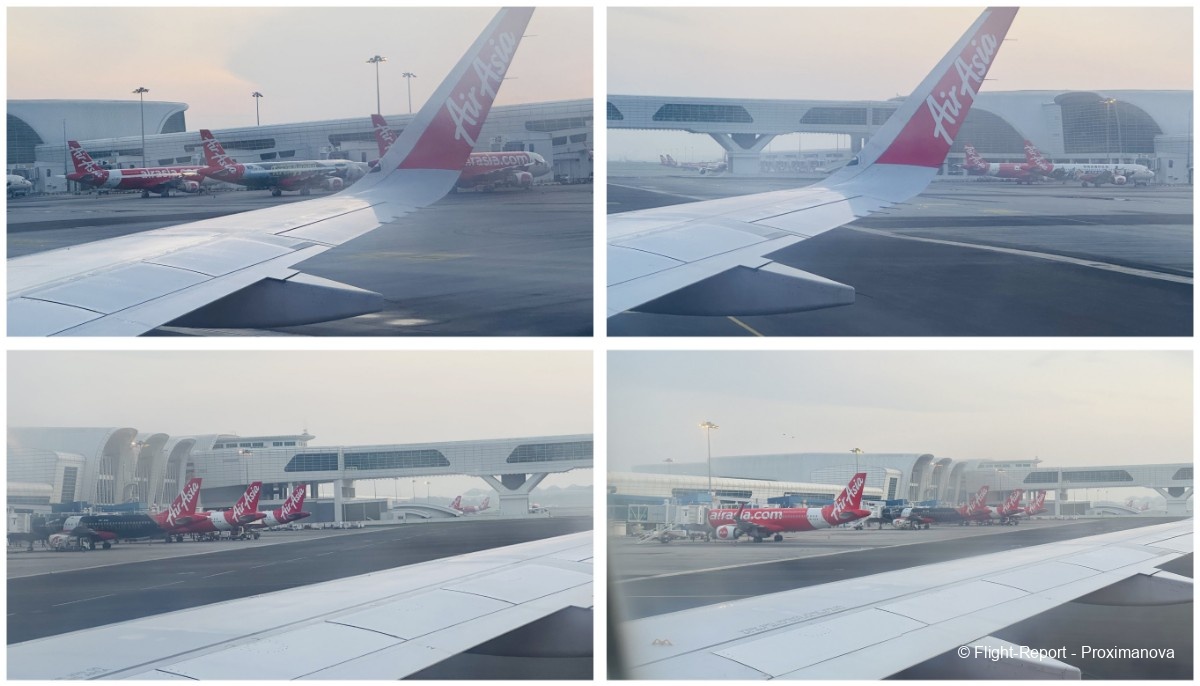
Early-morning Flightradar24 tracking
No sooner could I connect to the Maxis network than I activated Singtel’s roaming plan, which I then used to the fullest to contact family and also track the arrivals at KLIA on Flightradar24.
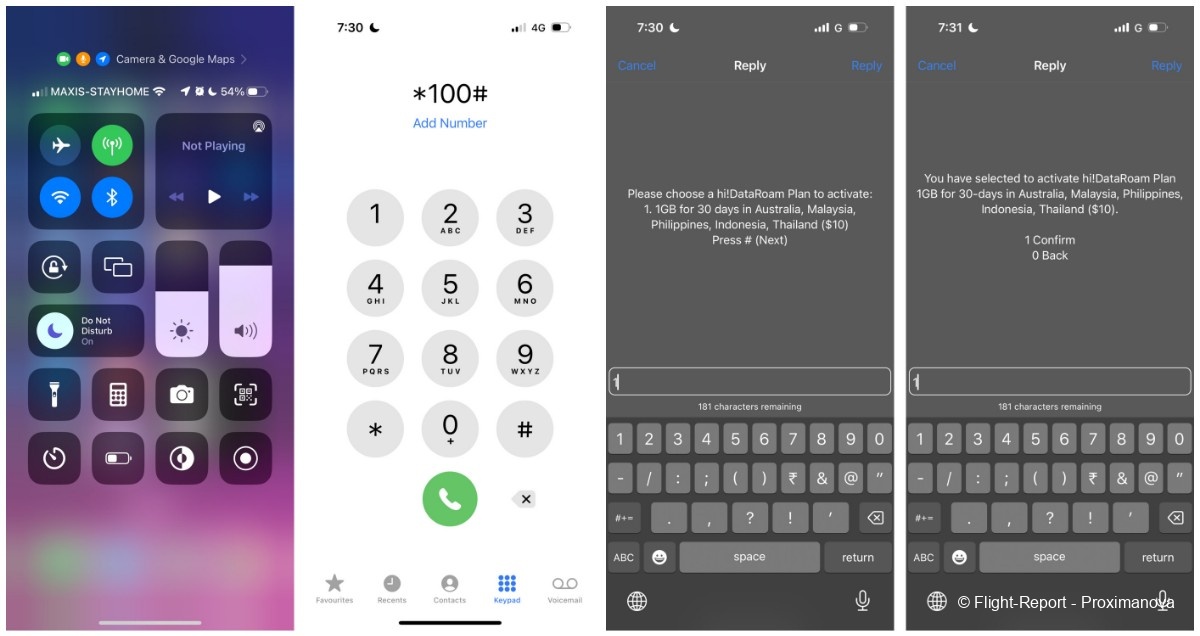
Here were some of the arriving aircraft, including 9M-MLT as MH193 from Bengaluru; the one following us from Hyderabad was 9M-MXX as MH199. And then the same 9M-RAV that would now take me to Singapore, landing as AK6052 from Johor Bahru. In order not to bore non-avgeeks, I have placed all the other Flightradar24 pictures in the Travelling Bonus section.
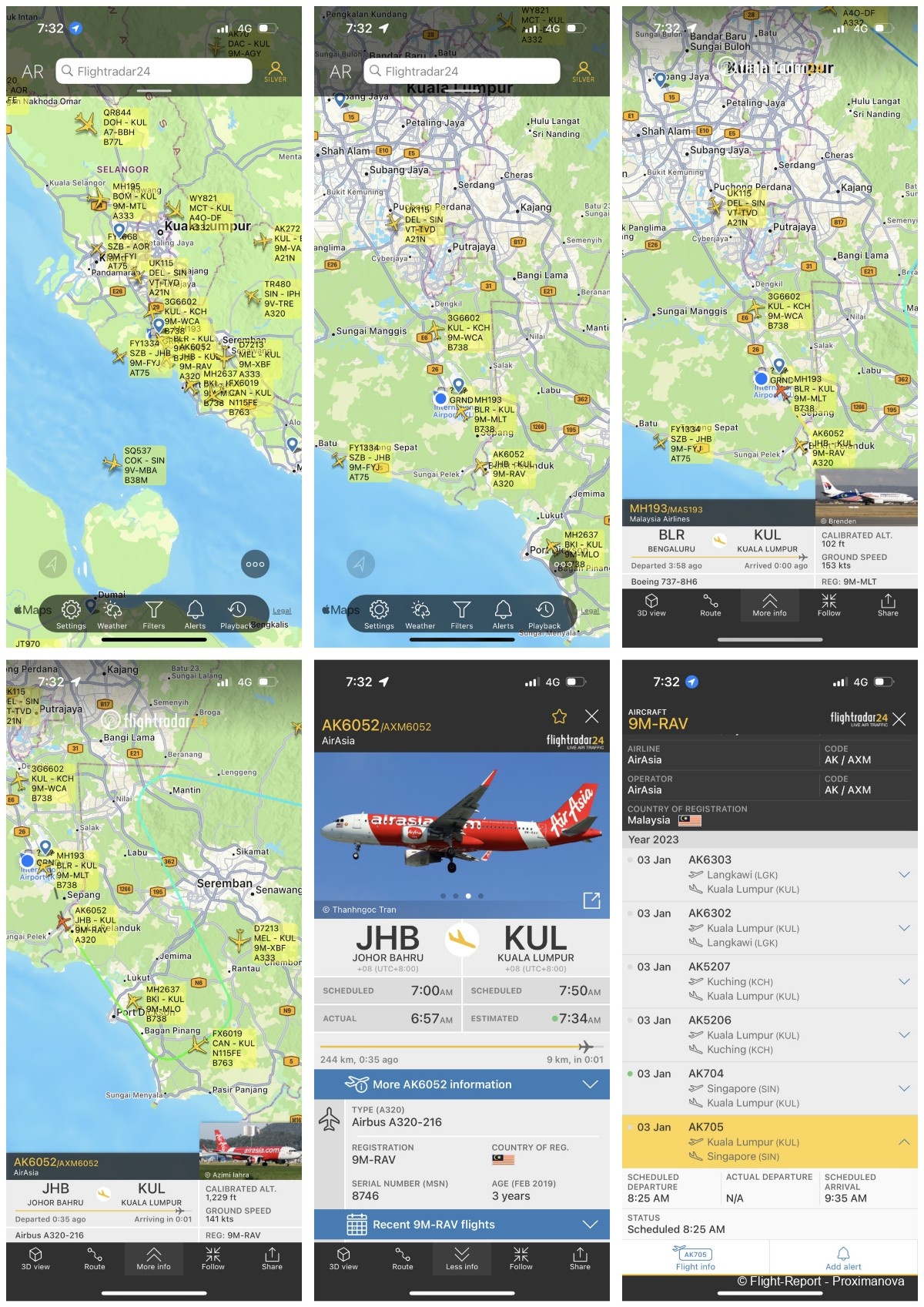
Now I was ready to step off the aircraft — being the last as (almost) always — and head straight for the door as the girls in red were not particularly interested in goodbyes, instead minding their own business.
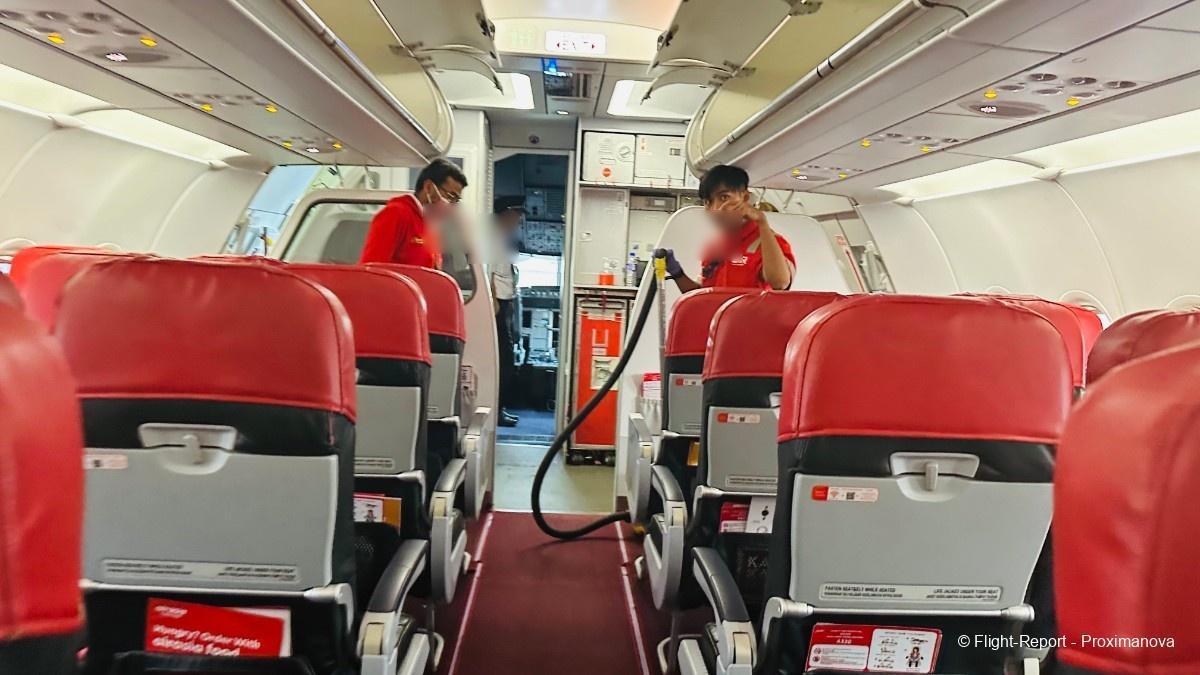
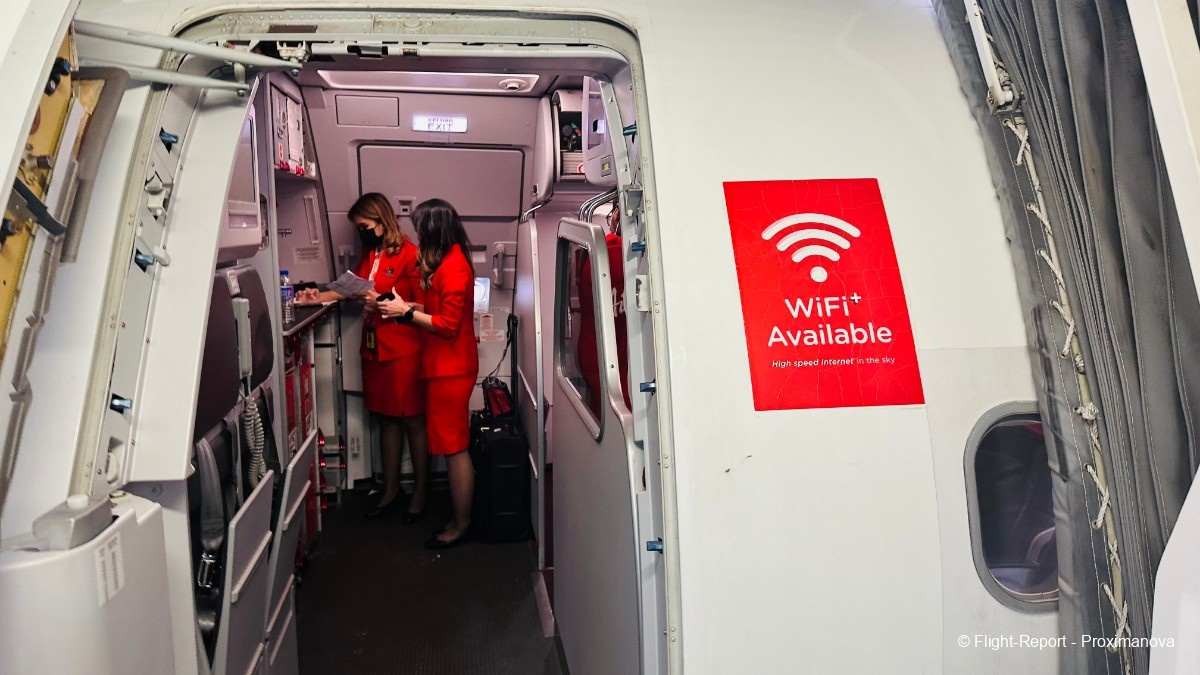
Now I was off the plane and into the jetbridge. Who said planes can’t have a sexy backside, especially with that little hump protruding on top?
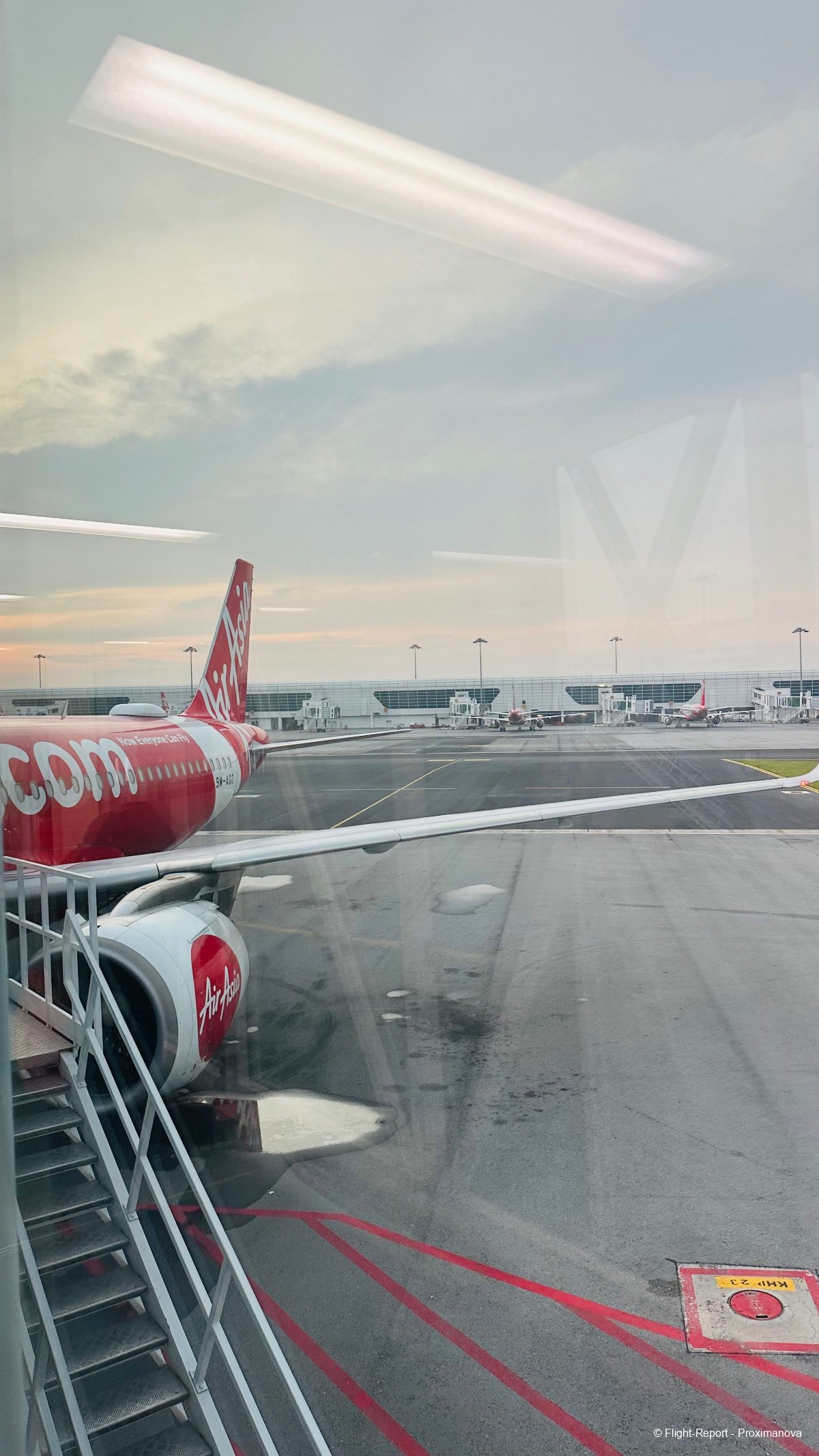
Here’s a look at 9M-AGO from the terminal building, with the ads for Celcom Axiata 4G on the outside of the jetbridge, similar to sister company Dialog Axiata at CMB.
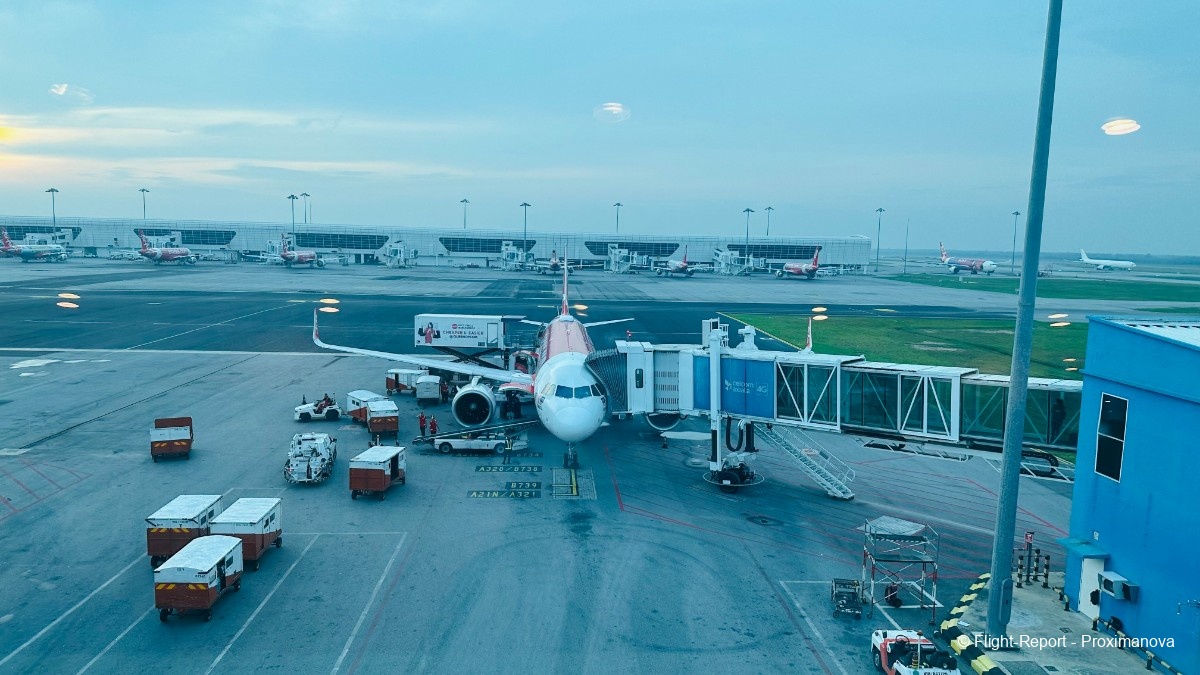
I’ll leave you with this shot of 9M-RAV, my next plane, with a slightly less sexy exterior (minus the hump) but a head-turner all the same. Other aircraft that I spotted on the breathless rush from gate to security to gate I will publish in the next instalment, which will be short like the flight itself.
